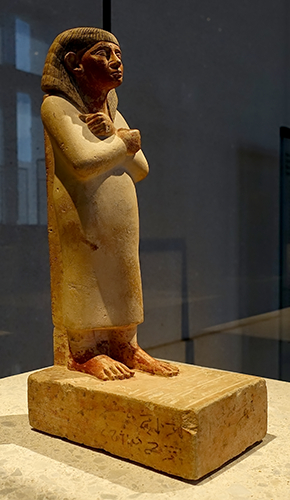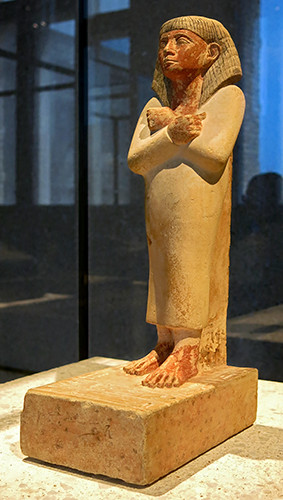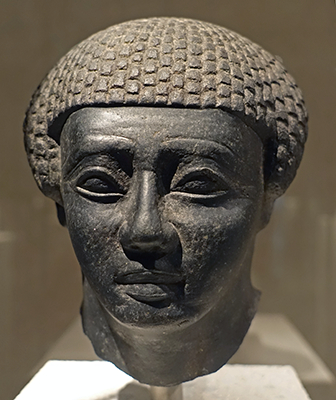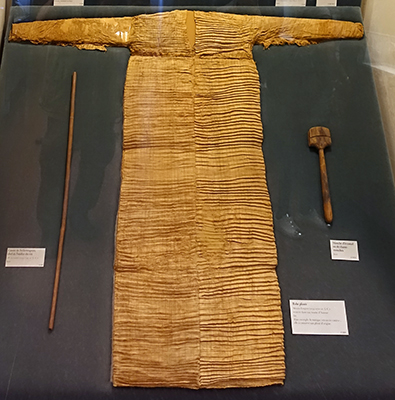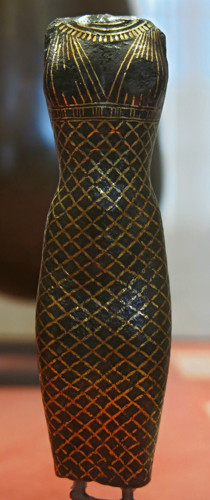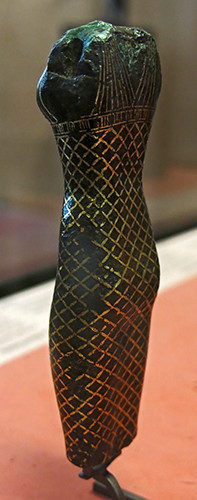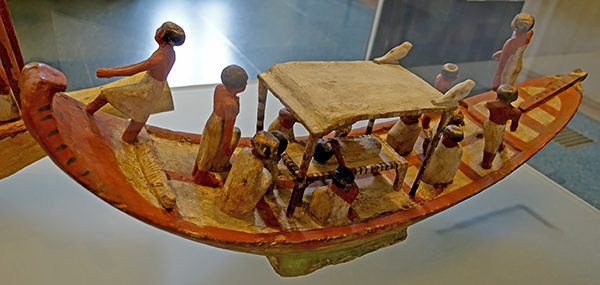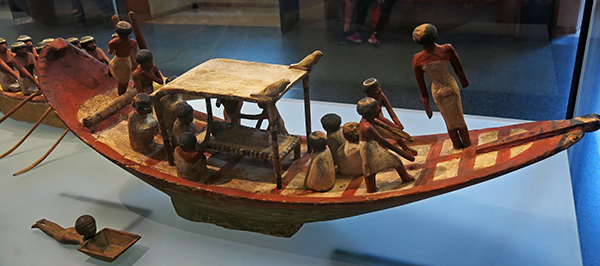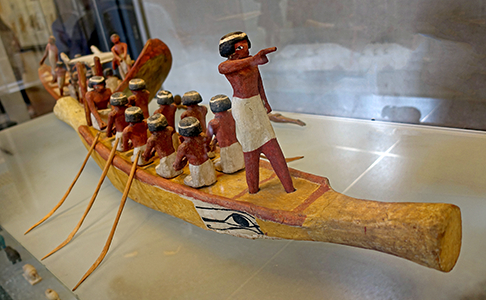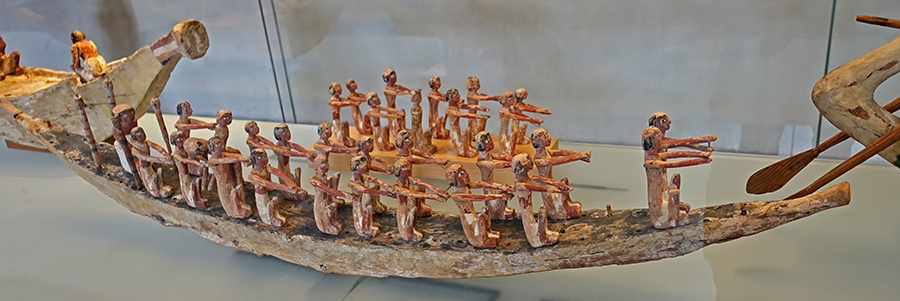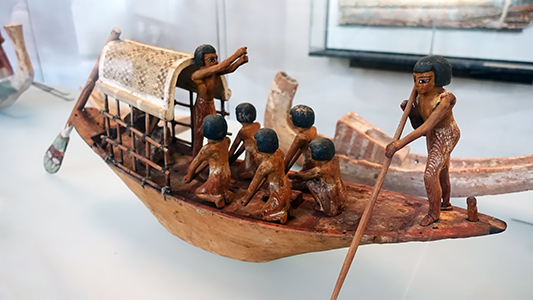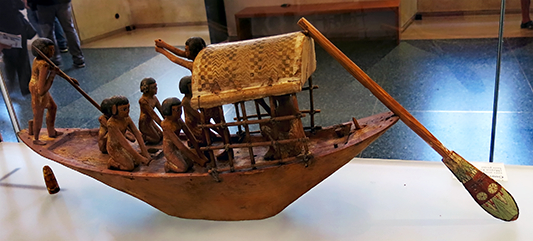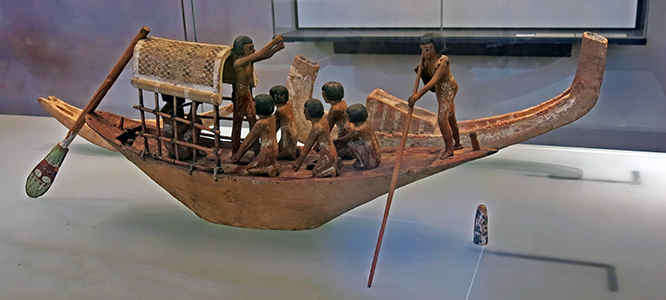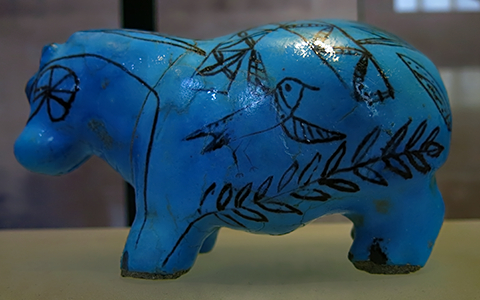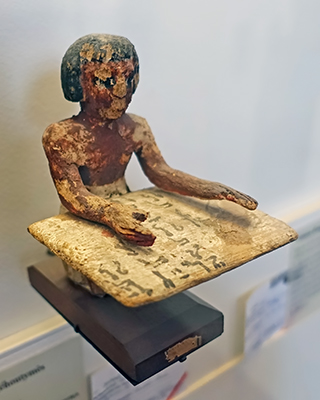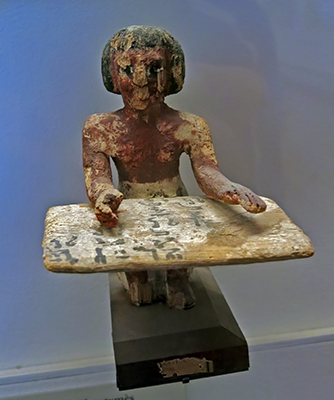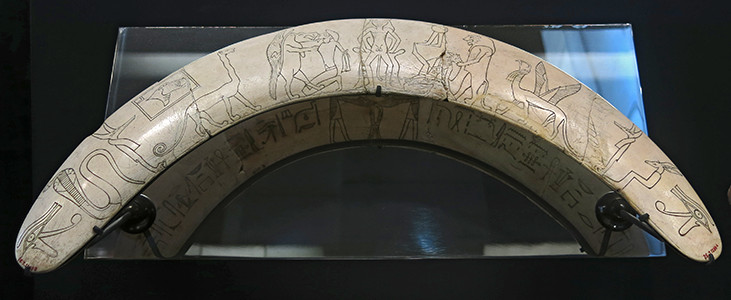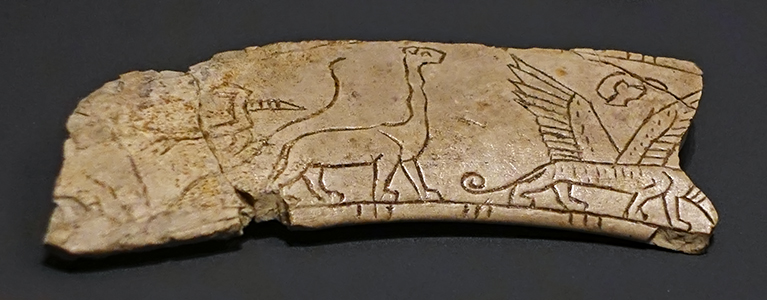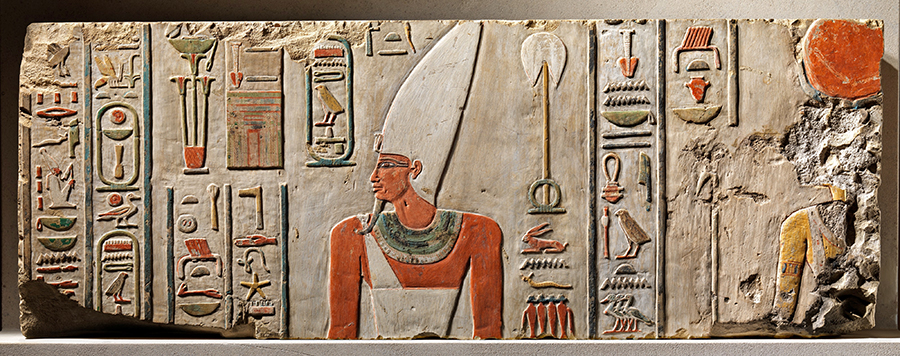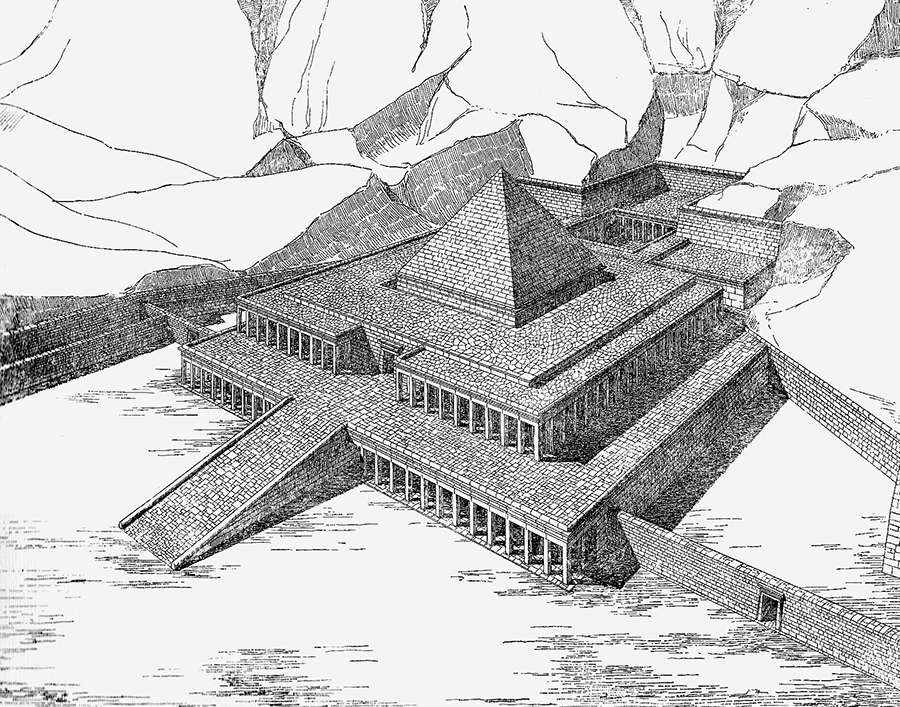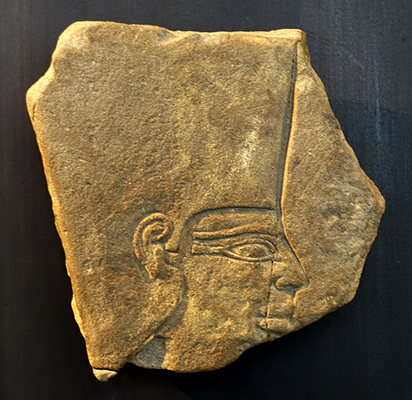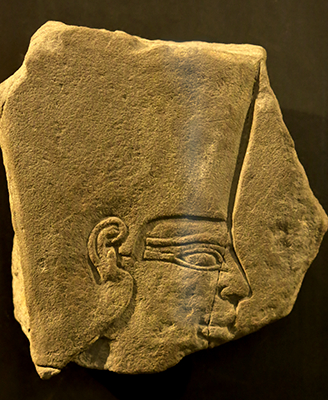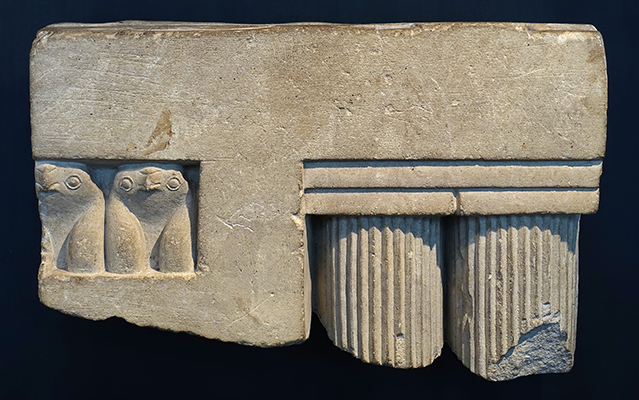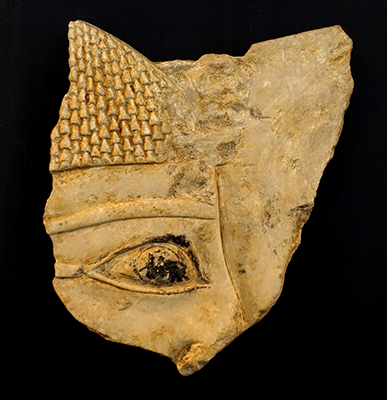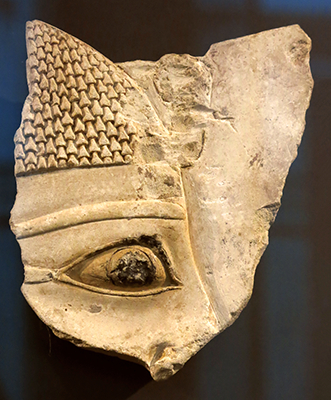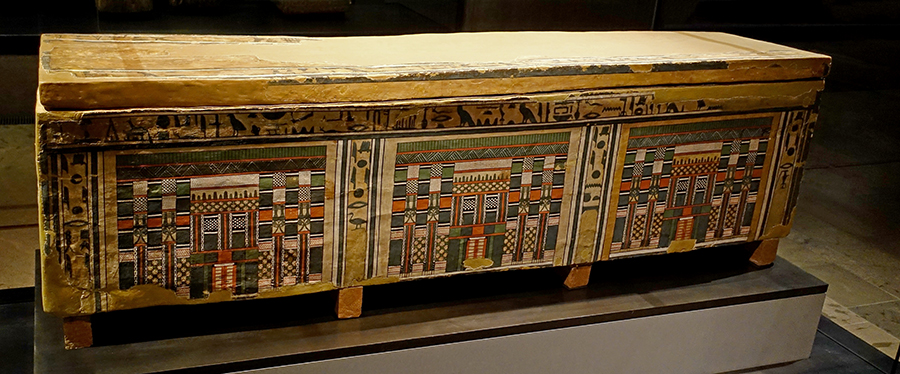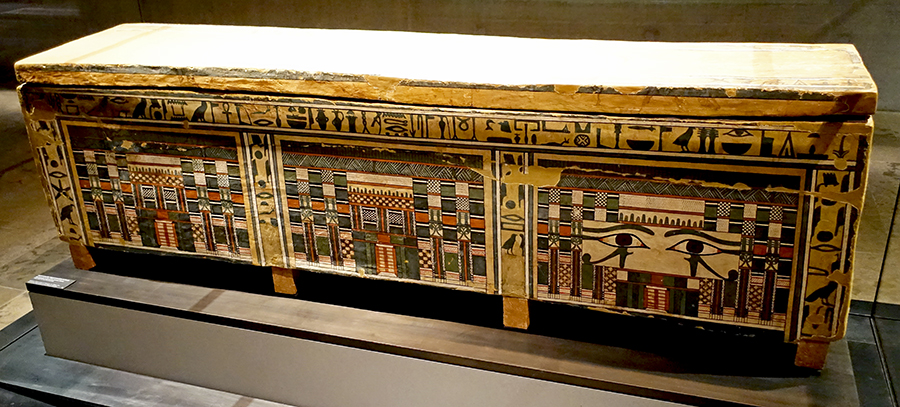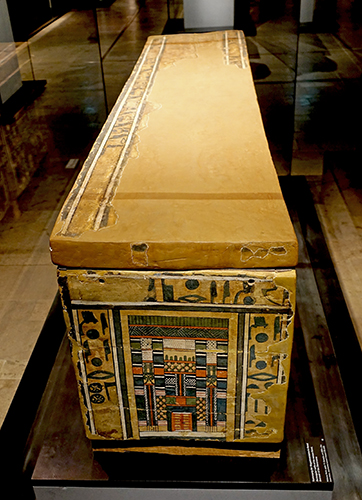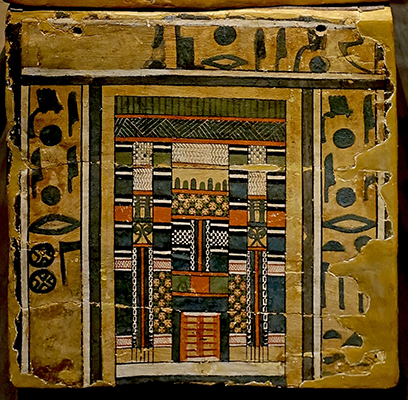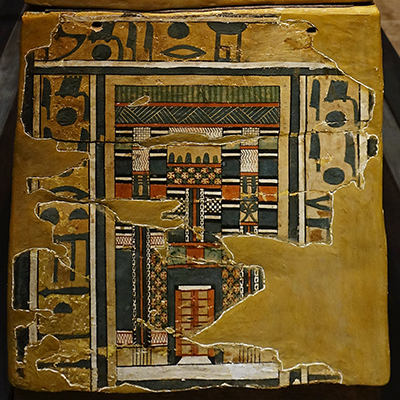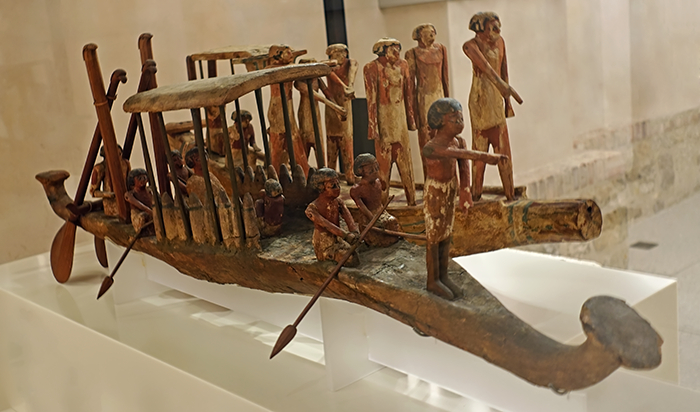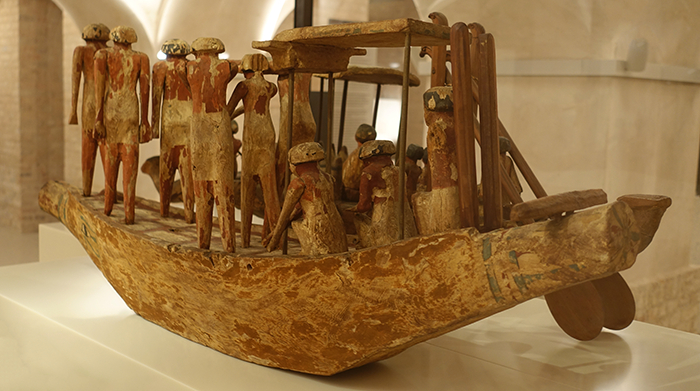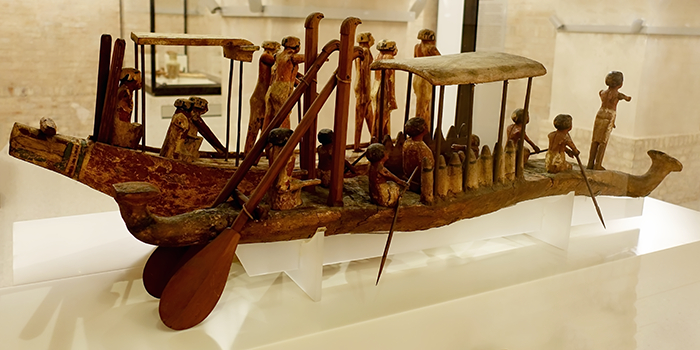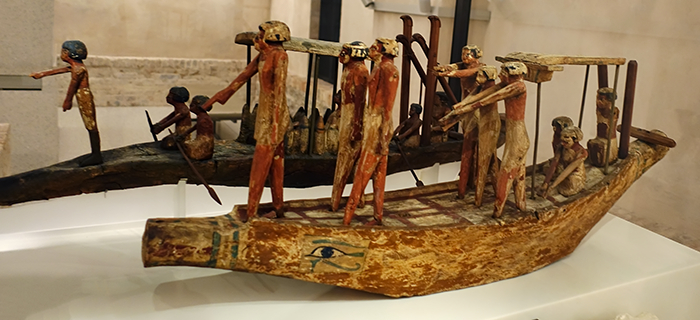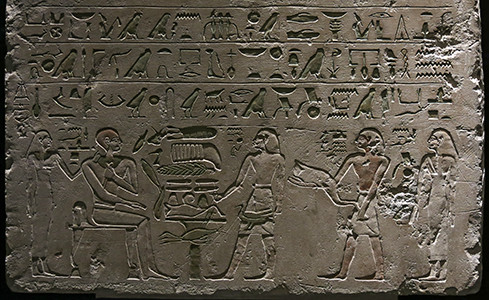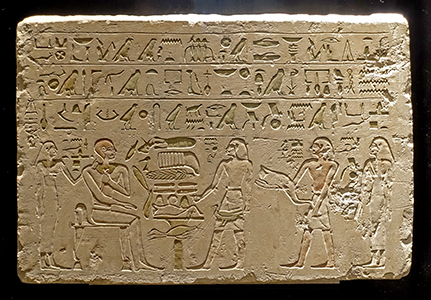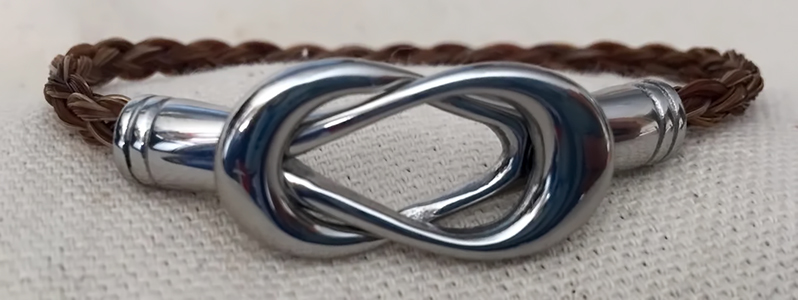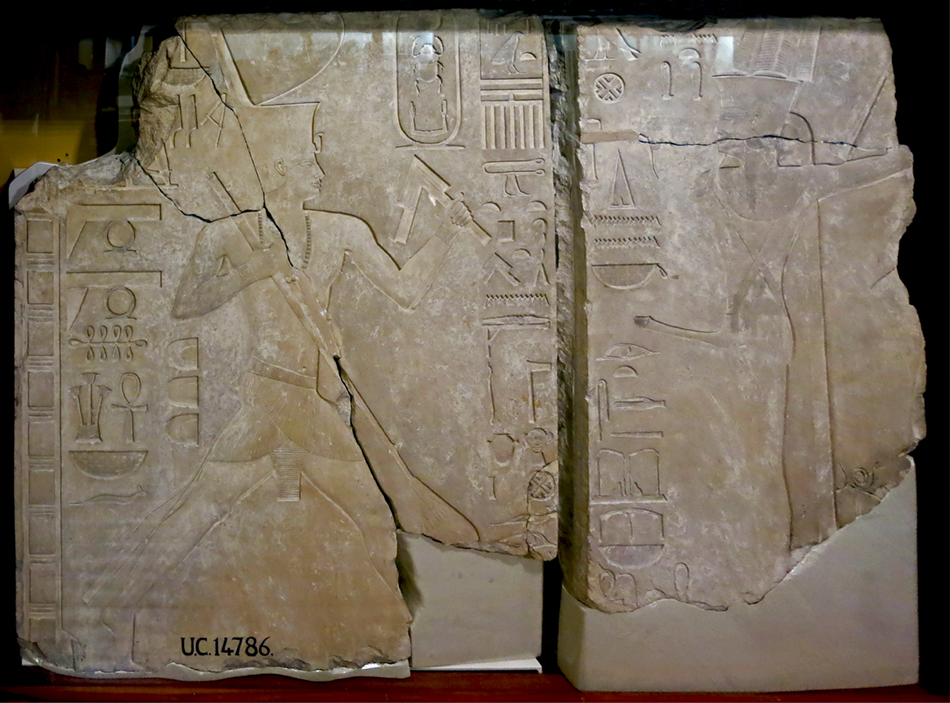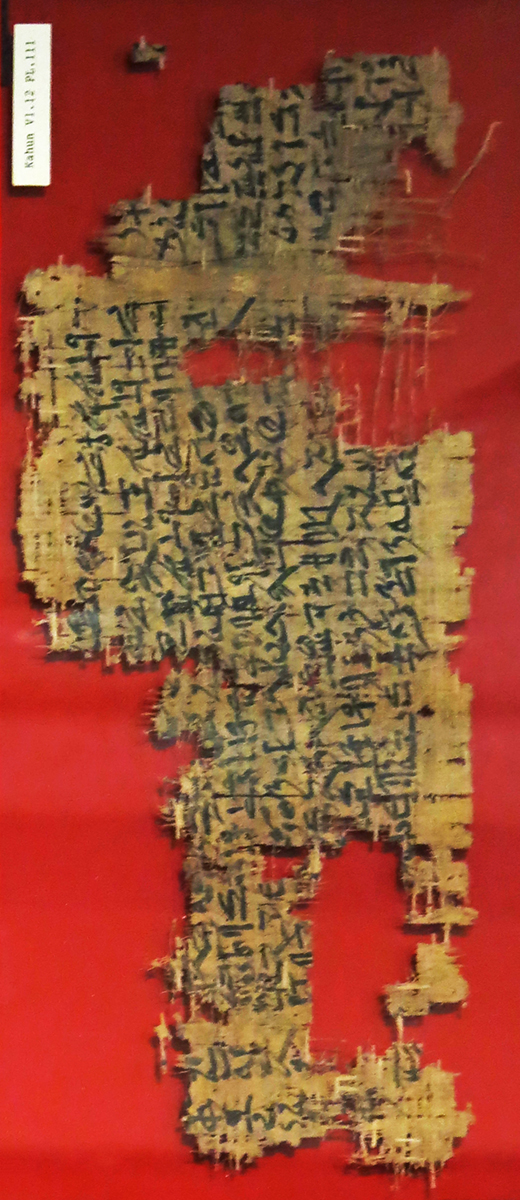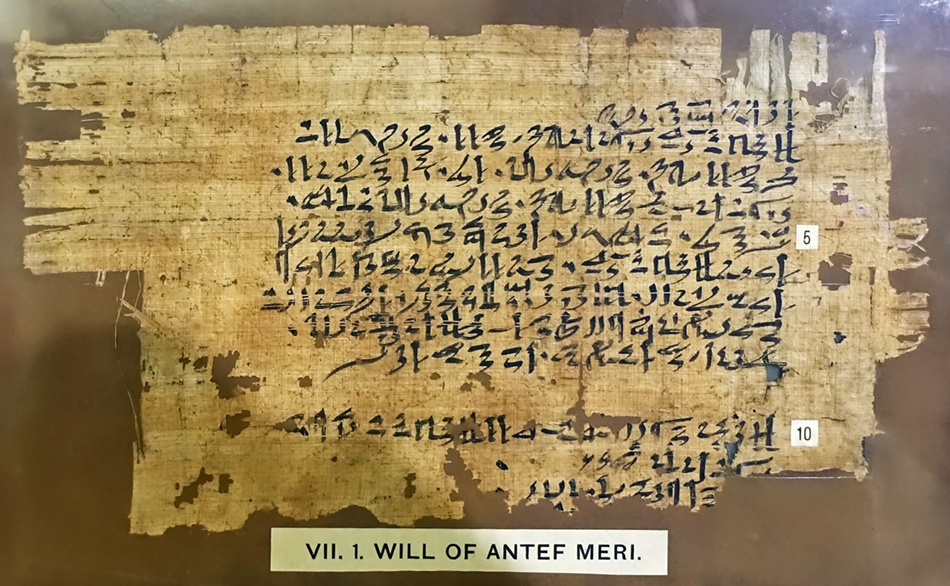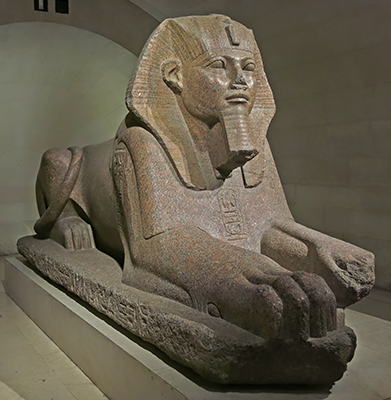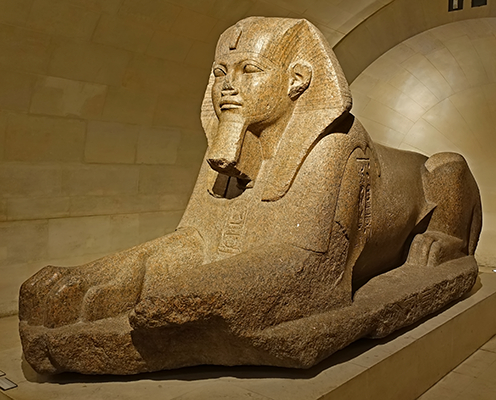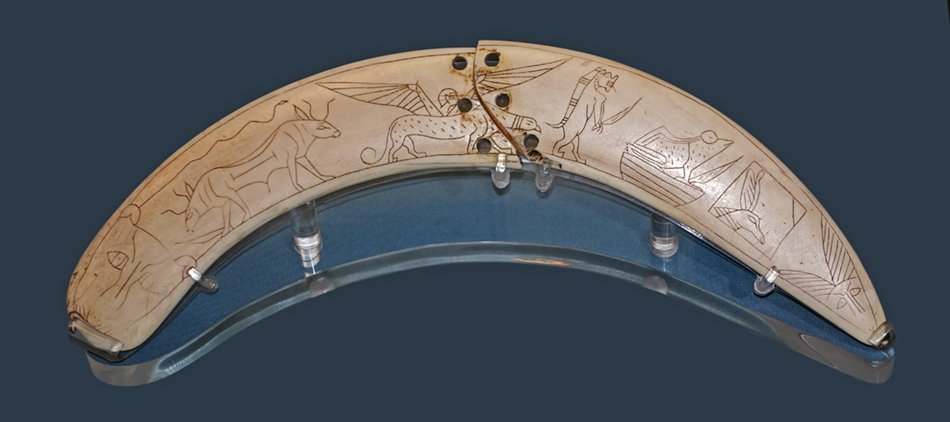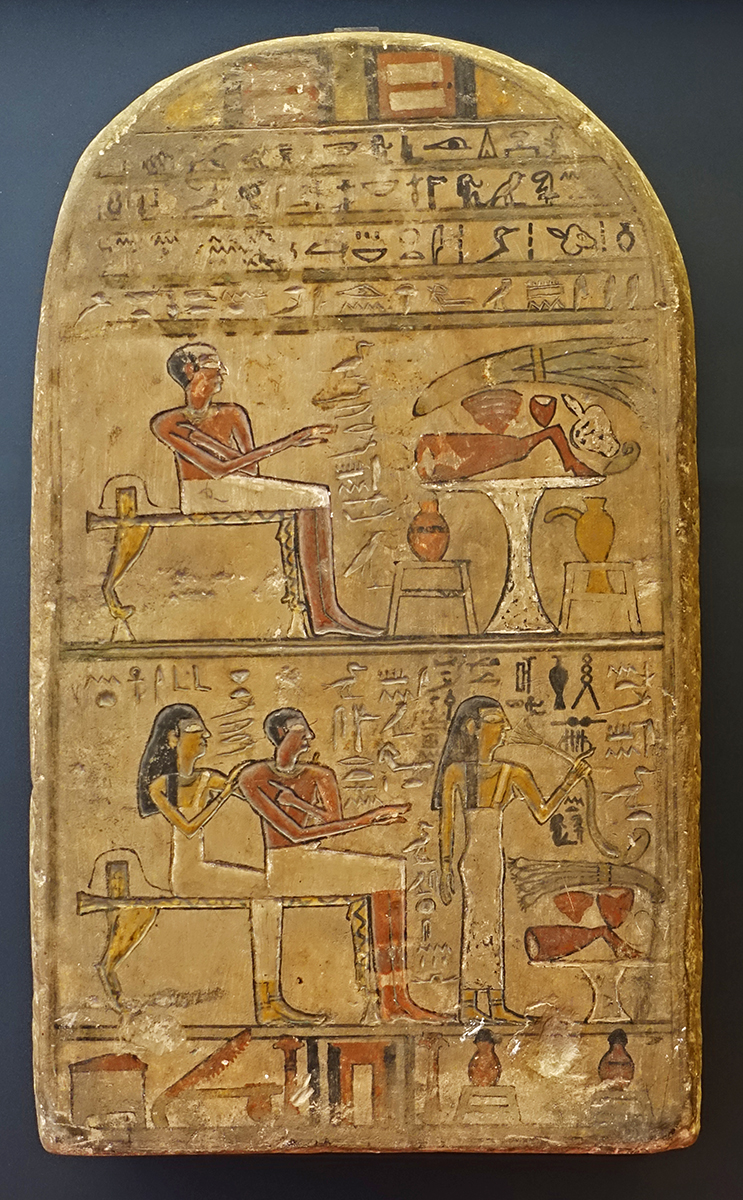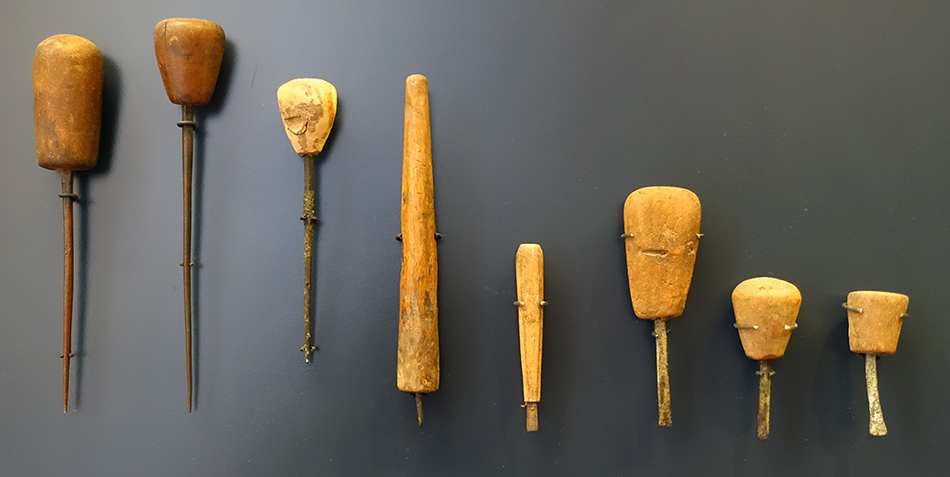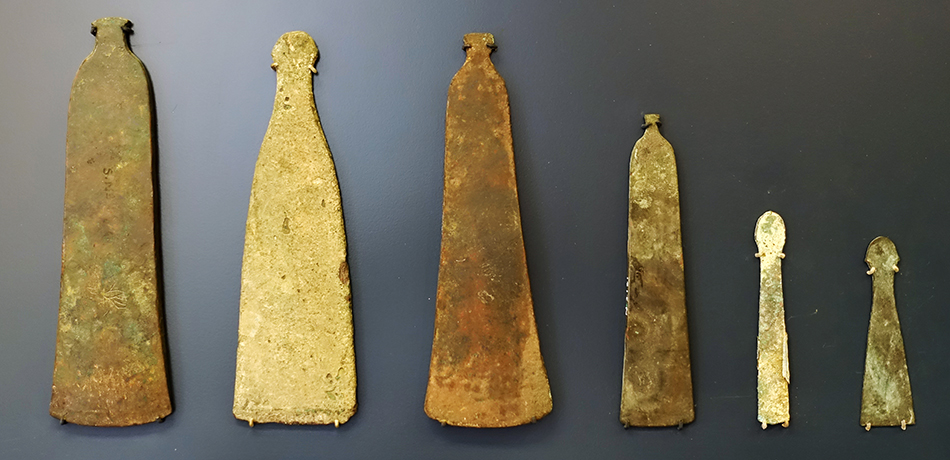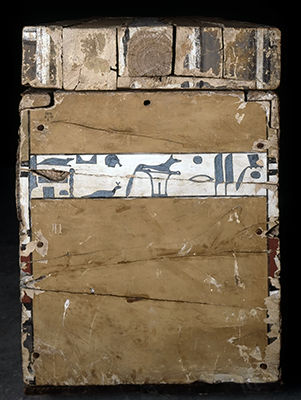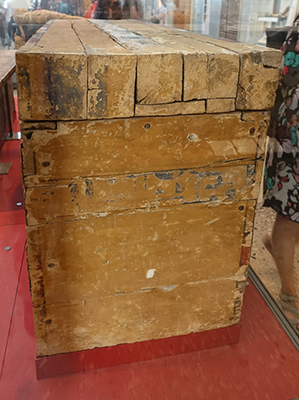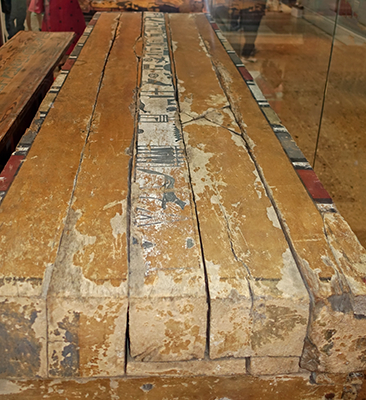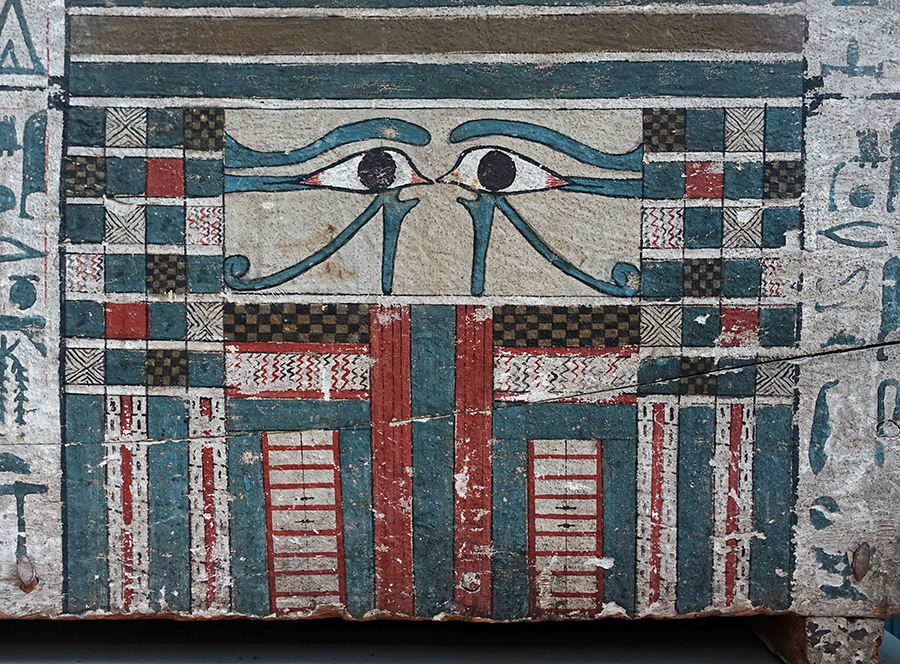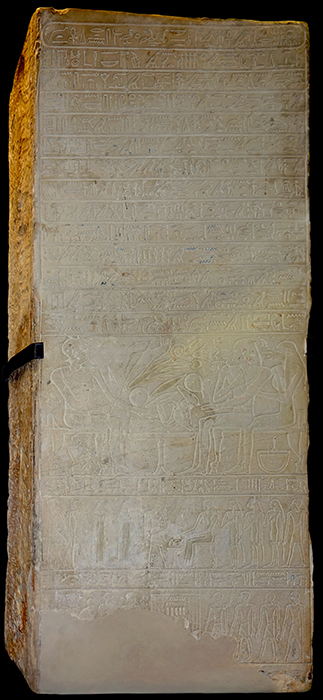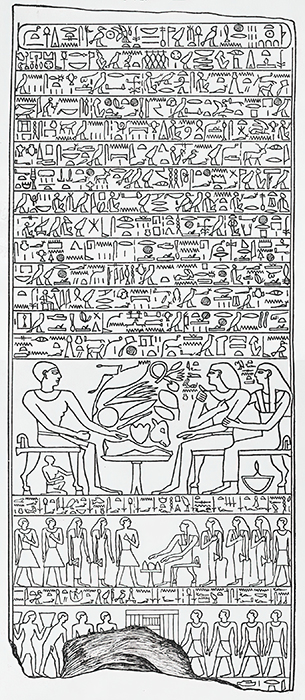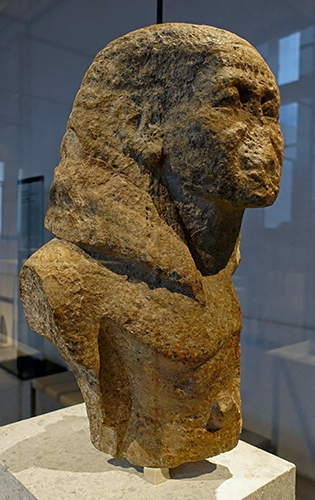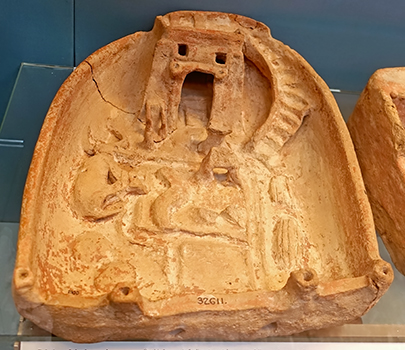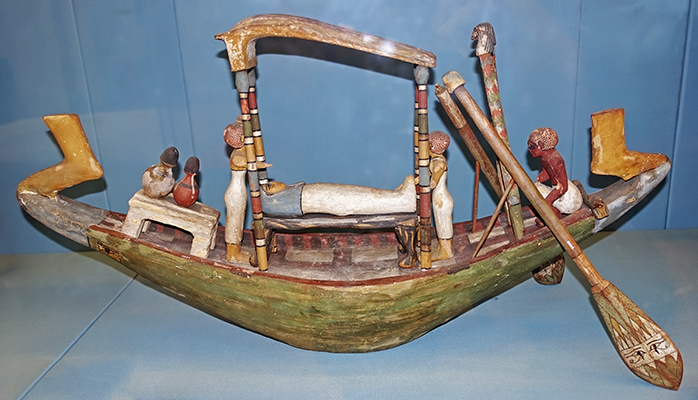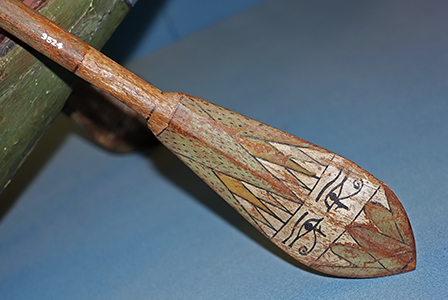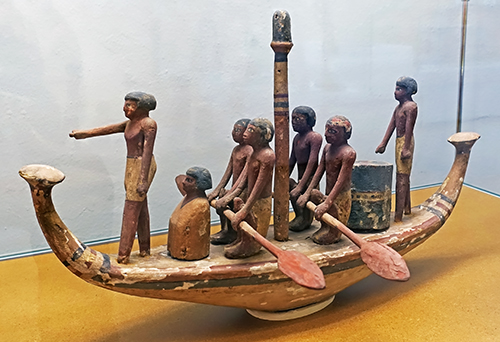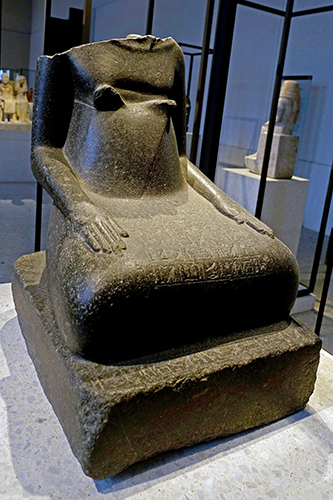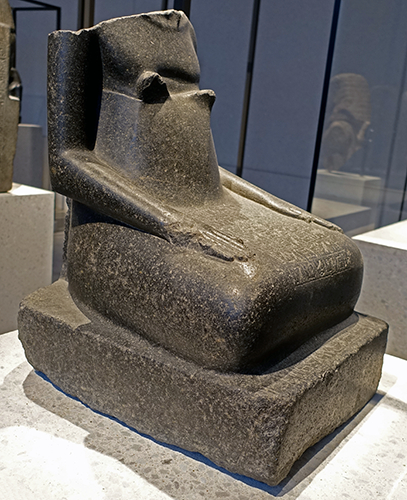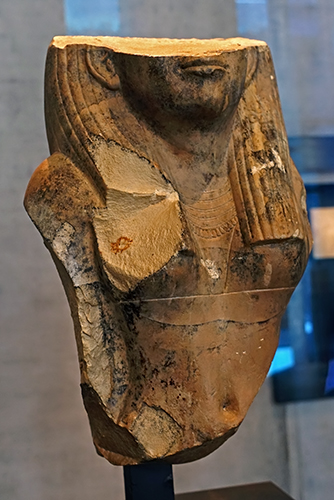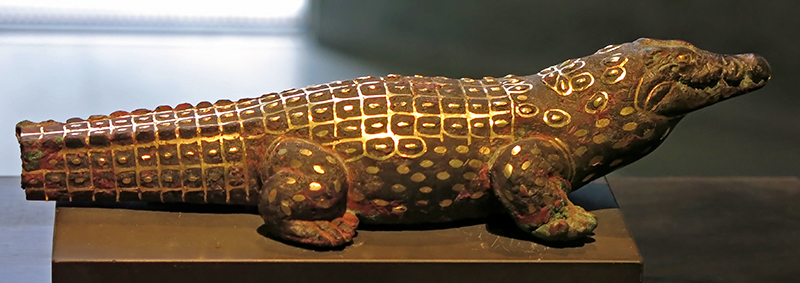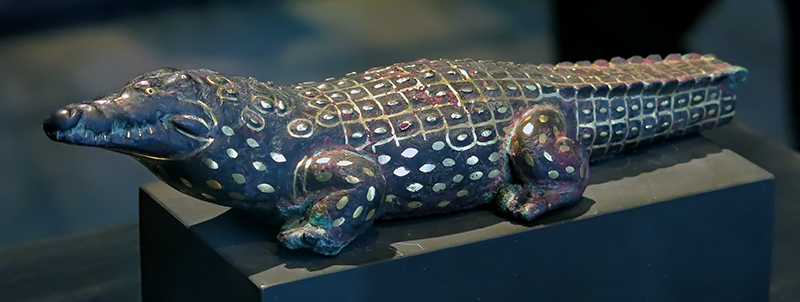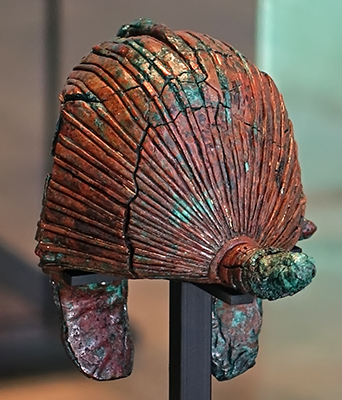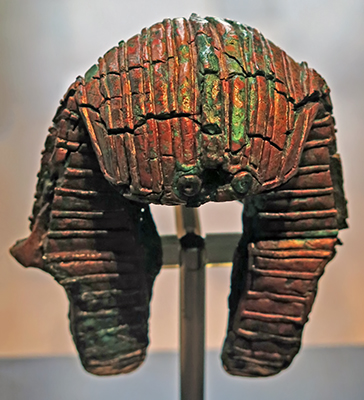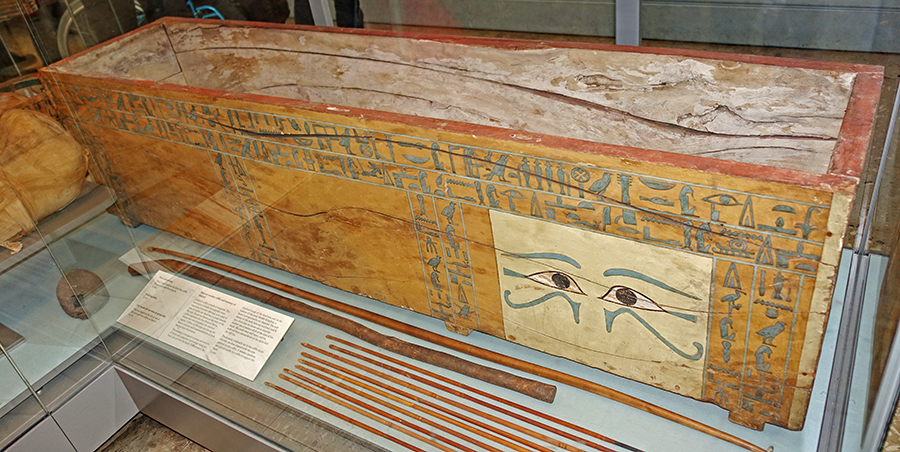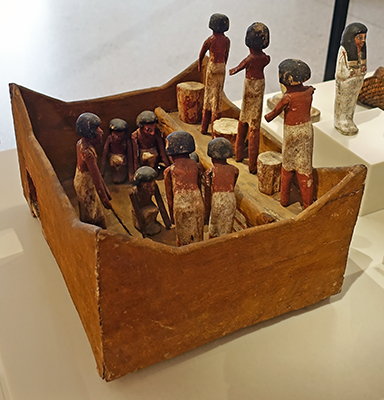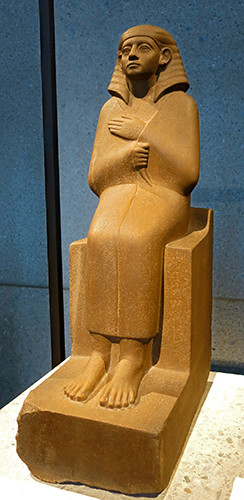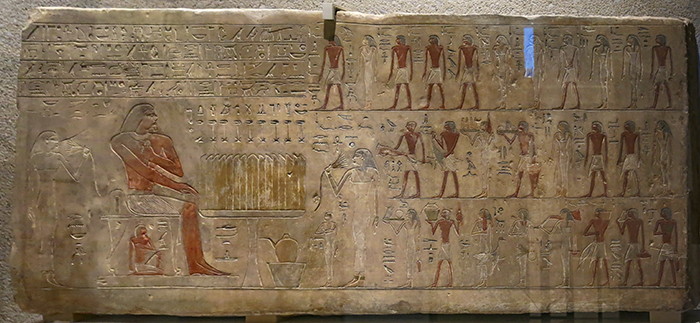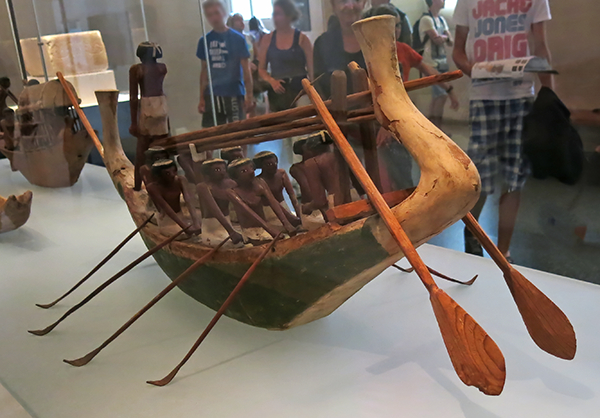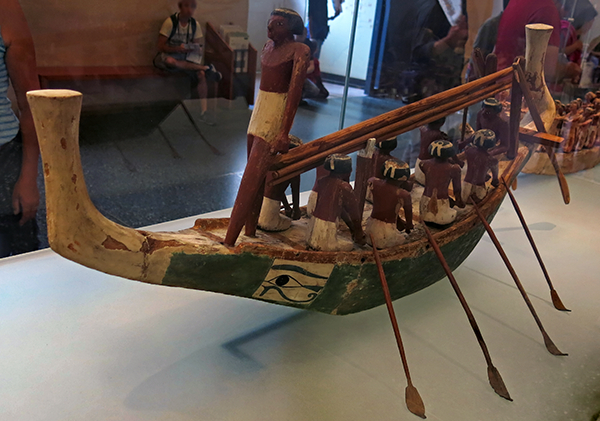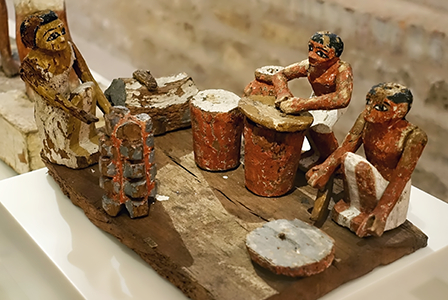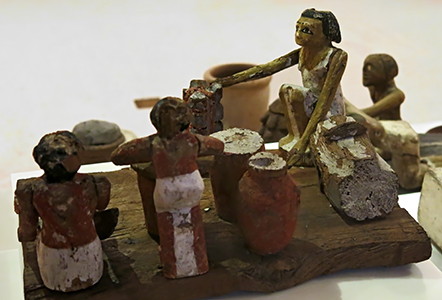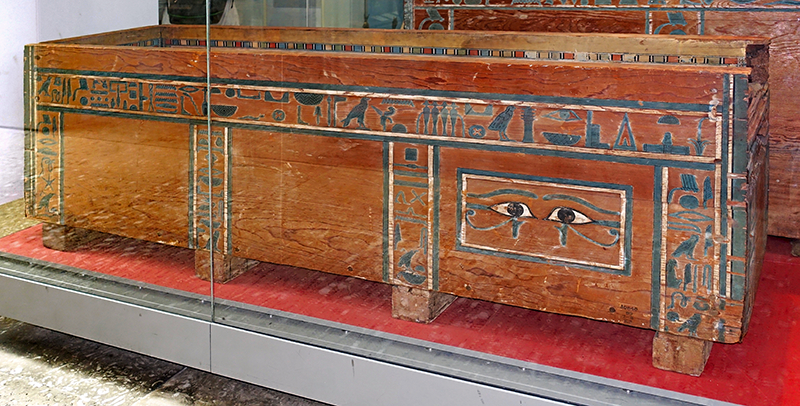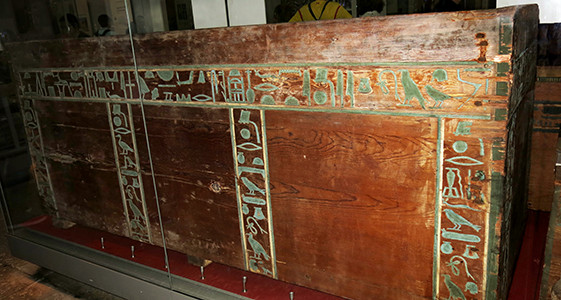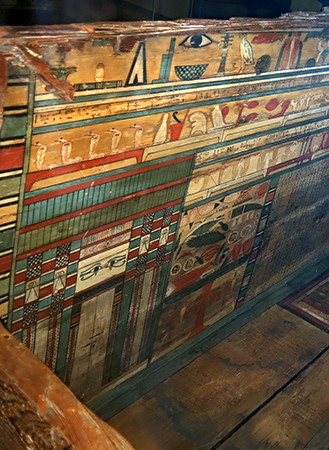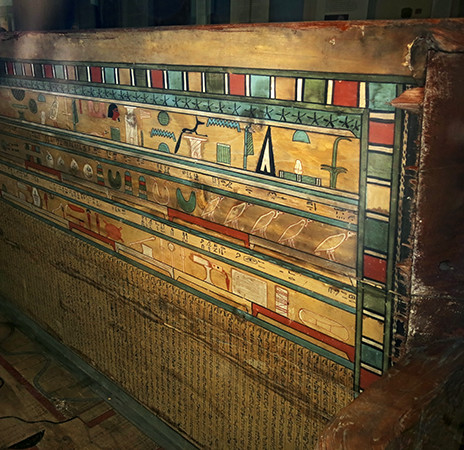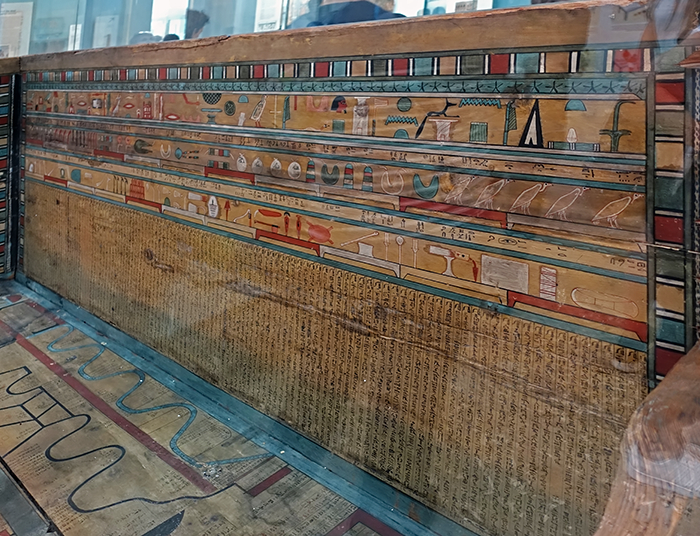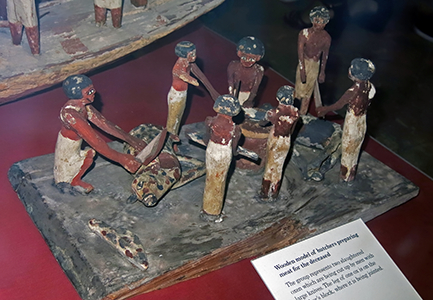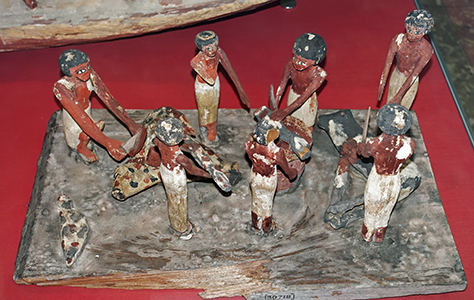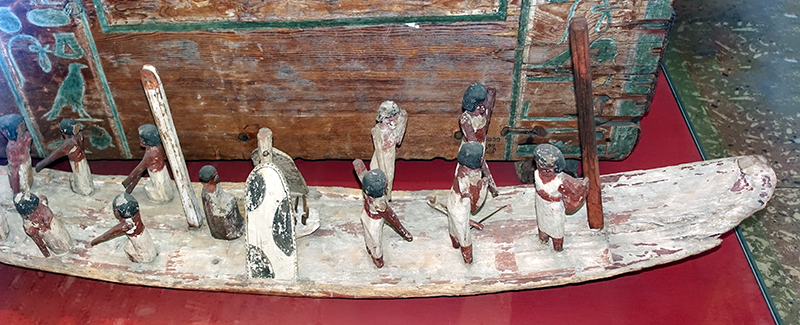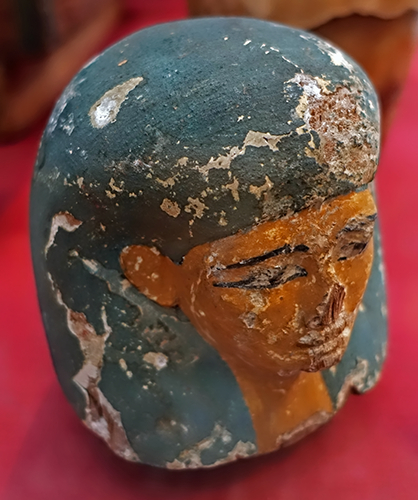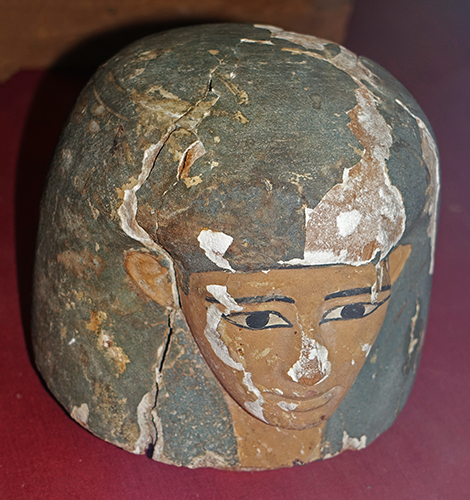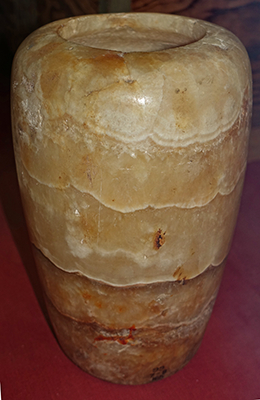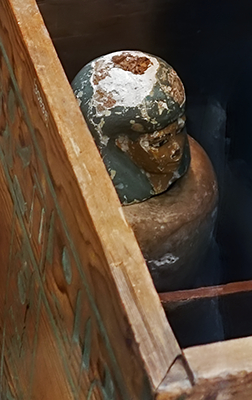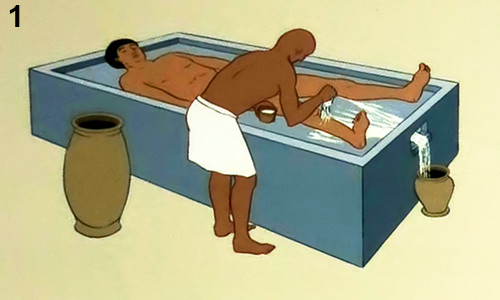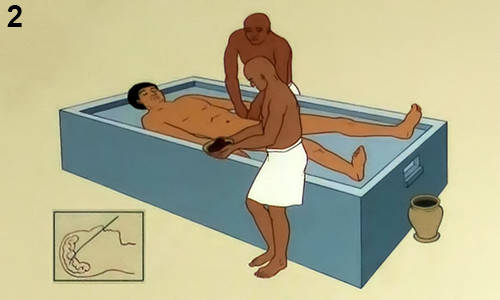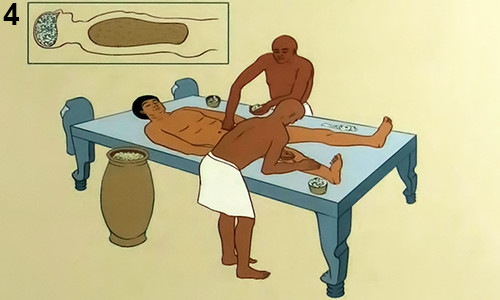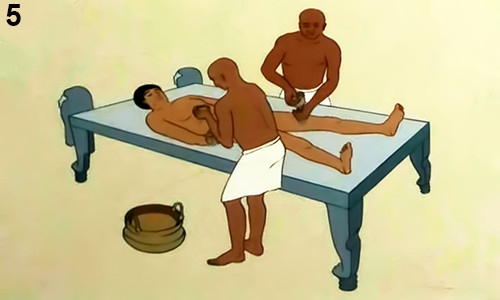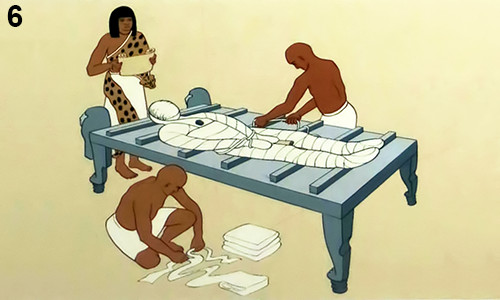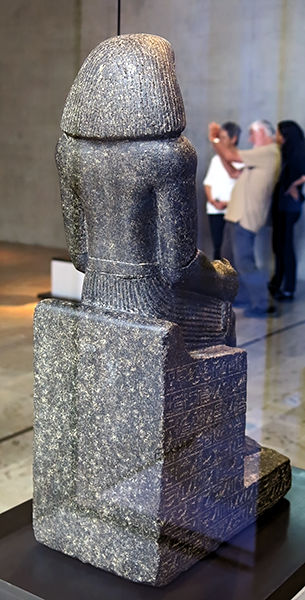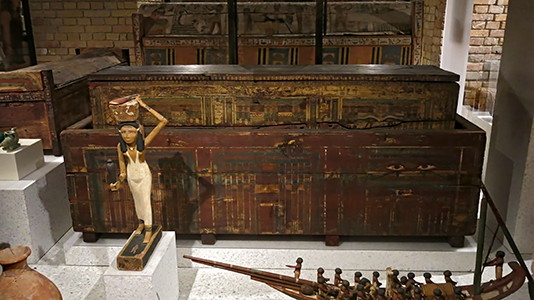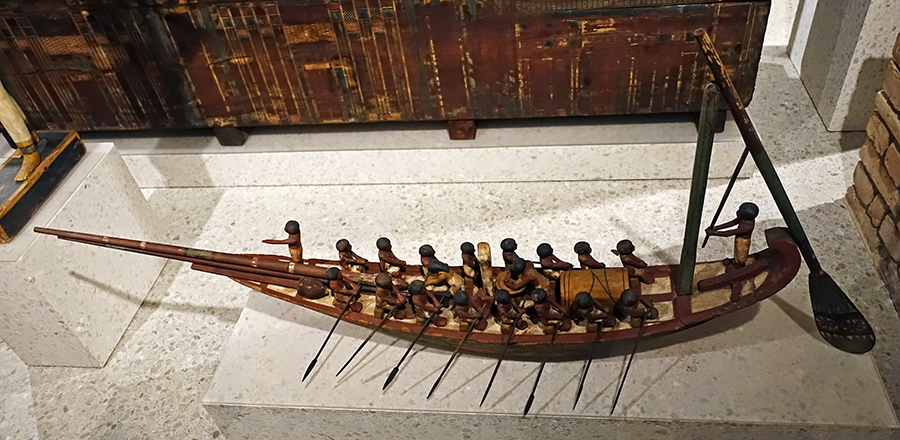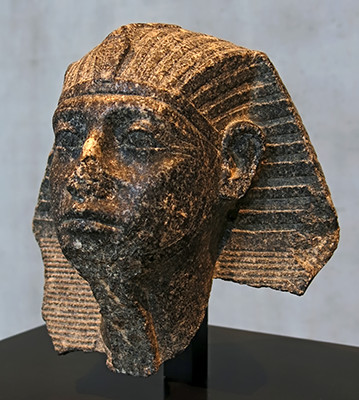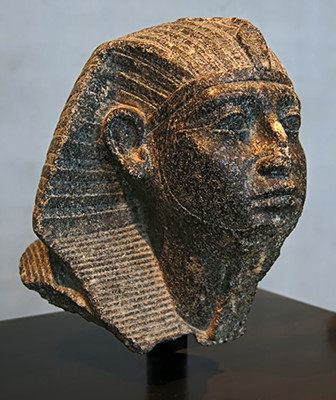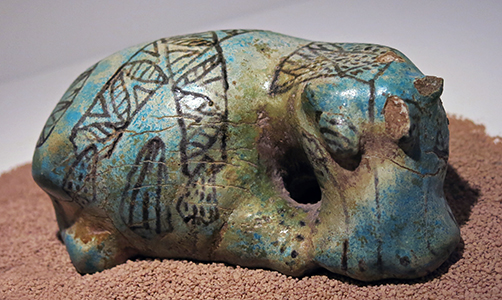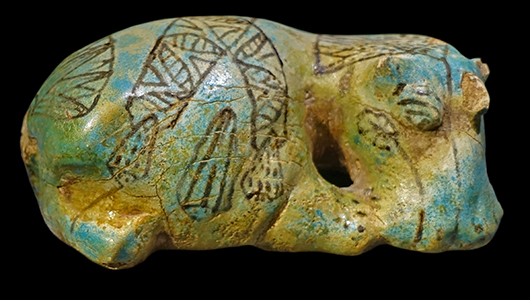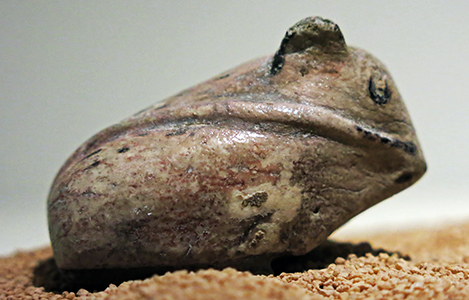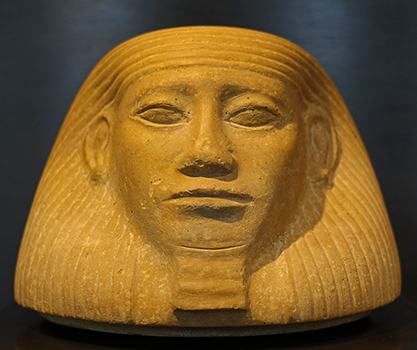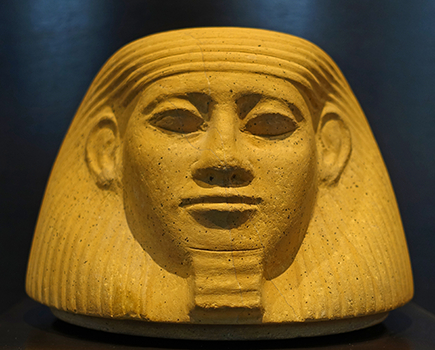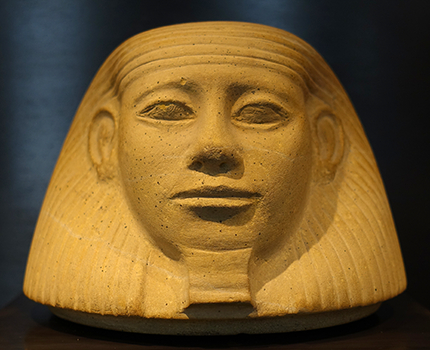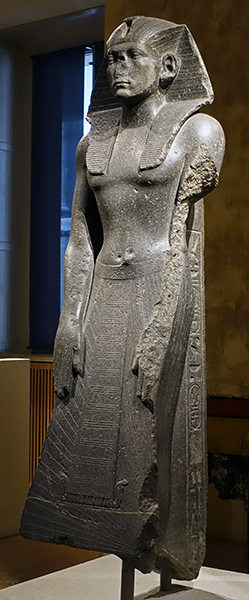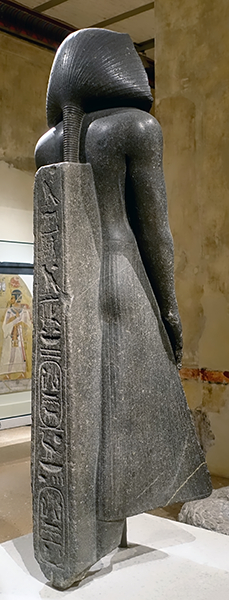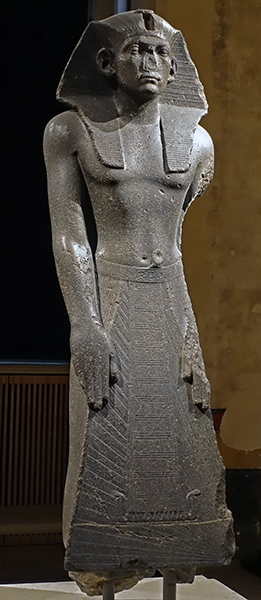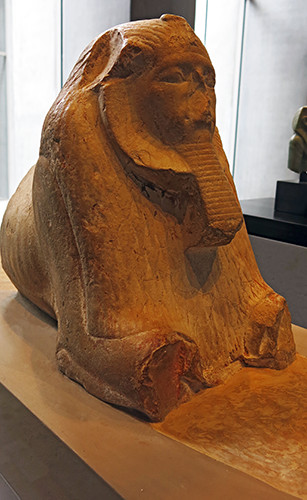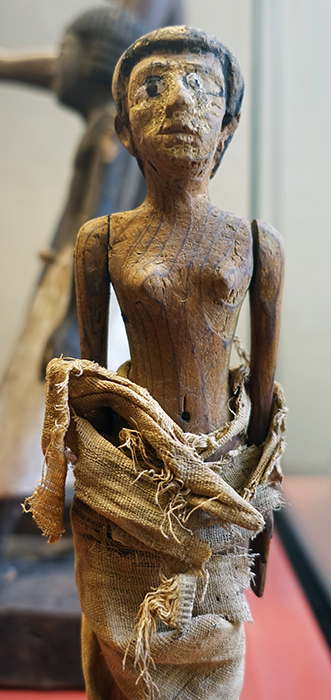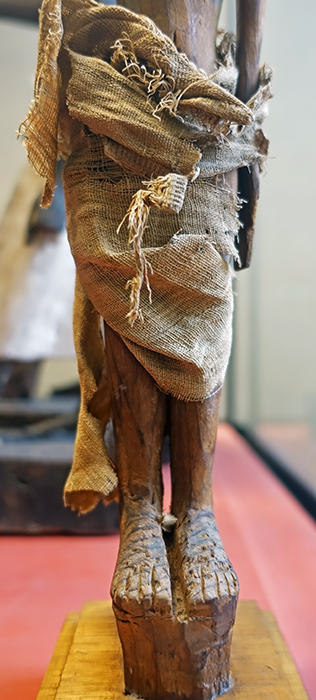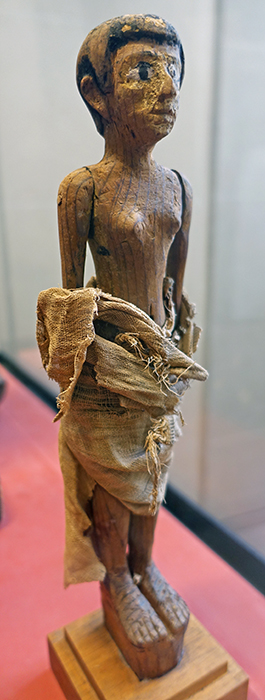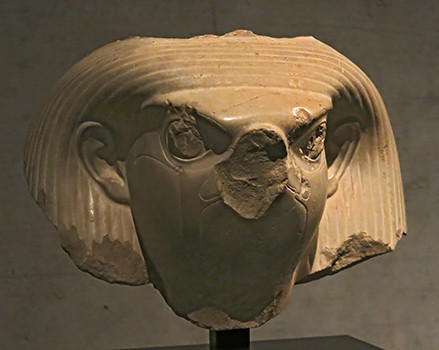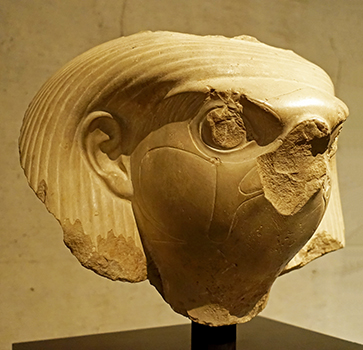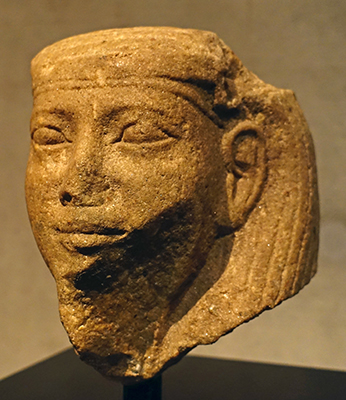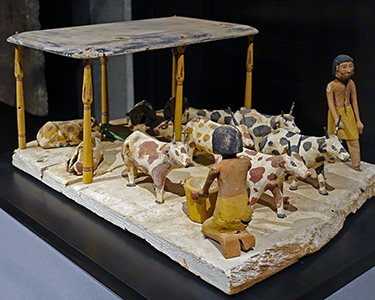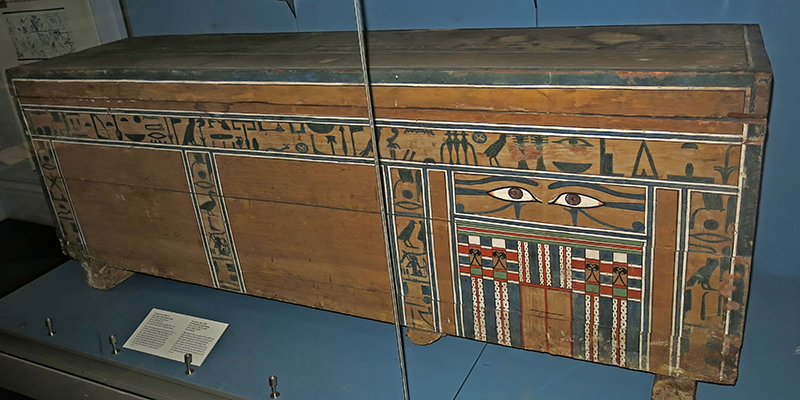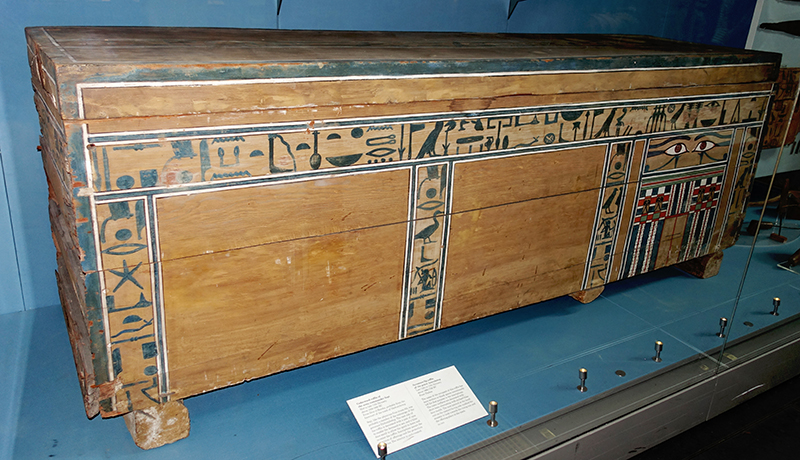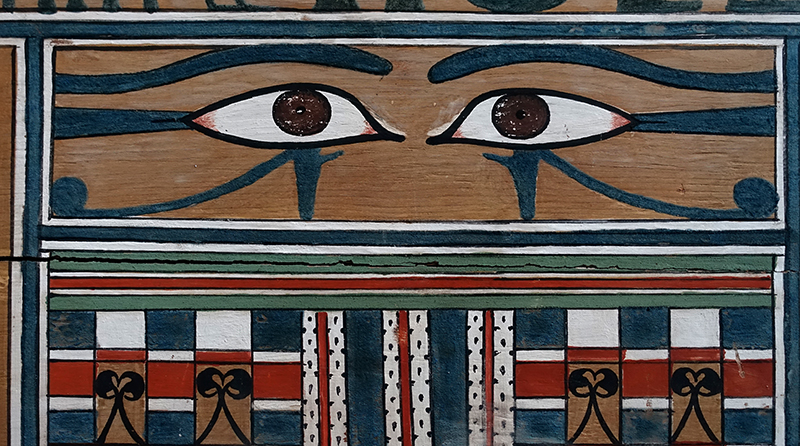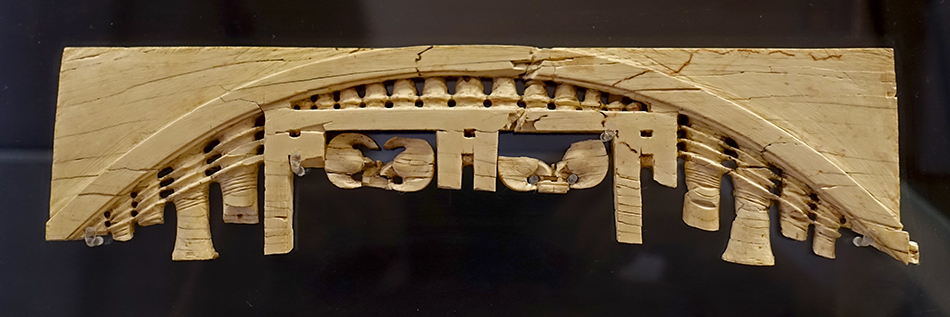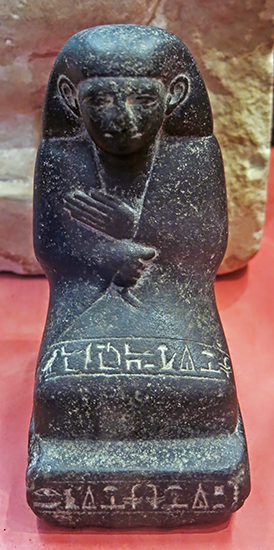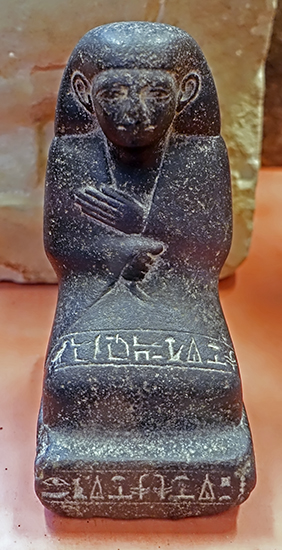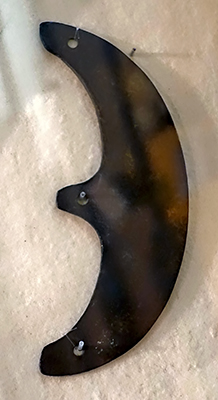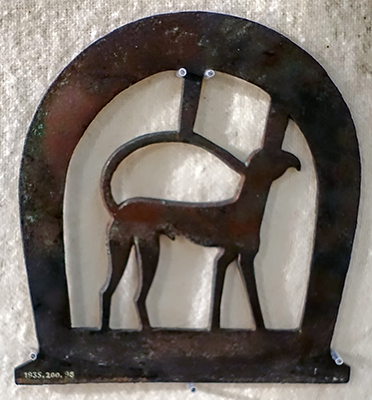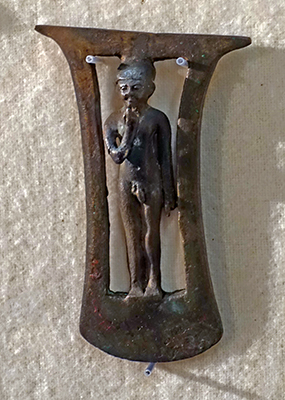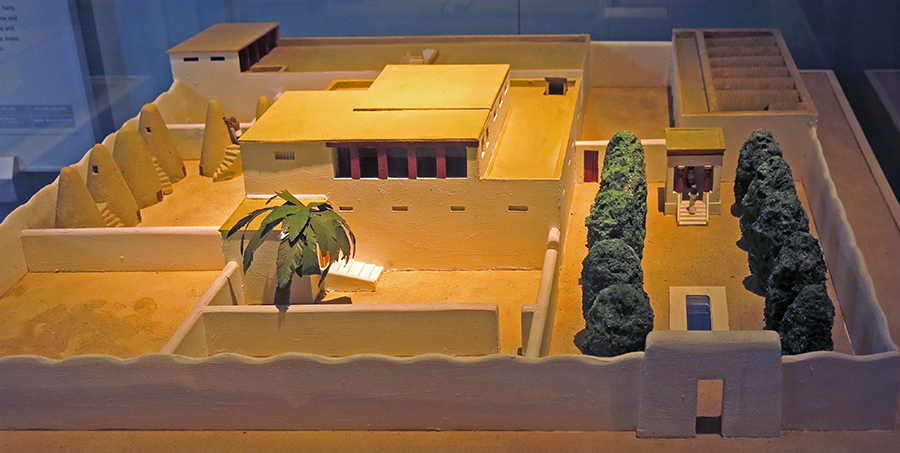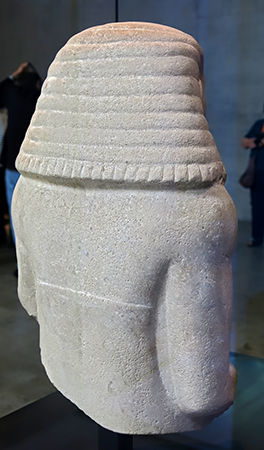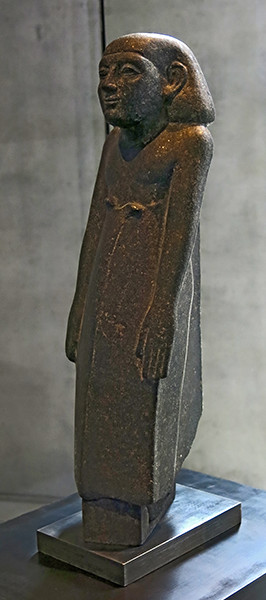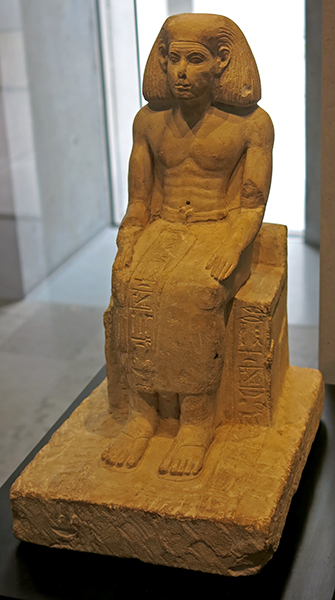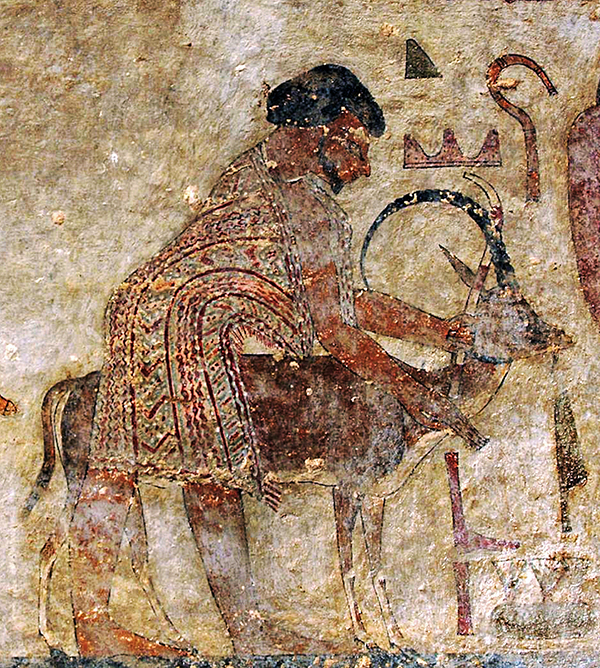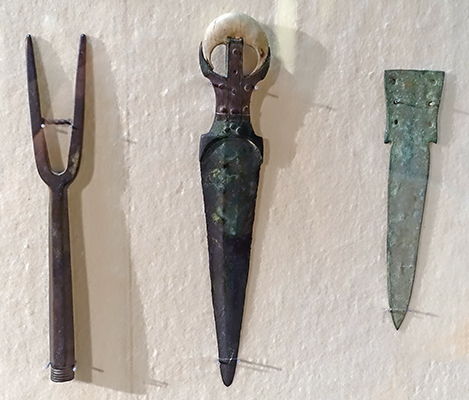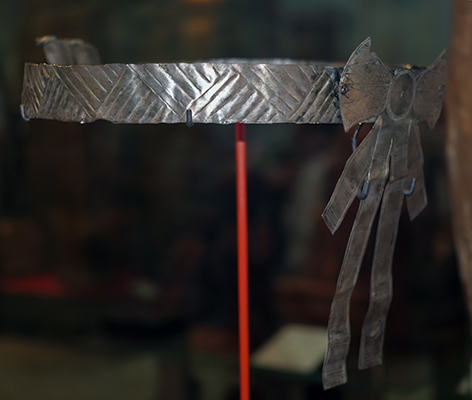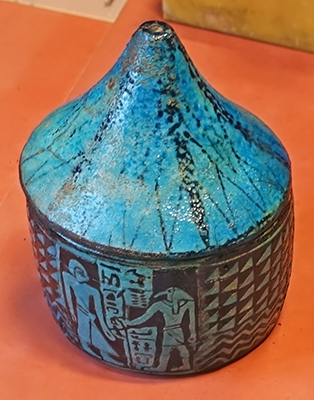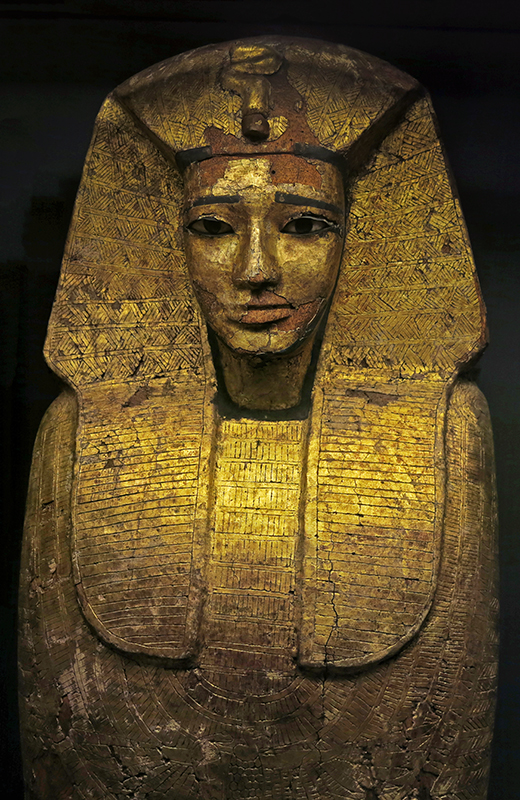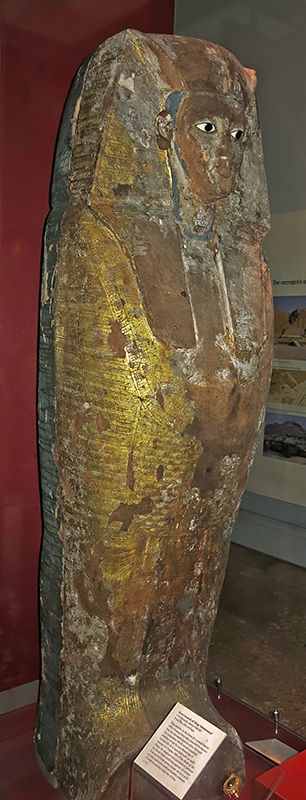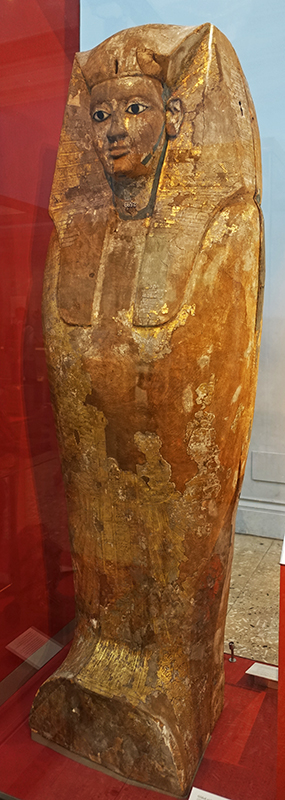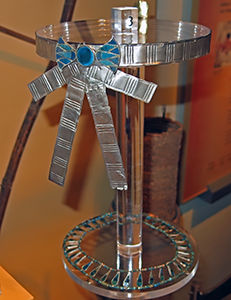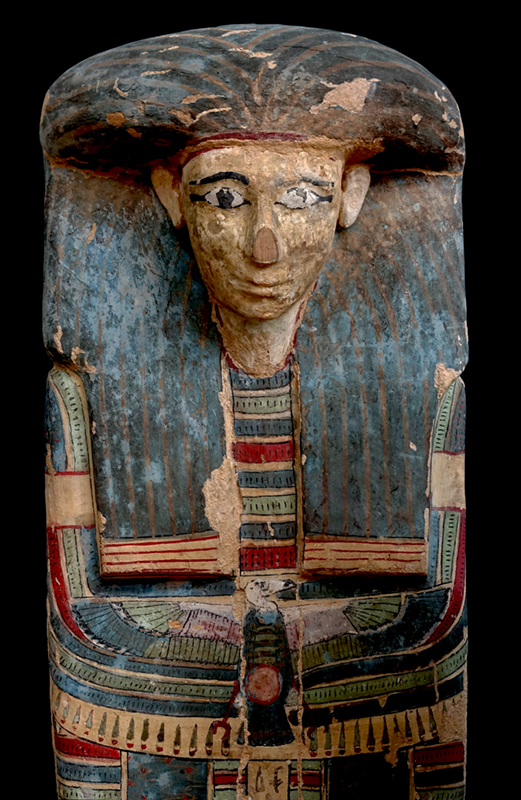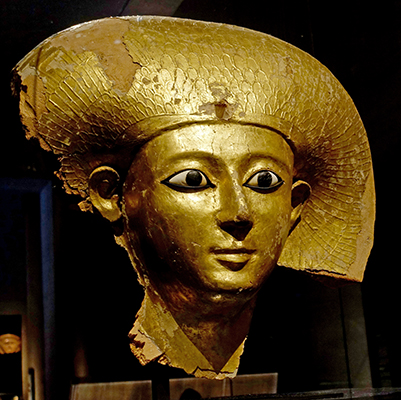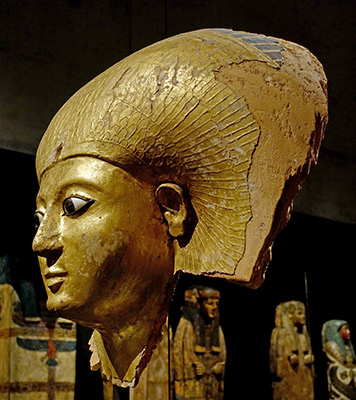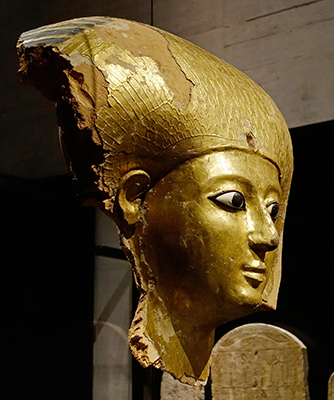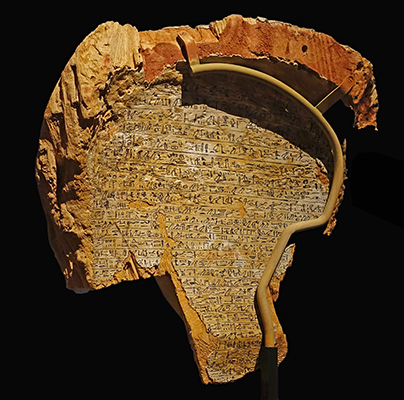Back to Don's Maps
 Back to Archaeological Sites
Back to Archaeological Sites
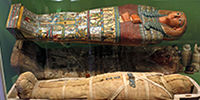 Back to Egypt Index Page
Back to Egypt Index Page
Ancient Egyptian culture from the 11th Dynasty to the end of the 17th Dynasty
Egyptian Chronology
| Egyptian Chronology | ||
|---|---|---|
| Date | Culture | Duration |
| 11 000 BC | Jebel Sahaba | |
| Before 8 000 BC - Palaeolithic in Europe and Northern Asia | ||
| 8 000 BC - Nominal end of the Ice Age | ||
| 8 600 - 4 400 BC | Nabta Playa Neolithic | 4 200 years |
| 6 100 - 5 180 BC | Qarunian (formerly known as Fayum B) | 920 years |
| 5 200 - 4 200 BC | Fayum A | 1 000 years |
| 4 800 - 4 200 BC | Merimde | 600 years |
| 4 600 - 4 400 BC | El Omari | 200 years |
| 4 400 - 4 000 BC | Badarian | 400 years |
| 4 000 - 3 300 BC | Maadi | 700 years |
| 3 900 - 3 650 BC | Naqada I | 250 years |
| 3 650 - 3 300 BC | Naqada II | 350 years |
| 3 300 - 2 900 BC | Naqada III | 400 years |
| 3 100 - 2 670 BC | Early Dynastic | 430 years |
| 2 670 - 2 181 BC | Old Kingdom | 489 years |
| 2 181 - 2 025 BC | First Intermediate Period | 156 years |
| 2 025 - 1 700 BC | Middle Kingdom | 325 years |
| 1 700 - 1 550 BC | Second Intermediate Period | 150 years |
| 1 550 - 1 077 BC | New Kingdom | 473 years |
| 1 077 - 664 BC | Third Intermediate Period | 413 years |
| 664 - 332 BC | Late Period | 332 years |
| 525 - 404 BC | First Persian Period | 121 years |
| 404 - 343 BC | Late Dynastic Period | 61 years |
| 343 - 332 BC | Second Persian Period | 11 years |
| 332 - 305 BC | Macedonian Period | 27 years |
| 305 - 30 BC | Ptolemaic Period | 275 years |
| 30 BC - 395 AD | Roman Period | 425 years |
| 395 AD - 640 AD | Byzantine Period | 245 years |
| 640 AD - 1517 AD | Islamic Period | 877 years |
| 1517 AD - 1867 AD | Ottoman Period (French Occupation 1798-1801) |
350 years |
| 1867 AD - 1914 AD | Khedival Period | 47 years |
| 1914 AD - 1922 AD | Sultanate under Hussein Kamel, as a British Protectorate |
8 years |
| 1922 AD - 1953 AD | Monarchy | 31 years |
| 1953 AD - Present Day | Republic | |
| First to Twentieth Dynasties | |||
|---|---|---|---|
| Date | Dynasty | Period | Duration (years) |
| 3 100 - 2 890 BC | First Dynasty | Archaic/Early Dynastic Period | 214 |
| 2 890 - 2 670 BC | Second Dynasty | Archaic/Early Dynastic Period | 220 |
| 2 670 - 2 613 BC | Third Dynasty | Old Kingdom | 57 |
| 2 613 - 2 494 BC | Fourth Dynasty | Old Kingdom - Golden Age | 119 |
| 2 494 - 2 345 BC | Fifth Dynasty | Old Kingdom | 149 |
| 2 345 - 2 181 BC | Sixth Dynasty | Old Kingdom | 164 |
| 2 181 - 2 160 BC | Seventh and Eighth Dynasties | First Intermediate Period | 21 |
| 2 160 - 2 134 BC | Ninth and Tenth Dynasties | First Intermediate Period | 26 |
| 2 134 - 1 991 BC | Eleventh Dynasty | Middle Kingdom | 43 |
| 1 991 - 1 802 BC | Twelfth Dynasty | Middle Kingdom | 189 |
| 1 802 - 1 649 BC | Thirteenth Dynasty From Memphis, over Middle and Upper Egypt |
Middle Kingdom | 153 |
| 1 805 - 1 650 BC | Fourteenth Dynasty From Avaris, Nile Delta, over Lower Egypt |
Second Intermediate Period | 155 |
| 1 650 - 1 550 BC | Fifteenth Dynasty First Hyksos dynasty, ruled from Avaris, without control of the entire land |
Second Intermediate Period | 100 |
| 1 649 - 1 582 BC | Sixteenth Dynasty Ruled the Theban region in Upper Egypt The Hyksos ruled the delta The Kingdom of Kush ruled Upper Egypt |
Second Intermediate Period | 67 |
| 1 580 - 1 550 BC | Seventeenth Dynasty Ruled Thebes, Hyksos ruled the delta |
Second Intermediate Period / New Kingdom | 30 |
| 1 543 - 1 292 BC | Eighteenth Dynasty Egypt reaches the peak of its power |
New Kingdom | 251 |
| 1 292 - 1 187 BC | Nineteenth Dynasty Conquests in Canaan |
New Kingdom | 105 |
| 1 187 - 1 077 BC | Twentieth Dynasty | End of the New Kingdom | 110 |

Timeline for early Egypt, from 11 000 BC to 2 500 BC.
Photo: Poster, British Museum © Trustees of the British Museum, CC BY-NC-SA 4.0
Rephotography: Don Hitchcock 2015
The Middle Kingdom
After the First Intermediate Period (2 181 BC to 2 061 BC, including the rules of the early members of the 11th Dynasty before Mentuhotep II) during which Egypt was governed by independent local rulers, the Middle Kingdom brought with it not only another period of central government but also a heyday of literature and an outstanding development of the individual. The most important wisdom and socio-critical texts date back to that period and show this newly discovered understanding which is also represented in statuary.Text above: © Poster at the Staatliche Museen zu Berlin (CC BY-NC-SA 3.0 DE)
Based on the portrayal of the respective ruler, people not only represent themselves with noticeably large ears, but also an almost pessimistic expression. The long coat, veiling the entire body, intensifies this effect. The repertoire of private statues has been expanded by the block statue, depicting a person sitting on the ground with his knees drawn to his body. Private statuary is not limited to the funerary context any longer but can now be found in the temples as well. Votive temple statues were supposed to make sure that the donor could take part in the temple rituals.
The Eleventh Dynasty: 2 134 BC - 1 991 BC
The Eleventh Dynasty of ancient Egypt (notated Dynasty XI) is a well attested group of rulers, whose earlier members before Mentuhotep II are grouped with the four preceding dynasties to form the First Intermediate Period, while the later members are considered part of the Middle Kingdom. They all ruled from Thebes. The relative chronology of the 11th Dynasty is well established by contemporary attestations and, except for count Intef and Mentuhotep IV, by the Turin canon.
| Eleventh Dynasty | ||||||
|---|---|---|---|---|---|---|
| Name | Personal Name | Consort | Burial | Years | Dates | Comments |
| Intef the Elder | Iry-Pat, 'the Count', probably the same as 'Intef, son of Iku'. Theban nomarch serving an unnamed king |
|||||
| Mentuhotep I | Tepya | Neferu I | 2 134 BC - | Tepy-a, 'the ancestor' | ||
| Intef I | Sehertaway | El-Tarif, Thebes | - 2 118 BC | Son of Mentuhotep I | ||
| Intef II | Wahankh | El-Tarif, Thebes | 49 | 2 118 BC - 2 069 BC | Brother of Intef I | |
| Intef III | Nakhtnebtepnefer | Iah (queen) | El-Tarif, Thebes | 8 | 2 069 BC - 2 061 BC | Brother of Intef I |
| Nebhepetre Mentuhotep II |
Smatawy | Tem, Neferu II, Ashayet Henhenet, Kawit, Kemsit, Sadeh |
Deir el-Bahari | 51 | 2 061 BC - 2 010 BC | Son of Intef III and Iah. Reunifies Egypt, starting the Middle Kingdom |
| Sankhkare Mentuhotep III |
Sankhtawyef | Deir el-Bahari | 51 | 2 010 BC - 1 998 BC | Son of Mentuhotep II and Tem. | |
| Nebtawyre Mentuhotep IV |
Sankhtawyef | Deir el-Bahari | 51 | 1 998 BC - 1 991 BC | Son of Mentuhotep II and Tem. | |
Eleventh Dynasty: 2 134 - 1 991 BC
Intef / Antef II
Standing figure of Antef II, circa 1 950 BC
Dimensions: 370 x 122 x 186 mm.
This cloaked statue of Intef / Antef probably originated in the later Eleventh Dynasty, or at the beginning of the Twelfth Dynasty, indicated by the characteristics of the hieroglyphic and hieratic signs.
( note that this date means that the statue was created after Intef's death, a common occurrence when a particular Pharaoh was venerated after their death - Don )
The dense covering of the long mantle, the severity of the deep wig, and the arms that cross over the chest, strictly limit the structure of the body to the essentials. The hands clenched in fists once held objects. The column-like subdivided legs show Antef slightly stepping forward, the oversized feet and the bulky base are only simply shown.
The well-preserved painting shows black hair and red skin. The clothing now shows only bare limestone, but was originally painted white. The base and backposts are red with black dots as an imitation of granite. The blue-painted hieroglyphs identify his brother Inherhotep and his sister Nachti, as well as denoting him as 'the honored one at Ptah-Sokaris-Intef, born of Sat-Mechit'.
Catalog: Painted limestone, Thebes, ÄM 12485
Photo: Don Hitchcock 2015, 2018
Source: Original, Staatliche Museen zu Berlin, Neues Museum, Germany
Text: © Card at the Staatliche Museen zu Berlin (CC BY-NC-SA 3.0 DE)
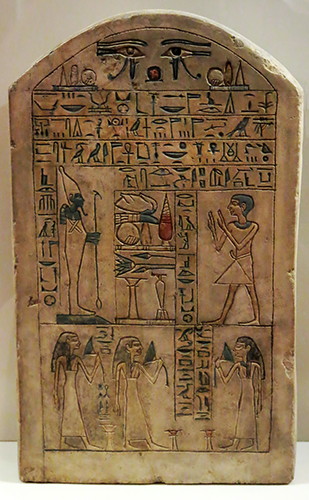
Eleventh Dynasty: 2 134 - 1 991 BC
Stela of Ipepi
Ipepi is shown worshipping Osiris. He is accompanied by his wife, mother and sister
Catalog: Limestone, ÄM 24031
Photo: Don Hitchcock 2015
Source: Original, Staatliche Museen zu Berlin, Neues Museum, Germany
Text: © Card at the Staatliche Museen zu Berlin (CC BY-NC-SA 3.0 DE)

Eleventh Dynasty: 2 134 - 1 991 BC
Stela of Intef
Stele of Intef with family.
Circa 2000 BC.
( note that this date given by the museum card is difficult to reconcile with the known dates for the Pharaohs with the name of Intef. It is probably an official with the same name. Egyptians reused pharaoh's and other important names, often for centuries - Don )
Catalog: Limestone Abydos (?), Inv. no. 2828 (?)
Photo: Don Hitchcock 2018
Source and text: Original, Museum August Kestner, Hannover
Additional text: Paper Catalogue, Museum August Kestner, Hannover.
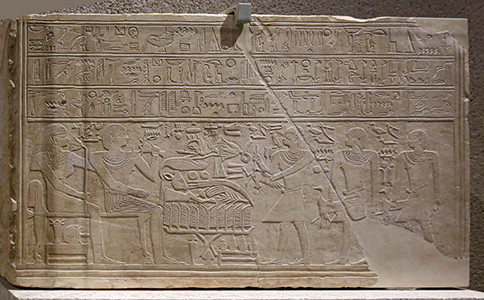
Eleventh Dynasty: 2 134 - 1 991 BC
Hanefer and his wife
Tomb relief: Hanefer and his wife in front of an offering table with three sons.
Circa 2 000 BC.
Catalog: Limestone, ÄM 1197
Photo: Don Hitchcock 2015
Source: Original, Staatliche Museen zu Berlin, Neues Museum, Germany
Text: © Card at the Staatliche Museen zu Berlin (CC BY-NC-SA 3.0 DE)

Eleventh Dynasty: 2 134 - 1 991 BC
Broad collar of faience beads
Late 11th Dynasty, about 2 000 BC, from Deir el-Bahri (Thebes / Luxor), funerary monument of King Mentuhotep II, tomb 3, width 240 mm, length 416 mm, diameter 183 mm
Items of jewellery, placed on the mummy, also provided magical protection. Some were personal possessions, others were made specifically for the tomb, and were often flimsy since they were not intended to be worn by the living.
An important category of funerary jewellery is that of collars. The wesekh, or 'broad' collar conferred protection on the deceased, the terminals are often in the form of falcon heads. This was found in the tomb of a female member of the court of King Mentuhotep II.
This 'wesekh' consists of five rows of beads, two semicircular terminals and seven mummiform pendants, all of glazed composition. Four of the rows are of vertically strung cylindrical beads connected only at the ends. The longer beads are in the centre of the collar, the shorter ones at the sides. The top row is of white glazed composition, the second of bright-blue, the third of white and the outermost row of purplish glazed composition. The last colour, not common until the Eighteenth Dynasty is produced from manganese oxide.
The fifth, topmost, row is composed of a single string of bright-blue and white cylinder beads strung lengthwise. In the centre of each of the five rows is a short loop of bright-blue glazed composition disc beads. The seven bright-blue glazed composition mummiform pendants are attached to the bottom row of beads. The two bright-blue semicircular terminals are undecorated. Each has a ridge along the underside which is pierced by six holes through which the threads holding the rows of beads are knotted.
Catalog: EA40928
Photo: Don Hitchcock 2015
Source: Original, British Museum
Text: Card at museum display, http://www.britishmuseum.org/, © Trustees of the British Museum, CC BY-NC-SA 4.0
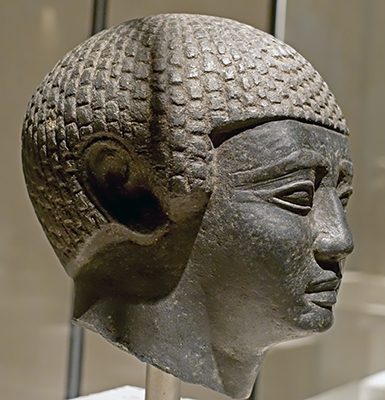
Eleventh Dynasty: 2 134 - 1 991 BC
Head of a statue of a man
Circa 2000 BC
Catalog: Granite, Thebes, ÄM 254
Photo: Don Hitchcock 2018
Source: Original, Staatliche Museen zu Berlin, Neues Museum, Germany
Text: © Card at the Staatliche Museen zu Berlin, (CC BY-NC-SA 3.0 DE)
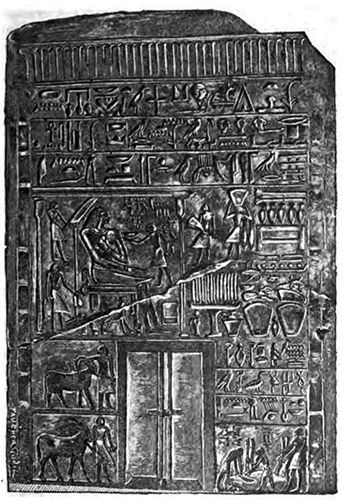
Eleventh Dynasty: 2 134 - 1 991 BC
Stele of Prince Intef
False-door shaped stele of prince Intef, nomarch of Thebes, here depicted receiving offerings from his servants.
Limestone, Height 104 cm, from Dra Abu el-Naga, proto-11th dynasty, First intermediate period. Cairo, Egyptian Museum
Catalog: Egyptian Museum CG 20009.
Photo: Gaston Maspero, 1914
Permission: Public Domain
Source: Original, Cairo Museum

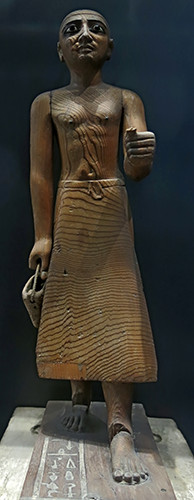
Eleventh Dynasty: 2 134 - 1 991 BC
Hétépi, chief of the magicians.
Height 430 mm, length 183 mm, width 381 mm.
Circa 2 000 BC, the end of the 11th Dynasty.
Coniferous wood, acacia, and ficus were used in its construction.
Catalog: Sully, Rez-de-chaussée, Salle18, E 123
Photo: Don Hitchcock 2015
Source and text: Original, Louvre Museum, https://collections.louvre.fr/
Eleventh Dynasty: 2 134 - 1 991 BC
Axe
Axe blade with reconstructed handle, Intermediate period, circa 2 000 BC.
( note that this tool looks more like a machete than an axe, and may have been used for cutting a path through tangled vines and similar vegetation, or perhaps for harvesting papyrus stalks, as we might use a modern machete today - Don )
Catalog: Bronze with modern wood, origin unknown, Inv. Nr. 1935.200.97
Photo: Don Hitchcock 2018
Source and text: Original, Museum August Kestner, Hannover
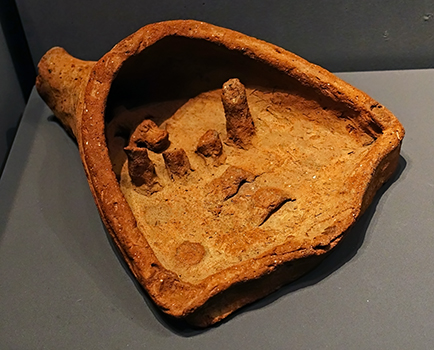
Eleventh Dynasty: 2 134 - 1 991 BC
Crocodile god
Model of a sanctuary for a crocodile god, Intermediate period, circa 2 000 BC.
Catalog: Terra cotta, ÄS 6796
Photo: Don Hitchcock 2018
Source: Original, Ägyptischen Museum München
Text: Museum card, © Ägyptischen Museum München
Eleventh - Twelfth Dynasty: 2 134 - BC- 1 802 BC
Pleated robe
Still with its original pleats, end of 11th dynasty, beginning of 12th dynasty, 2 033 - BC- 1 862 BC
Height 1210 mm, width 570 mm.
Catalog: Linen, tomb 13, Assiut (Lycopolis), E 12026
Location: Aile Sully, Salle 330 - La parure, Vitrine 4
Photo: Don Hitchcock 2018
Source and text: Original, Louvre Museum, https://collections.louvre.fr/
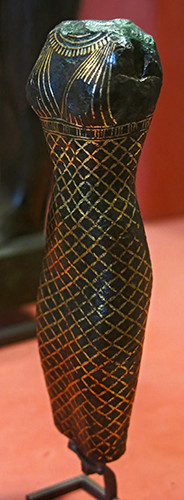
Date uncertain: 2 033 BC - 1069 BC
Body of a goddess
The Egyptians used an alloy of copper and tin (bronze) which is easier to melt and harder than pure copper ore. Egyptian bronzes also contain lead, which lowers the melting temperature. Some bronzes have a black patina that highlights the gold inlays.
Gold is not uncommon in the desert, east of the Nile, in Egypt and Nubia. Electrum, a natural alloy of gold and silver also occurs.
The 'black bronzes' are special alloys (copper, silver, gold) whose patina highlights the incrustations of metals in contrasting colours.
This inlay of yellow gold threads and red gold 'rivets', only visible in the full size images ( click on any image to zoom in ), imitates bead netting.
Height 12 cm.
Catalog: Sully, salle 7, E 27430
Photo: Don Hitchcock 2015
Source: Original, Musée du Louvre
Text: © Musée du Louvre
Date uncertain: 2 033 BC - 1 710 BC (Middle Kingdom)
Model of a boat
This wooden model of a boat is from the Middle Kingdom, 2 033 BC - 1 710 BC.
Height 116 mm, length 503 mm, thickness 87 mm.
The decoration and the accessories for this object have disappeared.
Catalog: Sully, Rez-de-chaussée, Le Nil, Salle 3, E 5539
Photo: Don Hitchcock 2015
Source: Original, Musée du Louvre
Text: © Musée du Louvre

Date uncertain: 2 033 BC - 1 710 BC (Middle Kingdom)
Model of a house
( The house is designed on two levels, with three rooms on ground level, giving access to an enclosed courtyard, and a staircase to an upper room.
In reality, the upper room probably had access to the raised terrace. - Don )
Height 245 mm, width 300 mm, thickness 275 mm.
Catalog: Terracotta, Aile Sully, Salle 331 - La maison et le mobilier, Vitrine 3, AF 12920
Photo: Don Hitchcock 2018
Source and text: Original, Louvre Museum, https://collections.louvre.fr/
Date uncertain: 2 033 BC - 1 710 BC (Middle Kingdom)
Model of a boat
Painted wooden model of a funerary boat bearing a mummy.
Height 490 mm, length 775 mm, width 190 mm
( note that there are no oars or seated rowers - the boat is apparently being poled along at a shallow part of the Nile - Don )
Catalog: Sully, Rez-de-chaussée, Le Nil, Salle 336, Vitrine 2, le Nil, E 17111
Photo: Don Hitchcock 2015, 2018
Source and text: Louvre Museum, Paris, France
Additional text: http://cartelfr.louvre.fr/
Date uncertain: 2 033 BC - 1 710 BC (Middle Kingdom)
Model of a boat
Length 890 mm, height 285 mm.
From the Assiut necropolis. Oars in this deposit were piled on the boats, not displayed as here.
Catalog: Salle 336, E 11993 - E 11994, (the individual parts of this model have been made up from two different models)
Photo: Don Hitchcock 2018
Source and text: Original, Musée du Louvre
Additional text: http://egyptomusee.over-blog.com/2018/06/de-la-navigation-egyptienne-4.modeles-d-embarcations-e-11993-94-et-e-12027.html
Date uncertain: 2 033 BC - 1 710 BC (Middle Kingdom)
Funerary model of a large boat and crew.
Catalog: Wood, painted, E 32566
Photo: Don Hitchcock 2018
Source and text: Louvre Museum, Paris, France
Date uncertain: 2 033 BC - 1 710 BC (Middle Kingdom)
Model of a boat and crew.
The owner sits in the cabin, a flower in his hand.
Height 295 mm, length 670 mm, width 155 mm.
( note what is apparently a model stone anchor weight beneath the prow of the boat, and the large decorated steerage oar provided in this model - Don )
Catalog: Wood, stuccoed and painted, E 284
Photo: Don Hitchcock 2015, 2018
Source and text: Louvre Museum, Paris, France

Date uncertain: 2 033 BC - 1 710 BC (Middle Kingdom)
Platter
Pottery offering-platter or table, oval in form, with offerings in relief.
Dimensions: Length: 307 mm, width 265 mm.
The graves of the poor were often simple shafts, without a mortuary-chapel for the ritual provisioning of the dead. To supply this need a pottery offering-platter or model house was often deposited at the mouth of the shaft. The platters contain a water basin and a range of food offerings. More elaborate 'soul houses' incorporated a house to serve as a dwelling for the spirit.
Catalog: Pottery, provenance unknown, EA21702
Photo: Don Hitchcock 2018
Source: Original, British Museum
Text: Card at museum display, http://www.britishmuseum.org/, © Trustees of the British Museum, CC BY-NC-SA 4.0
Date uncertain: 2 033 BC - 1 710 BC (Middle Kingdom)
Hippopotamus
Height 920 mm, length 163 mm.
Decorations of aquatic plants and a bird evoke the swamps where the animal lives.
Catalog: Silicious faience, Sully, Rez-de-chaussée, Salle 336, Vitrine2 : le Nil, E 5886
Photo: Don Hitchcock 2015, 2018
Source and text: Louvre Museum, Paris, France
Date uncertain: 2 033 BC - 1 710 BC (Middle Kingdom)
Hippopotamus
Height 57 mm, length 96 mm.
Catalog: Silicious faience, Sully, Rez-de-chaussée, Salle 336, Vitrine 2: le Nil, E 4495
Photo: Don Hitchcock 2015, 2018
Source and text: Louvre Museum, Paris, France
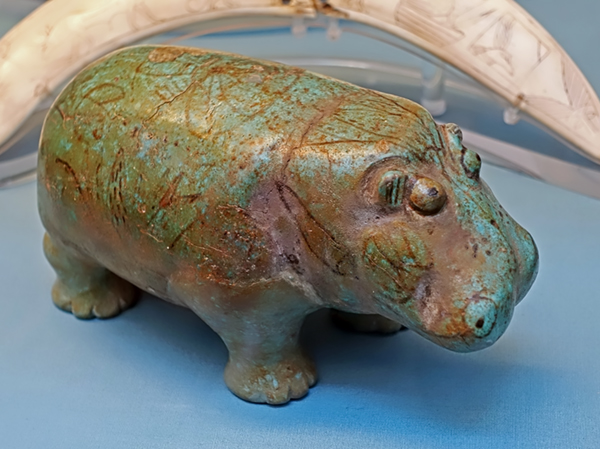
Date uncertain: 2 033 BC - 1 710 BC (Middle Kingdom)
Hippopotamus
Glazed composition hippopotamus. The destructive character of the hippopotamus led it to be regarded as a hostile force by the Egyptians. This model, decorated with marsh plants, decorated on the back with lotus patterns in black, evokes the pleasures and dangers of the marshland. It was probably placed in a tomb, its legs (now restored) possibly deliberately broken off to render it harmless to the deceased person.
Length 204 mm.
Catalog: Thebes, EA35004
Photo: Don Hitchcock 2018
Source: Original, British Museum
Text: www.britishmuseum.org/research/ and card at the Museum, © Trustees of the British Museum, CC BY-NC-SA 4.0
Date uncertain: 2 033 BC - 1 710 BC (Middle Kingdom)
Scribe
The scribe Intef keeps an account of the grain.
Painted wood, height 117 mm, length 94 mm.
Catalog: Sully, Salle 335, E 2709
Photo: Don Hitchcock 2015, 2018
Source and text: Louvre Museum, Paris, France

Date uncertain: 2 033 BC - 1 710 BC (Middle Kingdom)
Statuette of a woman
Catalog: Painted wood, Inv. H 986
Photo: Don Hitchcock 2015
Source and text: Badisches Landesmuseum Karlsruhe Germany
Magic Baton in ivory
Date uncertain: 2 033 BC - 1 710 BC (Middle Kingdom)
Carved into incisor of a hippopotamus, this stick is engraved with real or fantastic animals and demons.
On the reverse a text, shown in the reflection of the mirror below the object, is translated as: 'I bring the protection of life to the lady Mersenebès.'
Length 161 mm, width 60 mm, thickness 9 mm.
Catalog: Sully, Rez-de-chaussée, Les dieux et la magie, Salle 18, Vitrine 2: La magie, E 3614
Photo: Don Hitchcock 2015
Source: Original, Musée du Louvre
Text: © Musée du Louvre
Date uncertain: 2 033 BC - 1 710 BC (Middle Kingdom)
Magic Baton in ivory
Carved into the incisor of a hippopotamus, this stick is engraved with real or fantastic animals and demons.
Catalog: Sully, Rez-de-chaussée, Les dieux et la magie, Salle 18, Vitrine 2: La magie, AF 6447
Photo: Don Hitchcock 2015
Source: Original, Musée du Louvre
Text: © Musée du Louvre
Date uncertain: 2 033 BC - 1 710 BC (Middle Kingdom)
Magic Baton in ivory
Carved into the incisor of a hippopotamus, this stick is engraved with real or fantastic animals and demons.
Catalog: Sully, Rez-de-chaussée, Les dieux et la magie, Salle 18, Vitrine 2: La magie
Photo: Don Hitchcock 2015
Source: Original, Musée du Louvre
Text: © Musée du Louvre
Date uncertain: 2 033 BC - 1 710 BC (Middle Kingdom)
Magic Baton in ivory
( Carved into the incisor of a hippopotamus, two images of Taweret / Toeris flank a central panel of felines and children. Taweret is the protective ancient Egyptian goddess of childbirth and fertility. The deity is typically depicted as a bipedal female hippopotamus with feline attributes, pendulous female human breasts, the limbs and paws of a lion, and the back and tail of a Nile crocodile - Don )
Catalog: Ivory, Thebes, Dra Abu el-Naga, one of: ÄS 2952, ÄS 2962, ÄS 2825, ÄS 2826
Photo: Don Hitchcock 2018
Source: Original, Ägyptischen Museum München
Text: Museum card, © Ägyptischen Museum München
Additional text: Wikipedia
Date uncertain: 2 033 BC - 1 710 BC (Middle Kingdom)
Magic Baton in ivory
Carved into the incisor of a hippopotamus, this stick is engraved with fantastic animals and/or demons.
Catalog: Ivory, Thebes, Dra Abu el-Naga, one of: ÄS 2952, ÄS 2962, ÄS 2825, ÄS 2826
Photo: Don Hitchcock 2018
Source: Original, Ägyptischen Museum München
Text: Museum card, © Ägyptischen Museum München
Date uncertain: 2 033 BC - 1 710 BC (Middle Kingdom)
Magic Baton in ivory
Carved into the incisor of a hippopotamus, this stick is engraved with fantastic animals and/or demons.
Catalog: Ivory, Thebes, Dra Abu el-Naga, one of: ÄS 2952, ÄS 2962, ÄS 2825, ÄS 2826
Photo: Don Hitchcock 2018
Source: Original, Ägyptischen Museum München
Text: Museum card, © Ägyptischen Museum München
Date uncertain: 2 033 BC - 1 710 BC (Middle Kingdom)
Magic Baton in ivory
Carved into the incisor of a hippopotamus, this stick is engraved with fantastic animals and/or demons.
Catalog: Ivory, Thebes, Dra Abu el-Naga, one of: ÄS 2952, ÄS 2962, ÄS 2825, ÄS 2826
Photo: Don Hitchcock 2018
Source: Original, Ägyptischen Museum München
Text: Museum card, © Ägyptischen Museum München
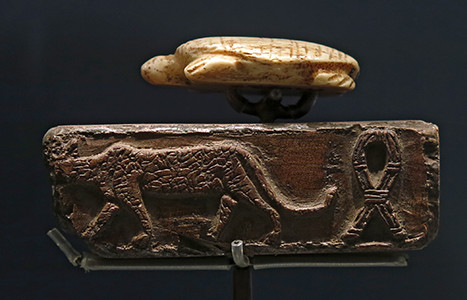
Part of a Magic Baton
Date uncertain: 2 033 BC - 1 710 BC (Middle Kingdom)
Material: Steatite, formerly enamelled.
Height 21 mm, length 62 mm, width 22 mm.
Catalog: Sully, Rez-de-chaussée, Les dieux et la magie, Salle 18, Vitrine 2: La magie, E 9940
Photo: Don Hitchcock 2015
Source: Original, Musée du Louvre
Text: © Musée du Louvre
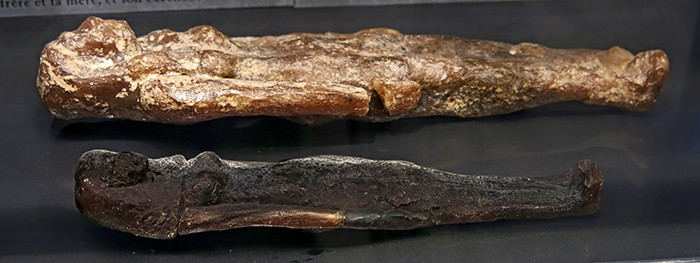
Two female figures in wax, used in Magic
Eleventh - Twelfth Dynasty: Circa 2 000 BC - 1 900 BC (Middle Kingdom)
Height 227 mm (upper figure).
Catalog: Sully, Rez-de-chaussée, Les dieux et la magie, Salle 18, Vitrine 2: La magie, (upper figure) E 27250
Photo: Don Hitchcock 2015
Source: Original, Musée du Louvre
Text: © Musée du Louvre

Dog devouring a man, used in Magic
Date very uncertain, possibly: 2 033 BC - 1 710 BC (Middle Kingdom)
Figurine of enchantment: dog devouring a man.
Wax and linen, length 71 mm, height 37 mm.
Catalog: Sully, Rez-de-chaussée, Les dieux et la magie, Salle 18, Vitrine 2: La magie, (upper figure) E 27079
Photo: Don Hitchcock 2015
Source: Original, Musée du Louvre
Text: © Musée du Louvre
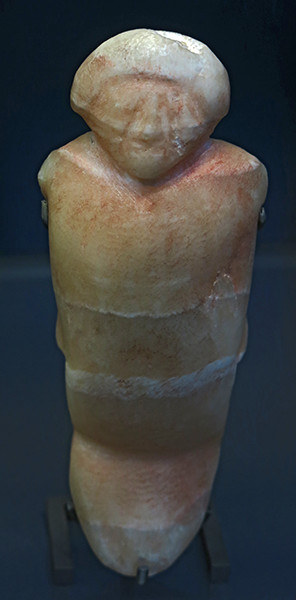
A bound prisoner
Date uncertain: 2 033 BC - 1 710 BC (Middle Kingdom)
Statuette of enchantment: a bound prisoner.
Material: alabaster
Height 107 mm, length 46 mm, thickness 26 mm.
Catalog: Sully, Rez-de-chaussée, Les dieux et la magie, Salle 18, Vitrine 2: La magie, E 27691
Photo: Don Hitchcock 2015
Source: Original, Musée du Louvre
Text: © Musée du Louvre
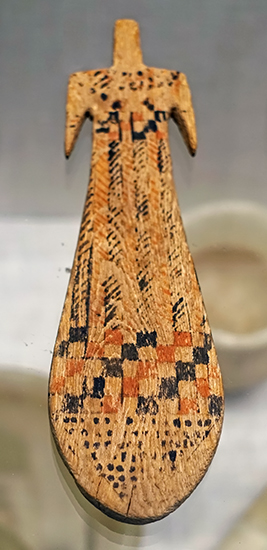
Middle Kingdom, Eleventh - Thirteenth Dynasty: 2 134 BC - 1 649 BC
Doll
Apparently limited to the period from circa 2 000 BC - 1 700 BC, a group of strange figures has been tentatively compared to concubine figures, but the lack of erogenous features and the suggestion of clothing (chessboard-like black and red pattern) does not fit with this explanation.
The interpretation of these objects as children's dolls is more likely. The highly simplified form - straight headpiece, short, pointed arms and the teardrop-like widening body - is sawn out of a flat board and wore (not preserved in this specimen) a large wig made of threads ending in small clay beads. The fact that - compared to the abundance of other categories - relatively few toys are known from Egypt can be explained by the low probability of making any finds at all: toys are of course only exceptionally grave goods; they belong above all to the realm of the living; and their houses have been largely destroyed by their location in the river valley and ever new structures being built on top of them.
Dimensions: Height 171 mm, width 50 mm
Catalog: Middle or Upper Egypt, wood, painted, Inv. no. 1937.77
Photo: Don Hitchcock 2018
Source and text: Original, Museum August Kestner, Hannover
Additional text: Paper Catalogue, Museum August Kestner, Hannover.
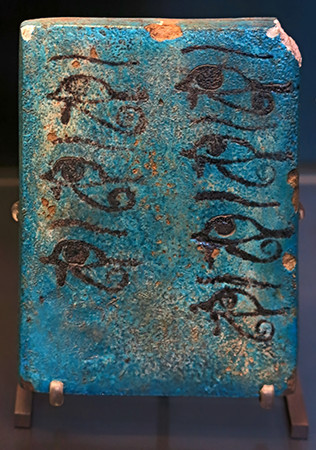
Magic tablet
Date uncertain: 2 033 BC - 1 710 BC (Middle Kingdom)
Magic tablet with seven Wadjet eyes, in faience.
The Eye of Horus is an ancient Egyptian symbol of protection, royal power and good health. The eye is personified in the goddess Wadjet
Length 92 mm, width 67 mm, thickness 14 mm.
One of the formulas of the Texts of the Sarcophagi (Coffin Texts) reads: 'on the drawing of seven Wadjet eyes, washed in beer and natron, and drunk.'
The Coffin Texts are a collection of ancient Egyptian funerary spells written on coffins and other objects beginning in the First Intermediate Period. They are partially derived from the earlier Pyramid Texts, reserved for royal use only, but contain substantial new material related to everyday desires, indicating a new target audience of common people. Ordinary Egyptians who could afford a coffin had access to these funerary spells and the pharaoh no longer had exclusive rights to an afterlife.
Catalog: Sully, Rez-de-chaussée, Les dieux et la magie, Salle 18, Vitrine 2: La magie, E 17358
Photo: Don Hitchcock 2015
Source: Original, Musée du Louvre
Text: © Musée du Louvre, Wikipedia
The Art of the Early Middle Kingdom
In the wake of the regional conflicts that raged throughout the First Intermediate Period, the reunification of the land spread out from Thebes: by 2040 BC, Mentuhotep II was ruler of a unified Egypt. Artistic production had already begun to rediscover its fundamental rules under his predecessors, if at first mostly in the field of two-dimensional wall carvings. The newly regulated political and social structures are reflected in the definite structure and confident draughtsmanship of the reliefs on royal and private stelae. The dynamism inherent in this new beginning is apparent in the energetically powerful style of the reliefs from the funerary temple of Mentuhotep II, which also documents the sculptors reacquired technical perfection. The Munich fragments came from the chapel of Kemsit, one of six wives of Mentuhotep, who, in view of her facial features and curly hairstyle, probably came from Nubia in the south.Text above: © Ägyptischen Museum München
Eleventh Dynasty: 2 134 - 1 991 BC
Mentuhotep II
Relief of Mentuhotep II and the Goddess Hathor, circa 2 010 - 2 000 BC.
King Nebhepetre Mentuhotep II was revered by the Egyptians as the ruler who reunited Egypt after the era of disunity (the First Intermediate Period) that followed the end of the Old Kingdom.
Descended from a family of Theban rulers, the king built his tomb and mortuary temple at Deir el-Bahri in western Thebes. This relief was originally part of the decoration of the temple's main sanctuary that was added to the building at the end of the king's reign. The fine balance between figures and inscriptions on this block, as well as the clear outline and regular proportions of the king's image with its individualized facial features, exemplify the peak of a relief art that had developed over the decades while the vast temple complex was built and decorated.
The figure of the goddess Hathor on the right of the block was chiselled away during the Amarna period, when King Akhenaten propagated the sole worship of the god Aten. Hathor was repaired in plaster in early Dynasty 19 and some of the paint on the whole block may also have been renewed at the time.
Height 36 cm, width 98 cm.
Catalog: Limestone, paint, Accession Number 07.230.2
Photo: Met Museum
Permission: ![]() Public Domain, Open Access
Public Domain, Open Access
Source and text: Original, Met Museum
Reconstruction of Mentuhotep II's mortuary temple by Édouard Naville. The presence of a pyramid is debated.
Mentuhotep II's most ambitious and innovative building project remains his large mortuary temple. The many architectural innovations of the temple mark a break with the Old Kingdom tradition of pyramid complexes and foreshadow the Temples of Millions of Years of the New Kingdom. As such, Mentuhotep II's temple was certainly a major source of inspiration for the nearby, but 550 year later temples of Hatshepsut and Thutmose III.
However, the most profound innovations of Mentuhotep II's temple are not architectural but religious. First, it is the earliest mortuary temple where the king is not just the recipient of offerings but rather enacts ceremonies for the deities (in this case Amun-Ra). Second, the temple identifies the king with Osiris. Indeed, the decoration and royal statuary of the temple emphasises the Osirian aspects of the dead ruler, an ideology apparent in the funerary statuary of many later pharaohs.
Finally, most of the temple decoration is the work of local Theban artists. This is evidenced by the dominant artistic style of the temple which represents people with large lips and eyes and thin bodies. However the refined chapels of Mentuhotep II's wives are certainly due to Memphite craftsmen who were heavily influenced by the standards and conventions of the Old Kingdom. This phenomenon of fragmentation of the artistic styles is observed throughout the First Intermediate Period and is a direct consequence of the political fragmentation of the country.
Photo: Édouard Naville
Source: Naville (1910)
Permission: Public Domain ![]()
Proximate source and text: Wikipedia
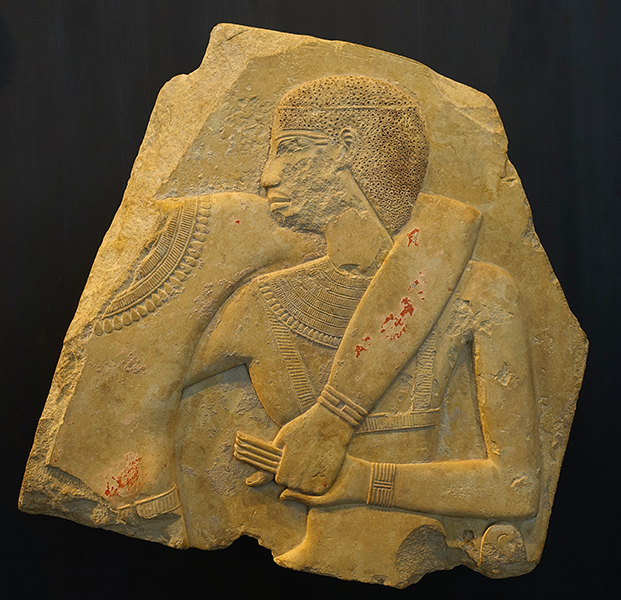
Eleventh Dynasty: 2 134 - 1 991 BC
Relief fragment from the mortuary temple of Pharaoh Mentuhotep II
In particular, it came from the Chapel of Kemsit, one of six wives of Mentuhotep, who, in view of her facial features and curly hairstyle shown here, probably came from Nubia in the south.
Height: 370 mm, Width: 335 mm
Middle Kingdom, 11th dynasty, around 2030 BC
Catalog: Limestone, Deir el-Bahari (Thebes West), ÄS 1621
Photo: Don Hitchcock 2018
Source: Original, Ägyptischen Museum München
Text: © Ägyptischen Museum München
Additional text: http://www.leben-in-luxor.de/luxor_lexikon_museen_smaek2.html, http://www.mentuhotep.de/museen/muenchen/muenchen.htm
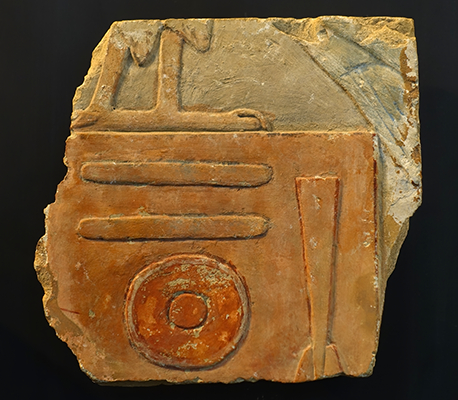
Eleventh Dynasty: 2 134 - 1 991 BC
Relief fragment from the mortuary temple of Pharaoh Mentuhotep II
In particular, it came from the Chapel of Kemsit, one of six wives of Mentuhotep, shown in the fragment further up this page.
Middle Kingdom, 11th dynasty, around 2030 BC.
Catalog:
Deir el-Bahari (Thebes West), Limestone, ÄS 3390, Fragment with remnants of the title Mentuhotep Nebhepetres.
Photo: Don Hitchcock 2018
Source: Original, Ägyptischen Museum München
Text: © Ägyptischen Museum München
Additional text: http://www.leben-in-luxor.de/luxor_lexikon_museen_smaek2.html, http://www.mentuhotep.de/museen/muenchen/muenchen.htm
Eleventh Dynasty: 2 134 - 1 991 BC
Relief fragment from the mortuary temple of Pharaoh Mentuhotep II
In particular, it came from the Chapel of Kemsit, one of six wives of Mentuhotep, shown in the fragment further up this page.
Middle Kingdom, 11th dynasty, around 2030 BC.
Catalog:
Deir el-Bahari (Thebes West), Sandstone, ÄS 1617
Height: 11.5 cm. Width: 12.5 cm, Presentation of the King with the Red Crown.
Photo: Don Hitchcock 2018, 2015
Source: Original, Ägyptischen Museum München
Text: © Ägyptischen Museum München
Additional text: http://www.leben-in-luxor.de/luxor_lexikon_museen_smaek2.html, http://www.mentuhotep.de/museen/muenchen/muenchen.htm
Eleventh Dynasty: 2 134 - 1 991 BC
Relief fragment from the mortuary temple of Pharaoh Mentuhotep II
Middle Kingdom, 11th dynasty, around 2030 BC.
Catalog: ÄS 7114
Origin: Deir el-Bahri; 11. Dynasty
Material: Limestone
Height: 120 mm. Width: 188 mm
Window ornamentation from one of the shrines of the Mentuhotep temple.
Photo: Don Hitchcock 2018
Source: Original, Ägyptischen Museum München
Text: © Ägyptischen Museum München
Additional text: http://www.leben-in-luxor.de/luxor_lexikon_museen_smaek2.html, http://www.mentuhotep.de/museen/muenchen/muenchen.htm
Eleventh Dynasty: 2 134 - 1 991 BC
Relief fragment from the mortuary temple of Pharaoh Mentuhotep II
Middle Kingdom, 11th dynasty, around 2 030 BC.
Catalog: ÄS 7117
Origin: Deir el-Bahri, 11th dynasty
Material: limestone, remains of black paint
Height: 125 mm. Width: 113 mm
Royal figure.
Photo: Don Hitchcock 2018, 2015
Source: Original, Ägyptischen Museum München
Text: © Ägyptischen Museum München
Additional text: http://www.leben-in-luxor.de/luxor_lexikon_museen_smaek2.html, http://www.mentuhotep.de/museen/muenchen/muenchen.htm
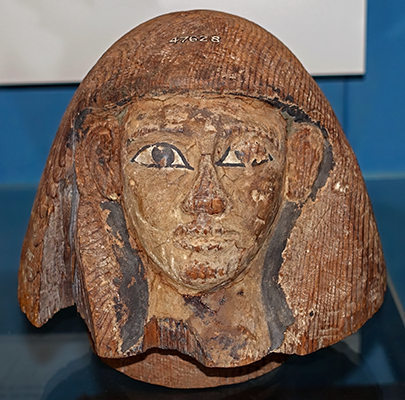
Eleventh Dynasty: 2 134 - 1 991 BC
Canopic jar from the Tomb of Pharaoh Mentuhotep II
Wooden lid in the shape of the head of Pharaoh Mentuhotep II from a Canopic jar.
Height of head 165 mm.
The complete find consisted of this painted wooden head as well as five calcite fragments from a canopic jar.
The jars of Pharaoh Mentuhotep II were made of calcite, but only fragments of them were recovered from his plundered tomb. This lid is the earliest securely datable example in the form of a human head.
Catalog: Painted wood, Deir el-Bahri (Thebes): Temple of Mentuhotep II: Tomb of Mentuhotep II, EA47628
Photo: Don Hitchcock 2018
Source: Original, British Museum
Text: Card with the display at the British Museum, https://www.britishmuseum.org/, © Trustees of the British Museum, CC BY-NC-SA 4.0
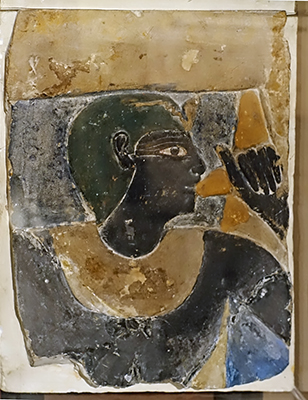
Eleventh Dynasty: 2 134 - 1 991 BC
Pharaoh Mentuhotep II
Pharaoh Mentuhotep II drinks at the udder of Hathor, portrayed as a cow, 2 061 BC - 2 010 BC.
Catalog: Limestone, painted, West Thebes, Deir el-Bahari, Inv. Nr. 1935.200.62
Photo: Don Hitchcock 2018
Source and text: Original, Museum August Kestner, Hannover

Eleventh Dynasty: 2 134 - 1 991 BC
Torc
Flexible torc formed from thin gold disc beads strung on a thick cord which passes through a holed gold cup at each end, circa 2 020 BC.
Diameter 148 mm, height 7 mm.
Curator's comments: A rare form of neck adornment, examples have been found in burials at Deir el-Bahri and Abydos.
Catalog: Gold, fibre, EA3359
Photo: Don Hitchcock 2018
Source: Original, British Museum
Text: Card at museum display, http://www.britishmuseum.org/, © Trustees of the British Museum, CC BY-NC-SA 4.0
Eleventh Dynasty: 2 134 - 1 991 BC
Henut
Rectangular coffin of the woman Henut, Overseer of the Storerooms. Middle period, late 11th Dynasty, circa 2000 BC. Length 2000 mm.
Catalog: Cedar, stuccoed linen, Assiut ÄS 6055
Photo: Don Hitchcock 2018
Source: Original, Ägyptischen Museum München
Text: Museum card, © Ägyptischen Museum München
Eleventh Dynasty: 2 134 - 1 991 BC
Henut
Rectangular coffin of the woman Henut, Overseer of the Storerooms. Middle period, late 11th Dynasty, circa 2000 BC. Length 2000 mm.
( These are the ends and sides of the coffin, made orthogonal so that the designs may be more easily interpreted - Don )
Catalog: Cedar, stuccoed linen, Assiut/Asyut, ÄS 6055
Photo: Don Hitchcock 2018
Source: Original, Ägyptischen Museum München
Text: Museum card, © Ägyptischen Museum München
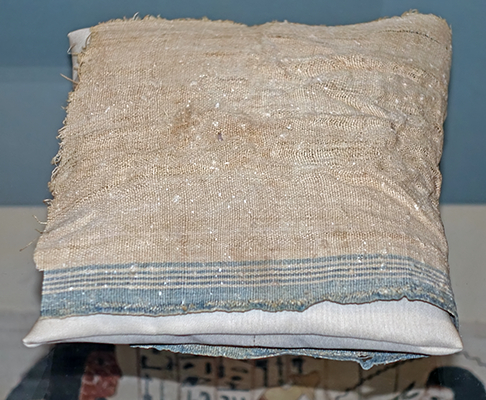
Eleventh Dynasty: 2 134 BC - 1 991 BC
Linen mummy cloth with blue border from the mortuary temple of Pharaoh Mentuhotep II
Late 11th Dynasty, about 2 000 BC.
The woven blue border suggests that this cloth belonged to a piece of domestic linen before its reuse as part of the wrappings of a mummy.
Catalog: Deir el-Bahri, funerary monument of King Mentuhotep II, Tomb 3, EA40923
Photo: Don Hitchcock 2018
Text: Card at museum display © Trustees of the British Museum, CC BY-NC-SA 4.0
Source: Original, British Museum

Eleventh Dynasty: 2 134 BC - 1 991 BC
Female servant
Painted wooden statue of a female servant carrying offerings. Late 11th Dynasty, circa 2 000 BC.
Length 850 mm.
Catalog: Wood, painted in green and black, Deir el-Bahri, funerary complex of Mentuhotep II, Tomb 5, EA41673
Photo: Don Hitchcock 2018
Source: Original, British Museum
Text: Card at museum display © Trustees of the British Museum, CC BY-NC-SA 4.0
Eleventh - Twelfth Dynasty: 2 025 BC - 1 802 BC
Models of two boats.
Note the pilot in each of the boats standing on the prow, directing the rowers which direction to take.
Catalog: Wood, Museumsstiftung Post und Telekommunikation, Museum für Kommunikation Berlin 3.2010.2781 + 2
Photo: Don Hitchcock 2015, 2018
Source: Original, Staatliche Museen zu Berlin, Neues Museum, Germany
Text: © Card at the Staatliche Museen zu Berlin (CC BY-NC-SA 3.0 DE)
Statuettes of the Middle KingdomText above: © Ägyptischen Museum München
In the old kingdom, non-royal statuary was only ever found within a single context: the tomb. Starting in the Middle Kingdom, an additional location was added, namely the temple. As inscriptions attest, the placement of smaller figures of officials, priests, priestesses and their families within the temple was a sign of particular favour from the king.
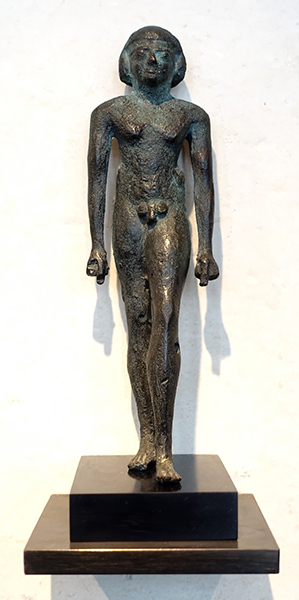
Eleventh - Twelfth Dynasty: 2 025 BC - 1 802 BC
Naked Man
Standing-striding figure of a naked man. Middle Kingdom, circa 2000 BC.
Catalog: Copper / Assiut / ÄS 1591
Photo: Don Hitchcock 2018
Source: Original, Ägyptischen Museum München
Text: © Ägyptischen Museum München
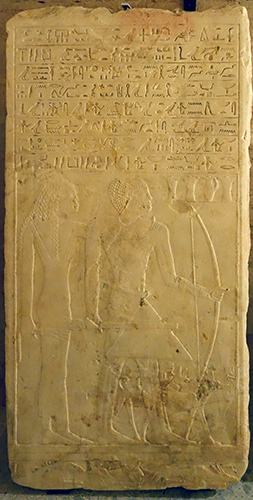
Eleventh - Twelfth Dynasty: 2 025 BC - 1 802 BC
Stela of Kai
Stela of Kai, chief of the desert hunters with his favourite hounds. Middle Kingdom, circa 2000 BC.
Catalog: Kamula (?), limestone, ÄM 22820
Photo: Don Hitchcock 2018
Source: Original, Staatliche Museen zu Berlin, Neues Museum, Germany
Text: © Card at the Staatliche Museen zu Berlin (CC BY-NC-SA 3.0 DE)

Eleventh - Twelfth Dynasty: 2 025 BC - 1 802 BC
Sen-tes-irj and his wife Su-ten-hen-aftenu
The mortuary stela of Sen-tes-irj and his wife Su-ten-hen-aftenu. They stand in front of the offering table with gifts.
This stele dates from the Middle Kingdom around 2 000 BC - 1 700 BC.
Catalog: Inv. No. H 412
Photo: Don Hitchcock 2015
Source and text: Original, Badisches Landesmuseum Karlsruhe Germany
Additional text: http://www.moin-monja.de/egypt/Museen/karlsruhe_museum/karlsruhe_museum-b/karlsruhe_museum-2.htm
Eleventh - Twelfth Dynasty: 2 025 BC - 1 802 BC
Model of a kitchen.
Workers grinding, baking, and brewing.
At the time of the Middle and New kingdoms, flour was made by pounding the grain in large mortars with pestles.
In order to get finer flour, the grain was rolled between two stones, as may be seen in this model.
The stove was a blunted cone of Nile mud, open at the top and about a metre high. The fire was burning on the inside, with flames and smoke coming out of the top, and the cakes were stuck on the outside of the stove, as may be seen here, though there appears to be a lid on the stove in this instance to control the rate of burn, like a damper.
The brewing of beer was a very important part of the kitchen. Beer was the favourite drink of the Egyptian people, and even the deceased in their state of bliss could not get on without beer any more than without bread. The drink was in favour at all times of ancient Egypt.
Catalog: Saqqara, wood, ÄM 1366
Photo: Don Hitchcock 2018
Source: Original, Staatliche Museen zu Berlin, Neues Museum, Germany
Text: © Card at the Staatliche Museen zu Berlin (CC BY-NC-SA 3.0 DE)
Additional text: Erman (1894)
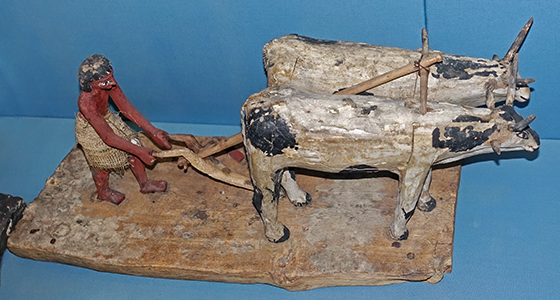
Eleventh - Twelfth Dynasty: 2 025 BC - 1 802 BC
Ploughing
Painted wooden model of peasants ploughing. The plough is drawn by a yoke of oxen. One of the two figures of labourers is missing.
Catalog: Provenance unknown, EA51091
Photo: Don Hitchcock 2018
Source: Original, British Museum
Text: Card at museum display © Trustees of the British Museum, CC BY-NC-SA 4.0
Eleventh/Twelfth Dynasty: 2 025 BC - 1 802 BC
Stela of Usekhu
Stela of the Overseer of the Cabinet, Usekhu
Circa 2 000 BC.
Catalog: limestone, Abydos, ÄS 33
Photo: Don Hitchcock 2015, 2018
Source: Original, Ägyptischen Museum München
Text: © Ägyptischen Museum München, Wikipedia
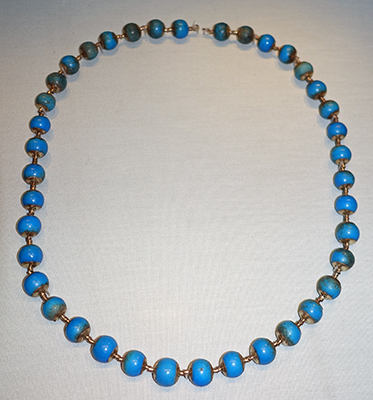
Eleventh/Twelfth Dynasty: 2 025 BC - 1 802 BC
Necklace
Necklace of blue beads, 1 900 BC - 1 800 BC.
Capped beads with a reef-knot clasp. ( see below for a modern version - Don )
A string of thirty-nine bright-blue glazed composition spherical beads capped with silver, and a gold knot-clasp. Some of the beads still have a glassy surface. The caps of silver consist of discs varying slightly in diameter, with a hole in the centre over which a tube is soldered. The tubes cover an inner cylinder made of a rolled length of copper pushed into the opening in the bead.
One bead has a disc missing and only the tube remains. The gold reef-knot clasp is made in two halves, each stamped out. On the underside of one half is a flat plate cut by a central groove. On the flat underside of the other half, mounted on a strip of gold, is a flange which fits into the groove and joins the two halves together.
Diameter 6mm, 15 mm, length 2 millimetres (beads with caps), length 728 mm (whole)
Length 14 mm, width: 10 mm (knot clasp)
Catalog: glazed composition, silver, gold, copper, soldered, stamped, Thebes, EA3084
Photo: Don Hitchcock 2018
Source: Original, British Museum
Text: Card at museum display, http://www.britishmuseum.org/, © Trustees of the British Museum, CC BY-NC-SA 4.0
A modern reef knot clasp, beautifully made, by Outlaws Paradise Horse Hair Jewelry.
Photo: www.etsy.com
Eleventh - Twentieth Dynasty: 2 025 BC - 1 075 BC
Wooden ointment spoons
Catalog: Unidentified, but two of Amarna, Memphis, Theben West, ÄM 4699/4, ÄM 6761, ÄM 12760, ÄM 35431, Z 4402, Z 4404
Photo: Don Hitchcock 2018
Source: Original, Staatliche Museen zu Berlin, Neues Museum, Germany
Text: © Card at the Staatliche Museen zu Berlin (CC BY-NC-SA 3.0 DE)
Colours in Ancient Egypt
Text above: Museum August Kestner, Hannover
Of the maximum of eleven independent colour names that a language - such as any European language - can have, namely black, white, red, yellow, green, blue, brown, violet, pink, grey and orange, the Ancient Egyptian language knew only four proper names for the primary colours: black, white, red and green. For blue and yellow, it used the proper names of the minerals of the same colour, lapis lazuli and orpiment. (Orpiment is a lemon-yellow to golden or brownish yellow orange-yellow arsenic sulphide mineral).
They did not have any words for brown, pink, grey and orange. This does not mean, however, that the Egyptians had a more primitive perception or conception of colours than we have today. It merely proves that what anthropological studies have recently been able to show also applies to Ancient Egypt: early cultures first and accordingly primarily had designations such as light and dark, dry and wet, fresh and old or even smooth and rough as quality characteristics of objects. Only later did they develop their own words for their colourfulness.
Against this background, it is not at all surprising that the Egyptian words for the colours black, white, red and green are also synonyms for dark, light, fiery and fresh. Black was the most important colour in Egypt. The country on the Nile was named after it: Kemet, "The Black". The name was derived from the fertile Nile mud, which for thousands of years was deposited in metre-thick layers in the plain between the desert elevations on both sides of the Nile every year after the summer flooding of the entire river bed.
Thus, black in Egypt was occupied with the most pleasant associations that the country could possibly muster. The Egyptians proudly called themselves "The People of the Black (Land)". In Coptic, the most recent stage of the ancient Egyptian language, the country's name was pronounced Keeme or Cheemi, which has even found its way into our language because of a book of wisdom called 'The Egyptian', which is pronounced similarly: The German word 'Chemie' or chemistry, originally meant nothing more than 'The (ancient) Egyptian wisdom / science'.
If in Ancient Egypt black was endowed with a decidedly positive symbolism, what then took the position of our 'black' with its negative associations? It was the colour red. It was used to designate the desert areas bordered by the fertile, black fields of the Nile plain. The latter was the habitable Egypt, while the desert was the inhospitable, barren expanse where no Egyptian wanted to live. It was the countryside inhabited by predatory Bedouins, i.e. the direct contrast to the native Kemet/Egypt.
Anyone who has ever seen the deserts of Egypt, either the flat Libyan Desert to the west of the Nile or the Arabian Desert to the east of it, will certainly be able to relate to the designation 'red' for the desert as being particularly characteristic. Incidentally, it is the latter, the Eastern Desert of Egypt, which dominates the entire region with mountains up to 2000 m high, that has also given its name to the sea bordering it: 'Red Sea' is short for 'The Sea of the Red (Land)'.
Recently, it has even been suggested that the Indo-European word red (red, rouge) was derived directly from the ancient Egyptian root Rudsch (to be firm/strong) as it occurs in the term "firm/red ore" (Coptic: Ba-Rot). According to this, not only the ancient Egyptian word for 'black' - via a certain diversion into 'chemistry' - but also an ancient Egyptian designation for 'red' - even quite directly and without detours - would have found its way into the modern European languages!
The negative colour red was also associated with the evil god Seth, Lord of the Deserts. He was the brother and murderer of the good god Osiris, the ruler of Egypt and the realm of the dead, whose characteristic colour was black for these two reasons.
The Twelfth Dynasty
The time of this dynasty's rule has been characterised as 'the happiest age of Egyptian history' The second phase of Egyptian civilisation now set in, a phase which is regarded by many as outshining the glories of the first. The first civilisation had subordinated the people to the monarch, and had aimed especially at preserving the memory and setting forth the power and greatness of king after king.
The second had the benefit and advantage of the people for its primary object. It was utilitarian, beneficent, appealing less to the eye than to the mind, farsighted in its aims, and most successful in the results which it effected. The wise rulers of the time devoted their energies and their resources, not, as the earlier kings, to piling up undying memorials of themselves in the shape of monuments that 'reached to heaven', but to useful works, to the excavation of wells and reservoirs, the making of roads, the encouragement of commerce, and the development of the vast agricultural wealth of the country. They also diligently guarded the frontiers, chastised aggressive tribes, and checked invasion by the establishment of strong fortresses in positions of importance.
They patronised art, employing themselves in building temples rather than tombs, and adorned their temples not only with reliefs and statues, but also with the novel architectural embellishment of the obelisk, a delicate form, and one especially suited to the country.
The founder of the Twelfth dynasty, Amenemhat I, deserves a few words of description. He found Thebes in a state of anarchy. Civil war raged on every side, and all the traditions of the past were forgotten. Noble fought against noble, the poor were oppressed, life and property were alike insecure. There was stability of fortune neither for the ignorant nor for the learned man. One night, after Amenemhat I had lain down to sleep, he found himself attacked in his bedchamber. The clang of arms sounded near at hand. Starting from his couch, he seized his own weapons and struck out, when lo! his assailants fled. Detected in their attempt to assassinate him, they dared not offer any resistance, thus showing themselves alike treacherous and cowardly.
Amenemhat, having once taken arms, did not lay them down till he had defeated every rival, and so fought his way to the crown. Once acknowledged as king, he ruled with moderation and equity; he 'gave to the humble, and made the weak to live', he 'caused the afflicted to cease from their afflictions, and their cries to be heard no more', he brought it to pass that none hungered or thirsted in the land, he gave such orders to his servants as continually increased the love of his people towards him.
At the same time, he was an energetic warrior. He 'stood on the boundaries of the land, to keep watch on its borders', personally leading his soldiers to battle, armed with the khopesh (an Egyptian sickle-shaped sword). He carried on wars with the Petti, or bowmen of the Libyan interior, with the Sakti or Asiatics, with the Maxyes or Mazyes of the north-west, and with the Ua-uat and other dark skinned tribes of the south; not, however, as it would seem, with any desire of making conquests, but simply for the protection of his own frontier. With the same object he constructed on his north-eastern frontier a wall or fortress 'to keep out the Sakti', who continually harassed the people of the Eastern Delta by their incursions.
The wars of Amenemhat I. make it evident that by his time Thebes had advanced from the position of a petty kingdom situated in a remote part of Egypt, and held in check by two or more rival kingdoms in the lower Nile valley and the Delta, to that of a power which bore sway over the whole land from Elephantine to the Mediterranean. 'I sent my messengers up to Abu (Elephantine) and my couriers down to Athu' (the coastal lakes), says the monarch in his 'Instructions' to his son — the earliest literary production from a royal pen that has come down to our days; and there is no reason to doubt the truth of his statement. In the Delta alone could he come into contact with either the Mazyes or the Sakti, and a king of Thebes could not hold the Delta without being master also of the lower Nile valley from Coptos to Memphis. We must regard Egypt, then, under the 'twelfth dynasty' as once more consolidated into a single state — a state ruled, however, not from Memphis, but from Thebes, a decidedly inferior position.
Text above adapted from Rawlinson (1886)
The Twelfth Dynasty
1 991 BC - 1 802 BC
| Twelfth Dynasty | ||||||
|---|---|---|---|---|---|---|
| Name | Horus (Throne) Name | Consort | Burial | Years | Dates | Comments |
| Amenemhat I | Sehetepibre | Neferitatjenen | Pyramid of Amenemhat I | 29 | 1 991 BC - 1 962 BC | Amenemhat I made Senusret his co-regent (around the twentieth year of his reign), and was later assassinated |
| Senusret I | Kheperkare | Neferu III | Pyramid of Senusret I | 45 | 1 971 BC - 1 926 BC | Senusret was with his army fighting Libyans when his father was assassinated, and had to return quickly in order to ensure his succession |
| Amenemhat II | Nubkhaure | Kaneferu Keminub |
White Pyramid | 34 | 1 929 BC - 1 895 BC | |
| Senusret II | Khakheperre | Khenemetneferhedjet I Neferet II Itaweret Khnemet |
Pyramid at El-Lahun | 19 | 1 897 BC - 1 878 BC | |
| Senusret III (also known as Sesostris III) |
Khakhaure | Meretseger Neferthenut Khnemetneferhedjet II Sithathoriunet |
Pyramid at Dahshur | 39 | 1 878 BC - 1 839 BC | |
| Amenemhat III | Nimaatre | Aat Hetepi Khnemetneferhedjet III |
Black Pyramid Pyramid at Hawara |
46 | 1 860 BC - 1 814 BC | |
| Amenemhat IV | Maakherure | Southern Mazghuna Pyramid Pyramid at Hawara |
9 | 1 815 BC - 1 806 BC | ||
| Queen Sobekneferu | Sobekkare | Northern Mazghuna Pyramid | 4 | 1 806 BC - 1 802 BC | ||
Twelfth Dynasty: 1 991 BC - 1 802 BC
Pharaoh Senusret I
Circa 1 971 BC - 1 926 BC
This limestone relief was once part of a Middle Kingdom temple at Koptos. It was reused in the Ptolemaic period as foundation material for another building.
The scene depicts the king participating in an important royal ritual called the Sed Festival, being conducted in front of the local deity of Koptos, Min, a fertility god. The festival's purpose was the renewal of the physical and supernatural energies of the ruler.
When this sculpture was first displayed at UCL in 1894, Min's phallus was covered by a label, so as not to offend Victorian sensibilities.
The limestone wall-block has a sunk relief depiction, internally carefully modelled, showing King Senusret I with oar and hepet-tool*, running the sed-festival race before the god Min. Now in five pieces rejoined, and some small fragments.
Collected from Koptos, found face down at the bottom of the Ptolemaic foundations at Koptos temple.
Height 111 cm, width 154 cm, Accession Number LDUCE-UC14786 i-ii.

( The hepet-tool* may have been part of the steering gear on a boat, or may have been a navigational aid. The implement was important enough to have its own hieroglyph, Aa5, shown at left. The use as a navigational aid seems more likely than the hepet being part of the steering gear, since careful examination of the steering gear of the many available images and models of Egyptian boats shows nothing like the hepet - Don )
Photo: Don Hitchcock 2015
Source: Original, Petrie Museum, London, England
Text: Card / online catalogue, the Petrie Museum, © 2015 UCL. CC BY-NC-SA license
Hepet tool hieroglyph: Wikimedia Commons
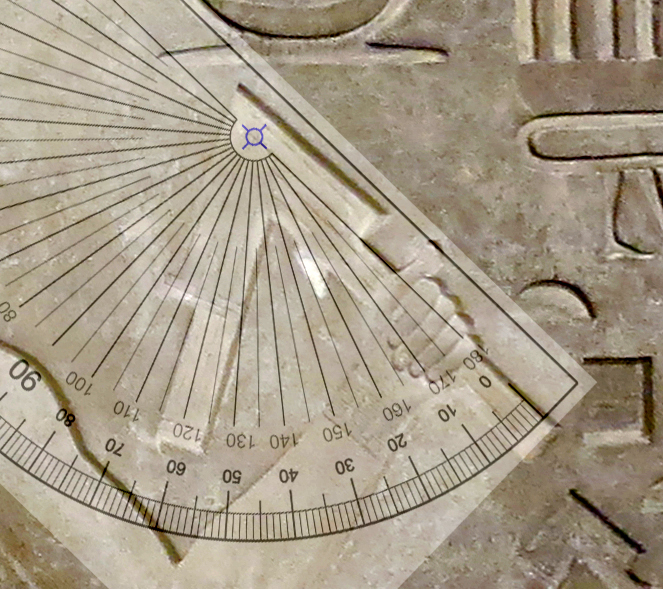
The hepet is tantalisingly similar in shape to the gnomon on a sundial. The angle of the gnomon should be equal to the latitude. At Memphis, often the capital of ancient Egypt, the latitude is approximately 30°N. At Thebes, the occasional southern capital, it is approximately 26°N. The angle of the hepet held by Senusret is 64°, the complement of which is 26°.
Photo and text: Don Hitchcock 2015
Source for base photograph: Petrie Museum, London, England
Twelfth Dynasty: 1 991 BC - 1 802 BC
Kahun Medical Papyrus
Created during the rule of Amenemhat III, circa 1 860 BC - 1 814 BC.
This is part of the 'Kahun Medical Papyrus', with gynaceological content, and contains prognoses, diagnoses and prescriptions for conditions of pregnant women.
The papyrus is written in a short-hand style of hieroglyphs called hieratic. It describes prognoses, diagnoses, and prescriptions for conditions of pregnant women. It is the earliest written mention of the idea that the womb wandered around the body.
Headings of prescriptions are written in red. Hieratic script, in 3 pages, all on recto. Page 1 = 29 lines; p.2 = 30 lines; p.3 = 28 lines.
Verso: short account of Amenemhat III. This papyrus deals with issues related to women’s health surrounding childbirth. The first part deals with various aches and pains and their treatment and the second mostly with issues surrounding conception. Nearly everything is described as originating in the uterus.
Collection at Kahun, Workmens' Town
Material: papyrus paper
Pages 1 and 2: height 357 mm, length 640 mm.
Page 3: height 342 mm, length 438 mm.
Frame: height 380 mm, width 532 mm, depth 7 mm.
Accession Number LDUCE-UC32057i
Photo: Don Hitchcock 2015
Source: Original, Petrie Museum, London, England
Text: Card / online catalogue, the Petrie Museum, © 2015 UCL. CC BY-NC-SA license
Twelfth Dynasty: 1 991 BC - 1 802 BC
Will of Antef Meri
Created during the rule of Amenemhat III, circa 1 860 BC - 1 814 BC.
Deed of conveyance (living will) by Mery son of Intef, for his son Intef (same name as grandfather), on papyrus. As with all inheritance documents, and most legal documents, it concludes with a list of witnesses, from which two names are partly preserved.
Mery wrote this will at an advanced age, when he was about to retire. His will records his wishes regarding the transference of his office to his son and the inheritance of his estate, including all his possessions.
Recto: endorsement on back of right hand edge, 'title to property made by the regulator of the corps, Intef's son Mery, to his son, Mery's son, Intef, called Iuseneb'; hieratic in black ink; papyrus in good condition but frayed at edges. The text has been translated as:
'[Recto] Year 39, month 4 of the season of flood, day 29 Property transfer document made by the Controller of the Temple Staff Intef’s son Mery, also called Kebi, for his son Intef, also called Iuseneb. I am giving my position of Controller of the Temple Staff to Mery’s son Intef, also called Iuseneb, in exchange of his retirement-support, because I am now grown old. Let him be appointed at once. As for the previous document which I made for his mother: it is cancelled. As for my house which is in the district of Hut…t, it is for my children born to me by Nebtennisut, the daughter of the Guard of the District Counselor Sobekemhat, with all its contents. The name list of witnesses in whose presence this property transfer document has been written: The Controller of the Temple Staff: Sa-bastet’s son, called Sa-bastet as well, The (?) Senusret’s son, called Senebubu [Verso] Property transfer document made by the Controller of the Temple Staff Intef’s son called Mery for his son Intef, also called Iuseneb.
Collected at Lahun, Kahun Workmens' Town
Fragment Recto height 187 mm. Recto: Length 350 mm, height 187 mm (As mounted in glass)
Verso: length 47 mm, height 56 mm.
Fragment recto length 350 mm, fragment verso height 56 mm, fragment verso length 47 mm.
Frame height 270 mm, width 370 mm, depth 6 mm, Accession Number LDUCE-UC32037
Photo: Don Hitchcock 2018
Photo: Don Hitchcock 2015
Source: Original, Petrie Museum, London, England
Text: Card / online catalogue, the Petrie Museum, © 2015 UCL. CC BY-NC-SA license

Twelfth Dynasty: 1 991 BC - 1 802 BC
Great sphinx found in Tanis, of granite.
Height 183 cm, length 480 cm, width 154 cm.
The sphinx is a monstrous being, with a lion's body and a king's head. It was inscribed successively with the names of the kings Amenemhat II (1 898 - 1 866 BC, 12th Dynasty), Merenptah (1 213 - 1 203 BC, 19th Dynasty) and Chechonq I (945 - 924 BC, 22nd dynasty). Archaeologists see in some details the index of a later period, the Old Kingdom (around 2 600 BC).
According to archaeologists, certain details suggest that this sphinx dates to an earlier period - the Old Kingdom (c. 2600 BC). Tanis.
This is one of the largest sphinxes outside of Egypt. It was found in 1825 among the ruins of the Temple of Amun at Tanis (the capital of Egypt during the 21st and 22nd dynasties). This impressive stone sculpture with its precise details and polished surfaces is a work of admirable craftsmanship. The recumbent lion, with tense body and outstretched claws, gives the impression of being ready to leap.
The shen hieroglyph sculpted on the plinth under each paw evokes a cartouche, confirming the royal nature of the monument. Modifications The legible inscriptions are all 'usurpations', i.e. traces of subsequent modifications to the monument. The names of Merneptah (19th Dynasty) and Sheshonq (22nd Dynasty) are legible. The original texts (traces of which are still visible in places) were deliberately erased and replaced. It is therefore impossible to date this statue with certainty, especially as the face does not resemble any known, well-documented royal portrait. In view of this uncertainty, Egyptologists are divided: some date the sphinx to the 12th Dynasty, others to the 6th or even the 4th.
Catalog: Granite, A 23, Sully, Entresol, Crypte du sphinx, Salle 338
Photo: Don Hitchcock 2015, 2018
Source and text: Original, Musée du Louvre
Additional text: http://cartelfr.louvre.fr/
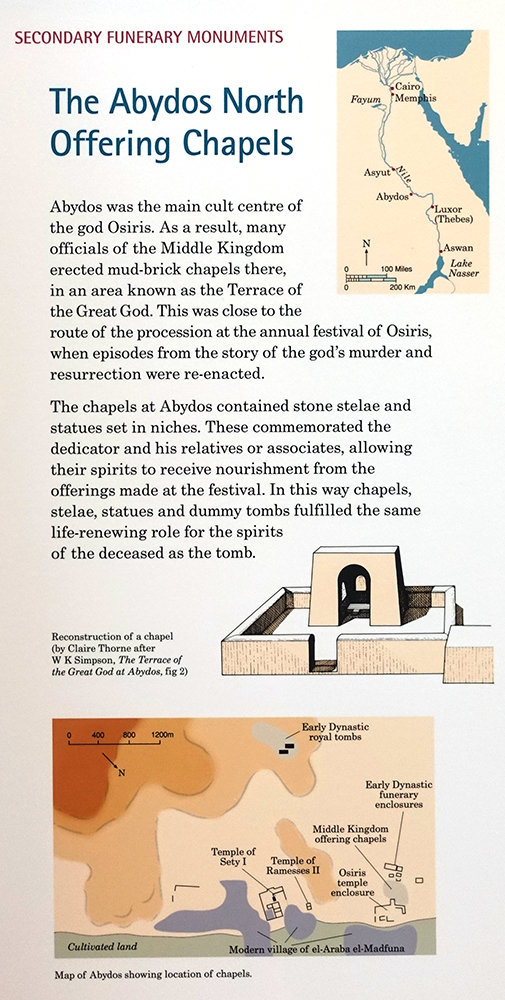
Twelfth Dynasty: 1 991 BC - 1 802 BC
Abydos
Abydos was the main cult centre of the god Osiris. As a result, many officials of the Middle Kingdom erected mud-brick chapels there, in an area known as the Terrace of the Great God. This was close to the route of the procession at the annual festival of Osiris, when episodes from the story of the god's murder and resurrection were re-enacted.
The chapels at Abydos contained stone stelae and statues set in niches. These commemorated the dedicator and his relatives or associates, allowing their spirits to receive nourishment from the offerings made at the festival.
In this way chapels, stelae, statues and dummy tombs fulfilled the same life-renewing role for the spirits of the deceased as the tomb.
Source: Poster, British Museum
Text: Poster at the British Museum, © Trustees of the British Museum, CC BY-NC-SA 4.0

Twelfth Dynasty: 1 991 BC - 1 802 BC
Gold Amulet
Gold amulet, very fine. A cylinder with gold casing on a copper core. 3 600 small globules of gold soldered on to a casing to form a series of triangles, with a loop on one end for suspension. The interior is hollow, in which conservation revealed three copper wire balls (one in pieces) and organic material, now stored separately in a capsule. One of the earliest and finest examples of granulation.
Collected at Harageh, tomb 211, excavation by Suefi, Ali Muhammad, Haregehm XIV, 5; O.D.U. 11, 9
Length 52 mm, Accession Number LDUCE-UC6482
Photo: Don Hitchcock 2018
Source: Original, Petrie Museum, London, England
Text: Card / online catalogue, the Petrie Museum, © 2015 UCL. CC BY-NC-SA license
Twelfth Dynasty: 1 991 BC - 1 802 BC
Magic Wand
Length 370 mm.
Hippopotamus ivory wand with incised representations of deities.
At the same time that artists began to depict demons in Middle Kingdom (ca. 2 030 BC – 1 640 BC) tombs, carvings of these beasts also appeared on a type of artefact Egyptologists have dubbed 'magic wands'. Some 230 of these curved objects, usually made of highly polished hippopotamus ivory and resembling the shape of tusks, are known. Though many are worn from use, it is clear that most were incised with depictions of demons wielding knives. Some Egyptologists believe the ancient Egyptians imagined the wands themselves as magic knives. High-status Egyptians who could afford them wielded these powerful instruments against supernatural forces by calling upon the power of the demons to ward off evil. It is possible the Egyptians of the Middle Kingdom developed these wands as a response to the period of religious and ideological uncertainty that followed the collapse of the Old Kingdom (circa 2 649 BC – 2 150 BC). With the memory that traditional centres of power and religion had been in disarray, perhaps these wands gave some high-ranking Egyptians the confidence to tap into the power of demons and keep the forces of chaos at bay.
Egyptologist Frank Vink notes that some Middle Kingdom spells intended to be recited during pregnancy and throughout early childhood include a word that scholars interpret as 'amulet.' Perhaps, Vink suggests, magic wands were the amulets being cited in these spells. Tauret, the powerful hippopotamus goddess, was associated with childbirth, and the fact that most of the wands were made from hippopotamus tusks might link them to her special role as the protector of mothers and young children. One example of a Middle Kingdom magic wand has a cord still attached to it that could be worn around the neck. It’s possible that mothers and children alike wore these objects as amulets to call upon knife-wielding demons to protect them during the most vulnerable periods of their lives, and these magic wands are also called amuletic wands.
Catalog: Thebes, EA18175
Photo: Don Hitchcock 2018
Source: Original, British Museum
Text: www.britishmuseum.org/research/ and card at the Museum, © Trustees of the British Museum, CC BY-NC-SA 4.0
Additional text: www.archaeology.org
Date uncertain: 2 033 BC - 1 710 BC (Middle Kingdom)
Magic Wand
Length 370 mm.
Amuletic wand in hippopotamus ivory with incised detail. There is an ancient break and binding-holes for an ancient repair.
Length 305 mm, width 110 mm, thickness 7 mm, weight 150 gm.
Catalog: Thebes, EA24426
Photo: Don Hitchcock 2018
Source: Original, British Museum
Text: www.britishmuseum.org/research/ and card at the Museum, © Trustees of the British Museum, CC BY-NC-SA 4.0
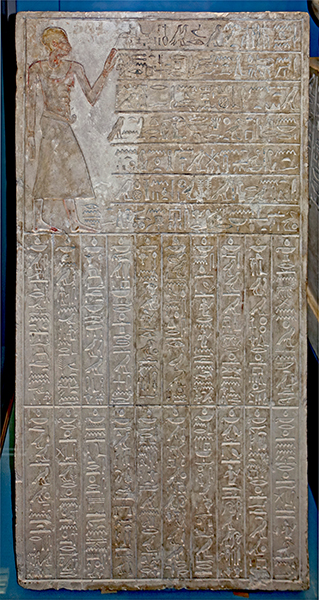
Twelfth Dynasty: 1 991 BC - 1 802 BC
Chamberlain Intef
Stela from the chapel of Intef at Abydos North, circa 1 965 BC - 1 920 BC
This stela and other monuments such as the statue were set up in a chapel on the Terrace of the Great God. They are inscribed for the chamberlain Intef, son of Sebekunu. Intef's mother Senet and his wife Hepu are also named in the texts.
At the top is a figure of Intef with a text in which he records the building of his chapel and praises the sacred land of the Abydos necropolis. Below is an autobiographical text recommending Intef to the gods and to those who might visit the chapel. This records Intef's good qualities including mercy, generosity, efficiency in his office and providing for the hungry.
Height 650 mm, thickness 80 mm, width 360 mm.
Catalog: Limestone stela, Chapel of Intef at Abydos North, EA5815
Photo: Don Hitchcock 2018
Source: Original, British Museum
Text: Card with the display at the British Museum, https://www.britishmuseum.org/, © Trustees of the British Museum, CC BY-NC-SA 4.0
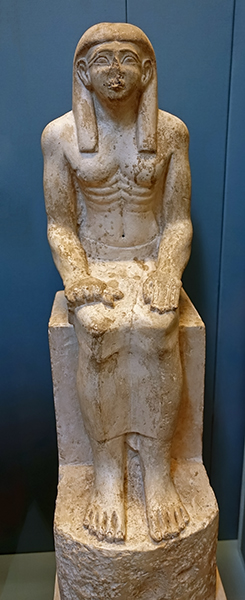
Twelfth Dynasty: 1 991 BC - 1 802 BC
Chamberlain Intef
Limestone seated statue of Intef, from the chapel of Intef at Abydos North, circa 1 965 BC - 1 920 BC
Intef wears a wig and a long kilt. The rolls of fat on his abdomen are a sculptor's convention to indicate Intef's high status, with the associated privileges of abundant food and a sedentary lifestyle.
( to me, the 'rolls of fat' look more like a six-pack (well developed abdominal muscles) as on an athlete. Intef shows no other sign of being overweight. His waist is small, and he looks fit and well - Don )
Height 720 mm, width 190 mm, depth 290 mm.
Catalog: Limestone statue, Chapel of Intef at Abydos North, EA5815
Photo: Don Hitchcock 2018
Source: Original, British Museum
Text: Card with the display at the British Museum, https://www.britishmuseum.org/, © Trustees of the British Museum, CC BY-NC-SA 4.0
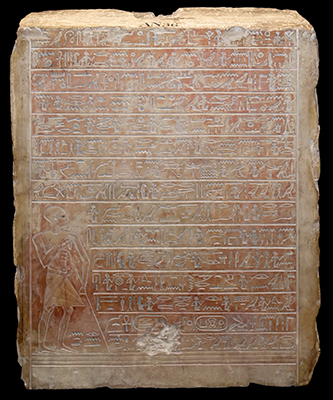
Twelfth Dynasty: 1 991 BC - 1 802 BC
Chamberlain Intef
Lower part of a limestone stela of Intef at Abydos North, circa 1 965 BC - 1 920 BC
It displays fifteen rows of hieroglyphic text including the cartouches of Senusret I. There is a representation of the deceased in the lower left-hand corner, leaning on a staff.
Height 590 mm, width 500 mm, thickness 150 mm.
Catalog: Limestone stela, Chapel of Intef at Abydos North, EA562
Photo: Don Hitchcock 2018
Source: Original, British Museum
Text: Card with the display at the British Museum, https://www.britishmuseum.org/, © Trustees of the British Museum, CC BY-NC-SA 4.0
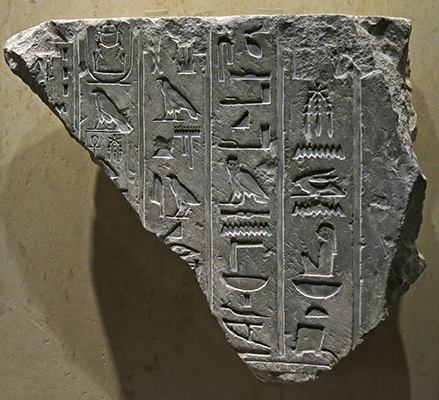
Twelfth Dynasty: 1 991 BC - 1 802 BC
Senusret I
Fragment of an inscription naming Pharaoh Senusret I / Sesostris I, circa 1 950 BC.
Photo: Don Hitchcock 2015
Catalog: Limestone, Saqqara, unknown catalog number
Source: Original, Ägyptischen Museum München
Text: Museum card, © Ägyptischen Museum München
Twelfth Dynasty: 1 991 BC - 1 802 BC
Stele of Imenemhat
Circa 1 963 BC - 1 862 BC
Stele of the carpenter Imenemhat, Abydos El-Araba el-Madfouna, West bank of Assiout to Thebes.
Arched stele with two registers.
First register: funeral meal. Man (loincloth, close-cropped hair, seated, front), offering table.
Second register: funeral meal. Couple (seated, front), offering table, woman (standing, one-strap dress, tripartite wig, breathing ( or speaking? - Don ), lotus flower), saw, chest, house.
Decor: saw, axe, tools, chest, box, furniture, instruments.
Hieroglyphic text: Osiris register (Busiris); Khenty-Imentyou (Abydos); Imenemhat; Itefankh (mother); Imenaa (Imenouaou?, son)
Satimen (sister); Imenemhat; Sénouseret (father); Bebiankh (wife); Semekhsen (son, nephew)
Height 380 mm, width 220 mm, thickness 50 mm.
Photo: Don Hitchcock 2018
Catalog: Painted limestone, Abydos El-Araba el-Madfouna, Room 334, Sully Wing, Level 0, Vitrine 9, C 302 or E 13055
Source and text: Original, Louvre Museum, Paris, France, collections.louvre.fr
Twelfth Dynasty: 1 991 BC - 1 802 BC
Knife, similar to that shown on the stele of Imenemhat above.
( The above comment comes from the Catalog, but the image of the knife on the stele eludes me. I can find a saw and an axe, however, in the lowest register - Don )
Length 245 mm.
Photo: Don Hitchcock 2018
Catalog: Copper alloy, Room 334, Sully Wing, Level 0, Vitrine 9, E 11231
Source and text: Original, Louvre Museum, Paris, France, collections.louvre.fr
Ancient Egyptian bronze gouges used for woodworking.
( I have no other information about these tools - Don )
Photo: Don Hitchcock 2018
Source: Originals, Louvre Museum, Paris, France
Ancient Egyptian bronze axe heads used for woodworking.
( I have no other information about these tools - Don )
Photo: Don Hitchcock 2018
Source: Originals, Louvre Museum, Paris, France
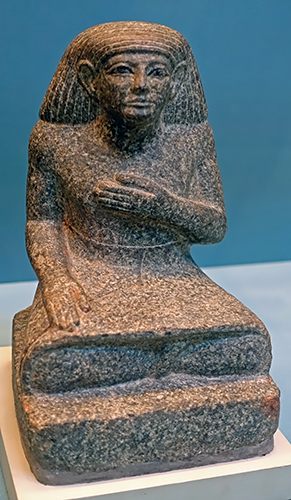
Twelfth Dynasty: 1 991 BC - 1 802 BC
Male Figure
Green porphyry (granite?) male figure seated cross-legged; black painted eye-detail; scribal pose. Dated by Biri Fay (pers. comm.) to second half of 12th Dynasty, reign of Senusret III / Senwosret III, 1 878 BC - 1 839 BC
The kneeling pose and the position of the hand on the breast are characteristic of Middle Kingdom sculptures of private individuals.
Height 225 mm, width 145 mm, depth 150 mm.
Base: Height 25 mm, width 160 mm, depth 170 mm.
Catalog: Green porphyry (granite?), EA2308
Photo: Don Hitchcock 2018
Source: Original, British Museum
Text: Card with the display at the British Museum, https://www.britishmuseum.org/, © Trustees of the British Museum, CC BY-NC-SA 4.0
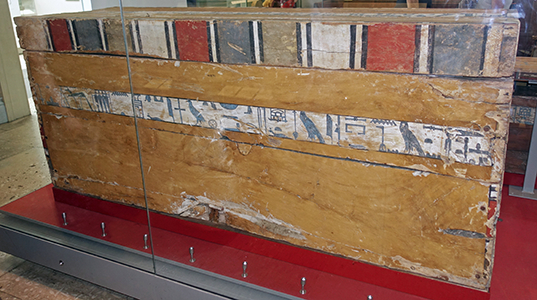
Twelfth Dynasty: 1 991 BC - 1 802 BC
Outer coffin of Sebekhetepi
This massive outer coffin of Sebekhetepi, also listed as Sobekhotep, circa 2040 BC - 1750 BC, is constructed from sycomore fig, a native Egyptian timber widely used for the making of objects for the tomb. The sparsely decorated exterior is inscribed with formulae requesting offerings from the gods Osiris and Anubis. A pair of eyes painted on the long side which faced east in the tomb enabled the dead man to look out towards the rising sun. ( note that this view shows the opposite, western side - Don ) The inner surfaces of the coffin are also painted with friezes of offerings and inscriptions.
Height 864 mm, width 635 mm, length 2038 mm.
Catalog: 41571
Photo: Don Hitchcock 2018
Source: Original, British Museum
Text: Card at the British Museum © Trustees of the British Museum, CC BY-NC-SA 4.0
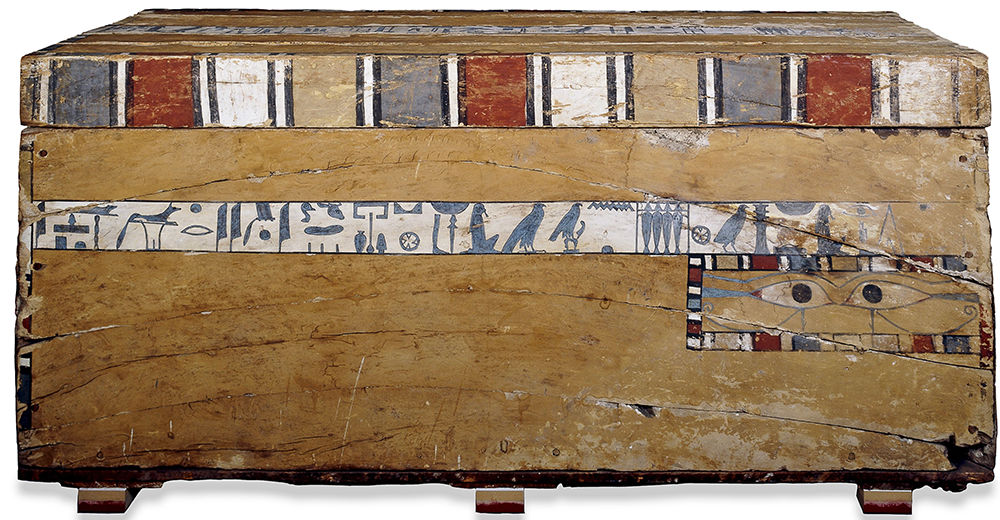
Twelfth Dynasty: 1 991 BC - 1 802 BC
Outer coffin of Sebekhetepi
The outer coffin of Sebekhetepi is constructed from sycomore fig, a type of wood which was locally available. It is used extensively throughout this funerary equipment. Unlike other outer coffins, where the decoration is usually juxtaposed with the plain wood, the exterior of the Sebekhetepi's coffin is painted yellow. In ancient Egypt yellow was associated with the sun, and a substitute for gold.
The main features of the external decoration are the border in red, blue-green and white, and the wedjat eyes. These eyes were placed on one of the long sides of the coffin, which would have faced east. This was so that the deceased, placed on his side within the coffin, could watch the sun rise. The inscriptions are in pale blue, a colour often chosen for hieroglyphs, against a white background. They consist of the request for offerings from the funerary gods Osiris and Anubis, typical of the coffins of the Middle Kingdom (about 2040 BC - 1750 BC).
Catalog: 41571
Photo: © Trustees of the British Museum, CC BY-NC-SA 4.0
Source: Original, British Museum
Text: © https://www.google.com/culturalinstitute/beta/asset/outer-coffin-of-sebekhetepi/cAF-9XfxmLucxg?hl=en
Twelfth Dynasty: 1 991 BC - 1 802 BC
Outer coffin of Sebekhetepi
The decoration of the interior is also austere. It consists of friezes of offerings, and inscriptions taken from the Coffin Texts. However, it has no maps of the Underworld, which appear on the outer coffin of Gua (also in The British Museum, see below in the section on the Twelfth Dynasty).
Catalog: 41571
Photo: (top left) © Trustees of the British Museum, CC BY-NC-SA 4.0
Photo: (top right, lower left) Don Hitchcock 2018
Source: Original, British Museum
Text: © https://www.google.com/culturalinstitute/beta/asset/outer-coffin-of-sebekhetepi/cAF-9XfxmLucxg?hl=en

Twelfth Dynasty: 1 991 BC - 1 802 BC
Inner coffin of Sebekhetepi
Sebekhetepi's inner coffin is of finer construction than the outer case, and is constructed from the more expensive cedarwood, which was pre-eminent among imported timbers used by the Egyptians. The exterior is decorated with a pair of eyes and with inscriptions, which, like those of the outer coffin, request offerings from Osiris and Anubis. Similar texts are painted on the interior, together with images of offerings.
Height 458 mm, width 406 mm, length 1873 mm.
Catalog: 41572
Photo: Don Hitchcock 2018
Source: Original, British Museum
Text: Card at the British Museum © Trustees of the British Museum, CC BY-NC-SA 4.0
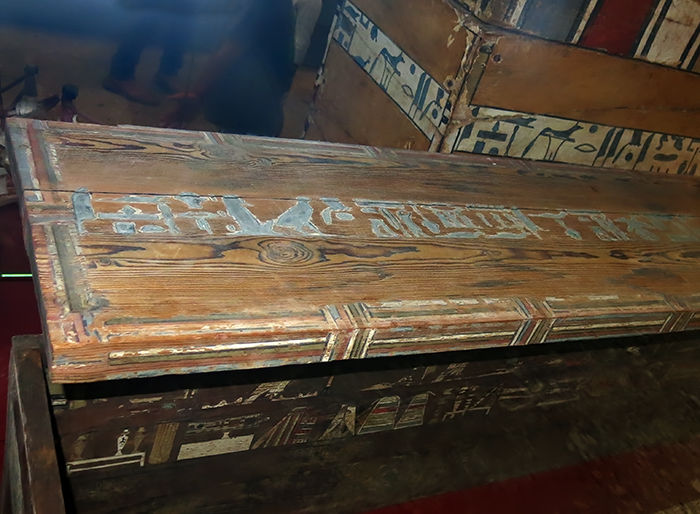
Twelfth Dynasty: 1 991 BC - 1 802 BC
Lid of the inner Coffin of Sebekhetepi
The lid of the inner coffin of Sebekhetepi, seen from above, and the end of the outer coffin.
Catalog: 41572
Photo: Don Hitchcock 2015
Source: Original, British Museum
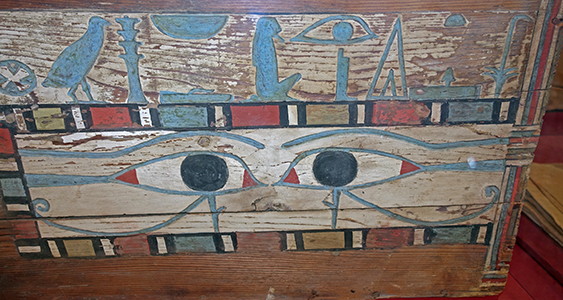
Twelfth Dynasty: 1 991 BC - 1 802 BC
Inner coffin of Sebekhetepi showing the Wadjet eyes in close up.
Like many wealthy individuals of the Middle Kingdom (circa 2040 BC - 1750 BC), Sebekhetepi was buried in two rectangular coffins. The inner coffin was made of imported cedarwood, which was of much higher quality than that of local trees. The palm tree, the most common in Egypt, does not consist of wood as such, but coarse fibres, which are unsuitable for carpentry.
The decoration on the exterior of this coffin is cut into the wood, and painted. The inscriptions running down the centre of the lid and around the top of the case are written in blue on a white band. The edges of the lid and corners of the case are decorated with long striped bands separated by perpendicular short bands in the same colours. The large wedjat eyes on one side are similarly in blue against a white background, surrounded by a multicoloured border. These enabled the mummy, placed on its side so it faces the wedjat eyes, to see out of the coffin. The inside of the coffin is decorated with representations of offerings.
Catalog: EA41572
Photo: Don Hitchcock 2018
Source: Original, British Museum
Text: © https://www.google.com/culturalinstitute/beta/asset/outer-coffin-of-sebekhetepi/cAF-9XfxmLucxg?hl=en

Twelfth Dynasty: 1 991 BC - 1 802 BC
Sandals of Sebekhetepi
These sandals, 253 mm long, were found lying on the lid of the inner coffin, above the feet of the corpse. They are made of cedar wood with leather straps, coated with white plaster. This delicate constructional technique shows that they could not have been worn in life, and hence were made specifically for the tomb.
Catalog: 41578
Photo: Don Hitchcock 2018
Source: Original, British Museum
Text: Card, British Museum, https://www.britishmuseum.org/, © Trustees of the British Museum, CC BY-NC-SA 4.0
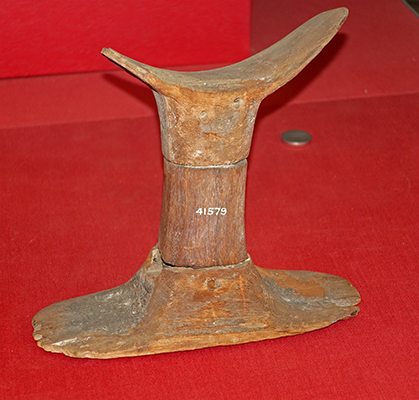
Twelfth Dynasty: 1 991 BC - 1 802 BC
Headrest of Sebekhetepi
Headrest found in the tomb of Sebekhetepi. It is constructed of sycomore fig, and is made of three parts joined together.
Height 160 mm, length 210 mm.
Catalog: 41579
Photo: Don Hitchcock 2018
Source: Original, British Museum
Text: Card, British Museum, https://www.britishmuseum.org/, © Trustees of the British Museum, CC BY-NC-SA 4.0

Twelfth Dynasty: 1 991 BC - 1 802 BC
Linen sheet of Sebekhetepi
This large fringed sheet of linen was probably originally part of the household linen of Sebekhetepi's family. Linen items were sometimes included in burials, for use in the Afterlife. The fact that these are often threadbare and darned suggests that they had been heavily used before being placed in the tomb.
Few examples of textiles have been found in a domestic setting; most come from burials, either for use in the Afterlife, or torn up and used as wrappings on the mummy. Fragments of cloth can provide a great deal of information. Some bandages have been torn from loincloths, tunics and other items of clothing. One individual was even wrapped in a torn-up sail.
The fabric is woven of relatively coarse threads, which would not have been suitable for most items of clothing or ritual cloth. The cloth used in temples and for the garments of the king were of the finest weave.
The fringe is sewn on to the fabric, rather than being the loose warp threads, which are hemmed. The brown discolouration is probably staining from the cellulose in the flax plant, which bonded the fibres together so that it could be spun into thread.
Width 105 cm, length 137 cm.
Catalog: 41580
Photo: Don Hitchcock 2018
Text: http://www.bmimages.com/results.asp?image=00032897001, © Trustees of the British Museum, CC BY-NC-SA 4.0
Source: Original, British Museum
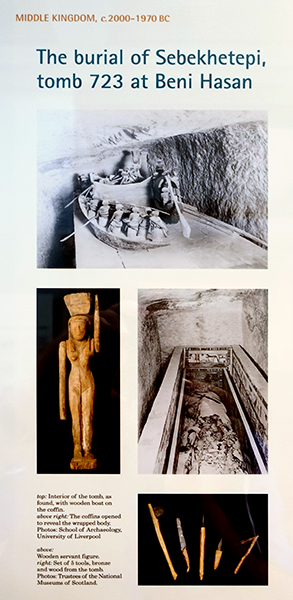
Twelfth Dynasty: 1 991 BC - 1 802 BC
The Burial of Sebekhetepi
Photo: Poster at the British Museum, © Trustees of the British Museum, CC BY-NC-SA 4.0
Rephotography: Don Hitchcock 2018
Source: From photographs and text © Trustees of the National Museum of Scotland, and © School of Archaeology, University of Liverpool
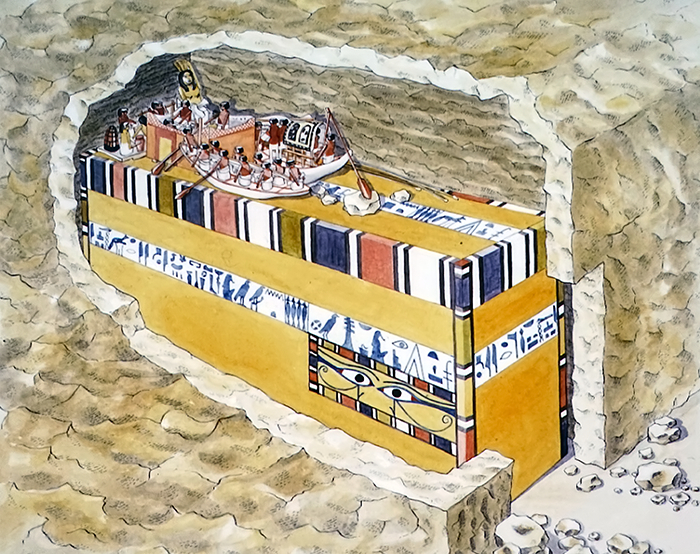
Twelfth Dynasty: 1 991 BC - 1 802 BC
The Burial of Sebekhetepi
The interior of Tomb 723 as found.
Artist and reconstruction: C. Thorne
Photo: Poster at the British Museum, © Trustees of the British Museum, CC BY-NC-SA 4.0
Rephotography: Don Hitchcock 2018

Twelfth Dynasty: 1 991 BC - 1 802 BC
Sail boat of Sebekhetepi / Sobkhetepi
Models of boats were a regular feature of tomb assemblages from the end of the Old Kingdom to the mid Twelfth Dynasty. In many tombs, two boats were provided, equipped in the manner of Nile river craft when travelling north or south. Hence one is represented propelled by oars alone, for journeys downstream, the other with the sail set, to catch the northerly winds when travelling upstream.
When found, the mast, sail and rigging were folded down. Under a canopy, on the roof of which are painted depictions of shields, sits the owner with two boxes or storage chests. At the stern sits the helmsman who originally operated the tiller (lost), attached to the steering oar. In the bows stands the pilot. Three of the crew are hauling on the rigging, while two others are depicted using poles (lost), as if levering the boat off a sandbank - a regular obstacle to navigation on the Nile.
Wooden model of sailing-boat: the hull is rather narrow, with moderate sheer; bow lower and more narrow than stern, which has notch for steering-oar; exterior devoid of paint. Deck flush and not cambered, so that raised gunwales are absent; painted white with deck-plan and outer edges in red. The painted centre-strip runs the full length of the vessel; the fore-deck is marked only by a normal painted thwart, but the after-deck is marked by an exceptionally broad painted band. There are seven white rectangles on each side; the midships pair are separated by the usual mast-space. The point of the fore-deck is painted black.
In the after part of the vessel is an open-sided cabin, consisting of a rounded top supported on either side by four posts, the latter strengthened each side with a single cross-piece tied to them about half-way up. The rounded roof is yellow edged with black to represent leather strips which have white markings edged with black to indicate the lashings which hold them in place; the roof of the cabin is also decorated on each side with two paintings of round-topped shields, alternately white with black markings and black with white markings. The cabin is open to the stern. Immediately abaft the cabin stands a steering-post which has been trimmed roughly to an octagonal section but has no groove on top. To it was lashed the butt of the steering-oar, which was also lashed to the notch on the stern; the present lashings are modern.
The tiller was broken off, only the stump remaining. In the bows stands the pilot with right arm extended and left hanging down. Between mast and cabin stand three sailors hauling on the rigging, while forward of the mast are two other members of the crew facing aft and heaving on quant-poles as if to push the boat off a sandbank; they are leaning forward with almost straight bodies, one arm and shoulder pressing on the quants while their disengaged arms are supposed to be pressing on the deck to obtain greater leverage; actually the hands do not quite touch the deck.
The human figures on board have red bodies, white skirts, and short black wigs; it is noticeable that both the men working the rigging and those pushing on the quants have their legs well separated so as to get a good purchase on the deck. The helmsman sits in the stern, left arm at 45 degree with the body, right arm straight in front to grasp the tiller, which is missing; the stump is sticking out of the hole in the shaft of the steering-oar.
In the cabin squats the figure of the owner of the boat; he has his right arm forward at an angle of about 45 degrees and his left arm slightly forward. Behind him are two round-topped travelling trunks placed one on top of the other and painted red and yellow. All the standing sailors except the pilot, as well as the owner, still have the remains of the original fabric skirts. No facial features carved except noses; eyes are painted on. Arms are pegged to shoulders and cut off straight at ends; hands are not shaped.
Height 530 mm, length 698 mm, length 870 mm, depth 310 mm (the BM gives two lengths for the boat)
As received by the Museum the mast and rigging were in disorder, but photographs taken by the excavator on the site show that the mast, yards and rigging, and the rolled-up sail originally rested in part on the cabin top and in part on the figures of the crew. The spars are slight twigs with much of the original bark and the minimum of trimming, and the same comment applies to two quant-poles on which men are shown as pushing; these were 'in situ' when the boat was found.
The boat comes from the tomb of Sobkhetepi (no. 723), and was found lying on top of the outer wooden coffin, together with a second boat, a model granary, a model of brewing, baking and butchering, and a wooden figure of a serving-girl with a basket on her head (not in the collection).
Catalog: EA41574
Photo: Don Hitchcock 2018
Source: Original, British Museum
Text: Card at the British Museum, http://www.britishmuseum.org/, © Trustees of the British Museum, CC BY-NC-SA 4.0

Twelfth Dynasty: 1 991 BC - 1 802 BC
Row boat of Sebekhetepi
Painted wooden model of a boat propelled by oars. The crew of the boat comprises four pairs of oarsmen, a pilot and a helmsman. When found, this boat, like its companion, was provided with a mast, sail and rigging, which have not survived.
Wooden model boat under oars. The solid hull has a slight sheer sloping sharply up to the stern, which has a small block notched for a steering-oar. Gunwales, thwarts, and the central deck-strip are painted in red on a white deck, with seven white rectangles on each side and a small mast-space.
The point of the fore-deck is painted black, the exterior of the hull in white. A steering-oar with tiller and steering-post were present originally. The oar was secured to the notch in the stern but not to the steering-post.
Four oars belonging to this boat were found in the tomb; only one was found actually in place, in the hands of the third rower from forward on the starboard side, but the excavator replaced the three loose oars in the hands of the other starboard rowers.
The pilot is seated in the bows facing forward with right arm extended at an angle of about 40 degrees, as if using a sounding-pole ( or a quant for poling - Don ), and the left arm is hanging down.
There are four pairs of rowers amidships. The helmsman is aft in the same attitude as the pilot. Owing to the fact that the steering-oar was not secured to the steering-post as it should have been, the helmsman did not in fact hold the tiller as his attitude suggests.
The bodies of the crew are red, their features are roughly indicated and the eyes are painted on in white and black, the wigs are black, and the skirts white. All the crew except the helmsman when found still had fabric skirts as well. The arms and hands of crew are represented by straight bars of wood pierced with holes to take the butts of oars, and are pegged and glued (?) to the shoulders. Skirts and legs are represented by solid blocks carved in one piece as trunks and are painted white.
This boat had suffered losses before reaching the Museum. Photographs taken 'in situ' show that originally the mast, yards, rigging, and furled sail were laid horizontally on the shoulders of the rowers and the spars are thin twigs with much of their original bark.
Catalog: EA41575
Photo: Don Hitchcock 2018
Source: Original, British Museum
Text: Card at the British Museum, http://www.britishmuseum.org/, © Trustees of the British Museum, CC BY-NC-SA 4.0
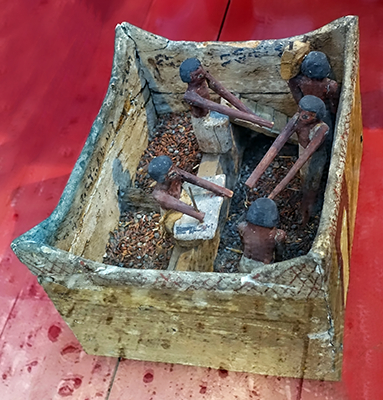
Twelfth Dynasty: 1 991 BC - 1 802 BC
Granary of Sebekhetepi
Wooden funerary model of a granary, made of painted wood and grain, comprising a granary and five figures, from the tomb of the official Sebekhotep. The model building has a doorway painted red and yellow ( on the right - Don ).
A ladder leads between two levels (its original position is not certain). The granary is filled with grain and juniper berries. Workmen on the lower level handle grain, one of them carrying a sack.
A scribe sits on the upper level recording on a writing board the amounts of grain being stored or issued; a representation of his palette is painted onto the writing board beside his hand. Beside him sits a figure apparently directing the workmen below. There are hieratic jottings on the walls. These perhaps recorded different amounts and types of grain, but are now illegible.
Height 210 mm, widthe 300 mm, depth 358 mm.
Catalog: EA41573
Photo: Don Hitchcock 2018
Source: Original, British Museum
Text: Card at the British Museum, http://www.britishmuseum.org/, © Trustees of the British Museum, CC BY-NC-SA 4.0
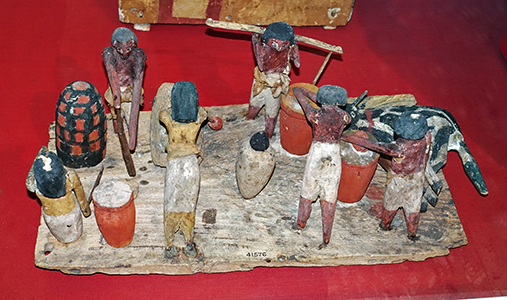
Twelfth Dynasty: 1 991 BC - 1 802 BC
Wooden model from the tomb of Sebekhetepi
Painted wooden model representing baking, brewing, and butchery, from the tomb of Sebekhetepi at Beni Hasan, Middle Kingdom, 2125-1795 BC.
A group of wooden servant figures, originally dressed in miniature linen garments, are shown engaged in the preparation of food and drink for the deceased. A man pounds grain in a mortar, while a squatting woman tends the bread oven, and a second woman grinds grain on a quern.
One man strains mash into a vat to make beer, while another carries two jars suspended from a yoke. A butcher slaughters a trussed ox with a knife.
Catalog: EA41576
Photo: Don Hitchcock 2018
Source: Original, British Museum
Text: Card at museum display © Trustees of the British Museum, CC BY-NC-SA 4.0
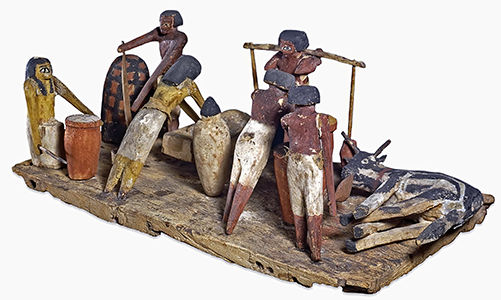
Twelfth Dynasty: 1 991 BC - 1 802 BC
Wooden model from the tomb of Sebekhetepi
Six figures engaged in brewing and butchering from tomb 723 of Sebekhetepi at Beni Hasan, Middle Kingdom, 2125-1795 BC.
From the Middle Kingdom period.
Dimensions 496 mm x 243 mm.
Catalog: EA41576
Photo: © Trustees of the British Museum, CC BY-NC-SA 4.0
Source: Original, British Museum
Text: © Trustees of the British Museum, CC BY-NC-SA 4.0
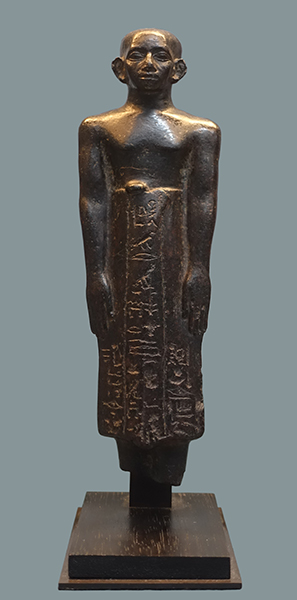
Twelfth Dynasty: 1 991 BC - 1 802 BC
Nebhepetra
Circa 1 860 BC
Serpentine statue of Nebhepetra, a senior lector priest and guard at the temple of Amun-Ra in Karnak. His head is shaven and he is dressed in a long wraparound garment. He stands in a pose of prayer with his arms hanging down, the hands resting flat on the front of his robe. Inscriptions on the robe and on three sides of the back pillar contain offering prayers and autobiographical information.
Height: 195 mm.
Curator's comments:
The inscriptions on the figure are unusually extensive. There are three columns of hieroglyphs on the man’s garment, and four more columns on three sides of the back pillar. Their content accounts for the statue’s exceptional importance, as they reveal the owner’s extraordinary career.
On the cloak he is identified as ‘the senior lector in the King’s House, master of secrets in the August Chamber, pure of hands in performing rituals, the lector Nebhepetra, born of Sitamun.’ The man’s name is unusual and recalls the throne name of Nebhepetra Montuhotep II, a pharaoh who had lived some 250 years earlier and founded the Middle Kingdom. His magnificent mortuary temple left an enduring stamp on the cityscape of ancient Thebes, and later generations of locals invoked the king in prayers as though he were a god. People named after the king often belonged to families of priests who served in Montuhotep’s temple, and the owner of this statue was probably no exception. Indeed he is almost certainly identical with a ‘senior lector’ Nebhepetra who left graffiti in the cliffs rising up around the temple.
The statue’s significance stems in large part from what the texts communicate about the social roles of its subject and his connections to the king. Lectors were leading intellectuals with knowledge of rituals and sacred texts. These religious scholars were well versed in the rules that governed formal art, iconography and hieroglyphic writing – the script employed on official monuments and objects. Apart from their priestly duties, they directed the content and design of wall images in temples and tombs, and many lectors even doubled as draughtsmen. Nebhepetra states explicitly that he was a senior lector ‘in the King’s House’. His easy access to the currently ruling pharaoh leaves no doubt that he fulfilled an advisory role in the execution of decoration programmes commissioned by the king for sacred buildings. The palace (‘King’s House’) our priest frequented for conversations with the king was probably one that stood in Thebes.
The back pillar of the statue contains an autobiographical statement of particular significance, revealing that Nebhepetra was also a ‘Medjau’ in the temple of Amun-Ra in Karnak. The Medjau were desert police, whose duties encompassed the security of desert roads and wealthy institutions such as temples and cemeteries, which in Egypt were often located on the desert edge. References to the Medjau are extremely rare in sources as ancient as this statue, and it provides new evidence for the shifting meaning of ethnic and professional designations. Originally the Medjau were a Nubian nomadic people, often recruited by the Egyptians to patrol the deserts. The statue shows that already in the 19th century BC, much earlier than previously thought, the term Medjau had become a general term for desert police, including Egyptians. Nebhepetra was clearly an Egyptian, not a Medjau who assumed an Egyptian name: no Nubian nomads would have had access to his high status and literacy, nor would they have taken an interest in the local cult of a long-dead Egyptian king.
Against tradition, the sides of the back pillar are also inscribed, bearing invocations of Osiris and the war god ‘Montu, lord of Medamud’. The town of Medamud lies just north of Karnak, at the northern limits of ancient Thebes. The mention of Montu on the statue of a Theban priest suggests that Nebhepetra’s duties stretched beyond the centre of Thebes – and probably well beyond. Nebhepetra therefore provides us with the expansive story of a priest and policeman whose radius of action comprised the royal palace in Thebes, the local temple of a deified king, the temple of Amun-Ra in Karnak, and the neighbouring provincial town of Medamud.
Catalog: Serpentine, Western Thebes, EA83921
Photo: Don Hitchcock 2018
Source: Original, British Museum
Text: Card with the display at the British Museum, https://www.britishmuseum.org/, © Trustees of the British Museum, CC BY-NC-SA 4.0

Twelfth Dynasty: 1 991 BC - 1 802 BC
The Priest Amenhotep
Limestone statuette of the priest Amenhotep, circa 1 985 BC - 1 773 BC
The inscription on the plinth is, unusually, written in hieratic script in ink. It mentions
the god Montu and his sanctuary of Medamud, near Thebes.
Statue of the priest Amenhotep: a finely carved limestone statue of a man wearing a triangular kilt. The stone is unpainted apart from the black eye detail, the white in the eyes and on the finger and toenails. A dedicatory inscription was usually carved in hieroglyphs at the top front of a statue plinth, but here the text consists of two lines of hieratic text in black ink (reading right to left).
Inscription transliteration: imʒḫy ḥr mntw m mʒdw ḥm-nṯr Imn-ḥtp
Inscription translation: The one revered before Montu in Medamud, the priest Amenhotep.
Inscription note: In ink. The inscription suggests that the statue may have come from near Thebes, since Montu in Medamud is a Theban deity. The reason — perhaps of time or expense - why the text was written in ink rather than carved can now only be guessed at.
Height 225 mm, width 145 mm, depth 150 mm.
Catalog: Limestone, Thebes, EA2295
Photo: Don Hitchcock 2018
Source: Original, British Museum
Text: Card with the display at the British Museum, https://www.britishmuseum.org/, © Trustees of the British Museum, CC BY-NC-SA 4.0
Twelfth Dynasty: 1 991 BC - 1 802 BC
The Priest Amenhotep
Sycomore fig coffin of the priest Amenhotep.
Circa 1800 - 1700 BC, from Thebes.
Rectangular wooden coffin of Amenhotep; painted Hieroglyphic text, eye-panel and palace-façade decoration.
The name of the occupant of this coffin has been written in blank spaces intentionally left for that purpose in the inscriptions. The outer surfaces are decorated with short texts alternating with stylised false-door motifs.
Catalog: Painted wood, Thebes, EA12270
Photo: Don Hitchcock 2018
Source: Original, British Museum
Text: Card with the display at the British Museum, https://www.britishmuseum.org/, © Trustees of the British Museum, CC BY-NC-SA 4.0
Twelfth Dynasty: 1 991 BC - 1 802 BC
The Priest Amenhotep
Wedjat eyes on the coffin of the priest Amenhotep.
Circa 1800 - 1700 BC, from Thebes.
The eyes painted at the head-end on the eastern-facing side enabled the mummy to look towards the rising sun and the offering-place in the tomb.
Catalog: Painted wood, Thebes, EA12270
Photo: Don Hitchcock 2018
Source: Original, British Museum
Text: Card with the display at the British Museum, https://www.britishmuseum.org/, © Trustees of the British Museum, CC BY-NC-SA 4.0
Twelfth Dynasty: 1 991 BC - 1 802 BC
Chamberlain Intef
Rectangular limestone stela of Intef at Abydos North, circa 1 965 BC - 1 920 BC
Rectangular limestone stela from the reign of Senusret I divided into four registers:
1 - Fourteen rows of Hieroglyphic text, top-most in form of cartouche of Senusret I.
2 - Scene of three seated figures and offering-table.
3 + 4 - Rows of figures; row of Hieroglyphic text above each.
Height 1030 mm, width 430 mm, thickness 190 mm.
Catalog: Limestone stela, Chapel of Intef at Abydos North, EA572
Photo: Don Hitchcock 2018
Source: Original, British Museum
Text: Card with the display at the British Museum, https://www.britishmuseum.org/, © Trustees of the British Museum, CC BY-NC-SA 4.0
Drawing: Budge (1912)
Permission: Public Domain

Twelfth Dynasty: 1 991 BC - 1 802 BC
General Nesmontu
Block statue of General Nesmontu.
Circa 1 950 BC.
Made of anorthosite, a type of intrusive igneous rock composed predominantly of calcium-rich plagioclase feldspar. All anorthosites found on Earth consist of coarse crystals, but some samples of the rock taken from the Moon are finely crystalline. Most anorthosites formed during Precambrian times.
Catalog: Anorthosite gneiss, Thebes (?), ÄS 7148
Photo: Don Hitchcock 2015
Source: Original, Ägyptischen Museum München
Text: © Ägyptischen Museum München
Additional text: Wikipedia
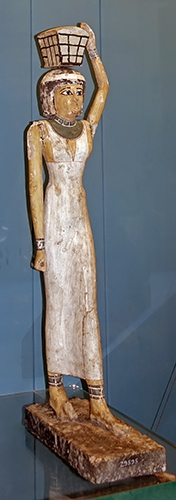
Twelfth Dynasty: 1 991 BC - 1 802 BC
Female Servant
Painted wooden statue of a female servant carrying offerings in a basket on her head, circa 1 950 BC.
Height 553 mm.
Catalog: Wood, painted and gessoed, provenance unknown, EA29595
Photo: Don Hitchcock 2018
Source: Original, British Museum
Text: Card with the display at the British Museum, © Trustees of the British Museum, CC BY-NC-SA 4.0
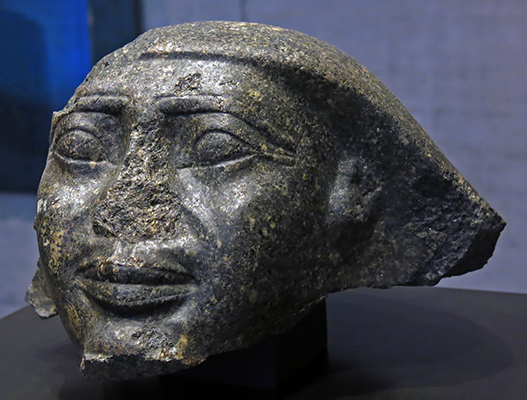
Twelfth Dynasty: 1 991 BC - 1 802 BC
Block Statue
Head from a block statue.
Circa 1 900 BC.
Catalog: Granite, Sakkara (?), ÄS 5570
Photo: Don Hitchcock 2015
Source: Original, Ägyptischen Museum München
Text: © Ägyptischen Museum München
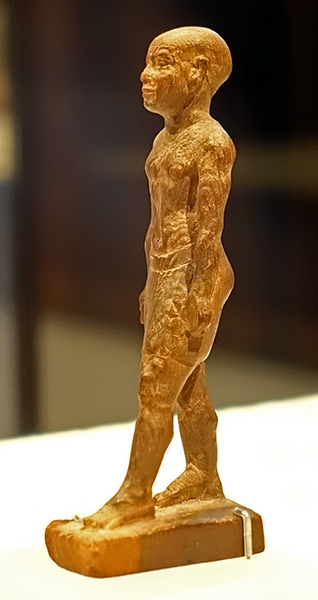
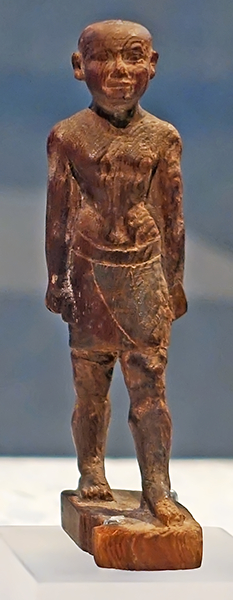
Twelfth Dynasty: 1 991 BC - 1 802 BC
Standing/walking man
From the reign of Senusret II, 1 897 BC - 1 878 BC.
Dimensions 102 x 29 x 40 mm
The type of standing walking figure has been documented for private individuals and kings alike since the beginning of Egyptian history, both in everyday life and in the grave equipment. This small figure, which was found in a grave right next to the mummy, represents the deceased who wanted to continue living with this replacement body in the hereafter.
The special feature of the standing walking motif is the far forward left leg, the entire sole of which touches the ground. As a result, the leg was artificially represented, giving the impression of a special dynamic, on the one hand standing stable, on the other hand actively reaching out.
( I find the proportions of this figure unusual - the head seems disproportionately large, and the calves short and thick, with a small torso and large and heavy hips and thighs.
http://www.egyptian-museum-berlin.com/c51.php describes this figure as being depicted with a permanent physical disability - Don )
Catalog: Wood, Abusir, mR2 and mR 3 (tomb) ÄM 16600
Photo: Don Hitchcock 2018
Source: Original, Staatliche Museen zu Berlin, Neues Museum, Germany
Text: © Card at the Staatliche Museen zu Berlin, http://www.smb-digital.de/, (CC BY-NC-SA 3.0 DE)
Twelfth Dynasty: 1 991 BC - 1 802 BC
Statue of a man
Upper part of a statue of a man, circa 1 872 BC - 1 853 BC
Catalog: Limestone, Sesostris III, VÄGM 1999/199
Photo: Don Hitchcock 2018
Source: Original, Staatliche Museen zu Berlin, Neues Museum, Germany
Text: © Card at the Staatliche Museen zu Berlin, http://www.smb-digital.de/, (CC BY-NC-SA 3.0 DE)
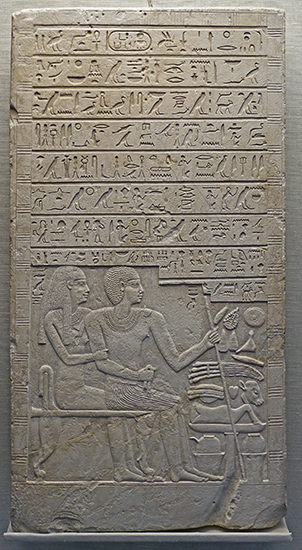
Twelfth Dynasty: 1 991 BC - 1 802 BC
Amenemhet II
Stela from the grave of Amenemhet II, circa 1 866 BC
12th year of rule of Amenemhet II.
The visitor to the tomb is supposed to 'animate/activate' the offerings to Amenemhet and Kern by reading the hieroglyphic inscription on the stele and by pronouncing it.
The magic of the word, which, according to the firm belief of the Egyptians, could bring about this, could also be used against a recipient of sacrifice, for anyone who has the power to give could of course also use it to take.
Catalog: Limestone, probably from Abydos
Photo: Don Hitchcock 2018
Source and text: Original, Museum August Kestner, Hannover
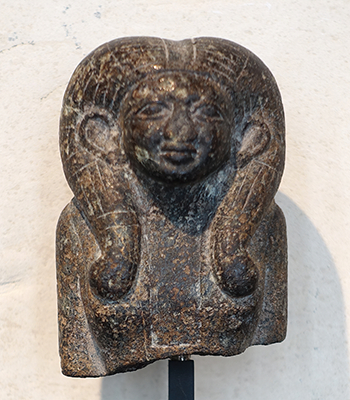
Twelfth Dynasty: 1 991 BC - 1 802 BC
Female Figure
Upper half of a female figure.
Middle kingdom, 12th Dynasty, circa 1 850 BC.
Catalog: Granite, ÄS 7218
Photo: Don Hitchcock 2018
Source: Original, Ägyptischen Museum München
Text: © Ägyptischen Museum München
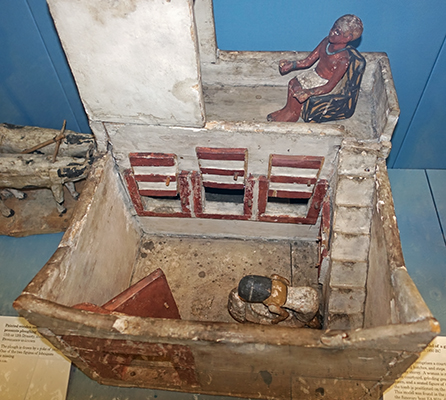
Twelfth Dynasty: 1 991 BC - 1 802 BC
Granary
Painted wooden model of a granary, circa 1 850 BC.
The granary comprises a courtyard, silos with sliding hatches, and steps leading to an upper storey. A woman is represented in the courtyard, grinding grain on a quern, and a seated figure of the owner of the tomb is positioned on the upper level. This model was found in the same tomb as the funerary boat EA9524, shown below.
Catalog: Thebes, EA2463
Photo: Don Hitchcock 2018
Source: Original, British Museum
Text: Card with the display at the British Museum, © Trustees of the British Museum, CC BY-NC-SA 4.0
Twelfth Dynasty: 1 991 BC - 1 802 BC
Soul Houses
(left) Pottery model building with winding staircase and turreted enclosure wall.
Dimensions: Length 418 mm, width 315 mm.
(right) Pottery model building with four arched doorways.
Dimensions: Height 112 mm, length 262 mm, width 245 mm.
The graves of the poor were often simple shafts, without a mortuary-chapel for the ritual provisioning of the dead. To supply this need a pottery offering-platter or model house was often deposited at the mouth of the shaft. The platters contain a water basin and a range of food offerings. The more elaborate 'soul houses' as shown here incorporated a house to serve as a dwelling for the spirit.
Catalog: Pottery, provenance unknown, EA32611, EA32613
Photo: Don Hitchcock 2018
Source: Original, British Museum
Text: Card at museum display, http://www.britishmuseum.org/, © Trustees of the British Museum, CC BY-NC-SA 4.0
Twelfth Dynasty: 1 991 BC - 1 802 BC
Funerary Boat
Painted wooden model of a funerary boat, circa 1 850 BC.
A number of tombs contained models of funerary boats. This one was found in the same tomb as the model granary, EA2463, shown above.
The boat represents the mummy lying under a central canopy, attended by mourners and a priest. These models may have represented the funeral voyage across the Nile to the necropolis, or provided a means for the deceased to make pilgrimages to holy sites, particularly those associated with the cult of Osiris, such as Abydos and Busiris.
( The boat appears to have been sculled with the large paddles at the rear, rather than being propelled by a sail or by banks of rowers or paddlers, as in models of larger boats - Don )
Catalog: Thebes, EA9524
Photo: Don Hitchcock 2018
Source: Original, British Museum
Text: Card with the display at the British Museum, © Trustees of the British Museum, CC BY-NC-SA 4.0
Twelfth Dynasty: 1 991 BC - 1 802 BC
Funerary Boat Oar
Close up of a painted wooden model of a funerary boat oar, circa 1 850 BC.
( note the Wedjat eyes on the oar to provide protection from harm, and the one on the bow of the ship in the image above - Don )
The Eye of Horus, also known as wadjet, wedjat or udjat, is an ancient Egyptian symbol of protection, royal power, and good health. Ancient Egyptian and Middle-Eastern sailors would frequently paint the symbol on the bows of their vessels to ensure safe sea travel.
Catalog: Thebes, EA9524
Photo: Don Hitchcock 2018
Source: Original, British Museum
Text: Card with the display at the British Museum, © Trustees of the British Museum, CC BY-NC-SA 4.0
Additional text: Wikipedia
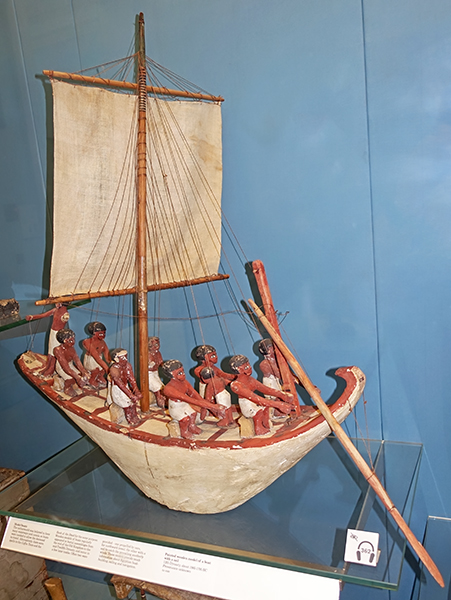
Twelfth Dynasty: 1 991 BC - 1 802 BC
Model Boat
Painted wooden model of a boat with a sail.
The netherworld was believed to have many waterways and canals, so boats were needed to allow the deceased to travel. Alternatively, there were spells in the Coffin texts and the Book of the Dead for the same purpose.
Wooden models of boats regularly appeared in burial assemblages from the end of the Old Kingdom to the mid-Twelfth Dynasty, and they occur occasionally in a few later tombs.
Often two were provided - one propelled by oars, for northward travel, the other with a sail to catch the prevailing winds from the north when travelling south. These models provide much information about Egyptian boat-building, sailing, and navigation.
Catalog: Provenance unknown, EA35292
Photo: Don Hitchcock 2018
Source: Original, British Museum
Text: Card with the display at the British Museum, © Trustees of the British Museum, CC BY-NC-SA 4.0
12th Dynasty: 1 991 BC - 1 802 BC
Model of a boat
Although this model comes from a burial area, it reflects an image of the Egyptian crouching on the deck every day in numerous examples and variations, on a visit, inspecting his goods or on official business.
The journey may take several days, for he carries a chest, probably for clothes and toiletries. Four oarsmen drive the ship forward; in the stern stands the helmsman (missing the now lost rudder); in the bow the pilot who has to watch out for sandbanks, dangerous water animals and oncoming traffic.
In terms of form history, the model represents an interesting type. Just as railway carriages were initially designed like horse carriages and the first steamboats still had many elements of sailboats, the hull and stem of these ships - naturally made of wood - are stylised after the model of early historical papyrus barges, i.e. old forms are converted into a different material. This is the only way to explain the mast - it would not have had any support in a boat of this format that was actually tied together from papyrus stalks.
So, as vividly as an aspect of daily life in Egypt becomes to us here, the function of the model is exclusively otherworldly. The 'lord' wanted to have the many goods and comforts of his earthly existence also at his disposal in the afterlife. In 'reality', the journey to Buto (where the deified lower Egyptian kings of prehistoric times rested) or to Abydos, the tomb and main cult site of Osiris, has become a journey for both pleasure and work.
The custom of giving the dead (rarely stone, mostly wooden) models developed in the late Old Kingdom and lasted until the 12th Dynasty. Often these are not only single figures, but groups of figures, which were arranged into regular scenes (workshops, farming, even herds of cattle and military units) which can then replace the pictures on the tomb walls.
The importance of these compositions in art history lies in their breaking with the classical canon and its strict rules, which sought to avoid the impression of spatial depth, laterality and dynamism and largely prevented the emergence of genuine group statues.
Length 580 mm
Catalog: Painted wood, probably from Middle Egypt, Inv. nr. 1960.28
Photo: Don Hitchcock 2018
Source and text: Original, Museum August Kestner, Hannover
Additional text: Paper Catalogue, Museum August Kestner, Hannover, Wikipedia

Twelfth Dynasty: 1 991 BC - 1 802 BC
Gift Bringer
Gift bringer from Assiut, Middle Egypt 12th Dynasty, around 1950 BC. Painted wood, height 528 mm.
The figure of this girl, who has barely outgrown childhood, belongs to the same monument category as the boat model (No. 6) above, and has many counterparts on grave walls as part of sacrificial scenes.
The primary task of this gift bringer was to provide the grave owner with ointment cones (in a basket on her head) and food - here a duck - and thus to ensure his physical well-being. But the image is more complex.
The offering of ointments and myrrh was also a New Year's ceremony that accompanied and symbolised the annual rebirth of creation. If it was recreated in the afterlife, it meant the resurrection to new life, and the nameless servant became a partner gifted with magical power.
The delicate, slender figure with the delicate face framed by heavy braids of hair represents the classic Egyptian ideal of beauty. The robe made of white linen covers the entire body, but is also cut so skin-tight that the charm of the youthful female body is clearly noticeable.
Catalog: Painted wood, Inv. No. 1965.2
Photo: Don Hitchcock 2018
Source and text: Original, Museum August Kestner, Hannover
Twelfth Dynasty: 1 991 BC - 1 802 BC
Ptah-wer
Squatting figure of the chief steward Ptah-wer, circa 1 850 BC - 1 802 BC
Catalog: Granite, Memphis, District of the Ptah Temple, ÄM 8808
Photo: Don Hitchcock 2018
Source: Original, Staatliche Museen zu Berlin, Neues Museum, Germany
Text: © Card at the Staatliche Museen zu Berlin, http://www.smb-digital.de/, (CC BY-NC-SA 3.0 DE)
Twelfth Dynasty: 1 991 BC - 1 802 BC
Female Figure
Torso from the statue of a woman (Queen?). Height 295 mm.
Circa 1 800 BC
Probably from the funerary temple of Pharaoh Amenemhat III at Hawara (Fayoum)
Catalog: Limestone, ÄS 6979
Photo: Don Hitchcock 2015, 2018
Source: Original, Ägyptischen Museum München
Text: © Ägyptischen Museum München
Additional text: Schoske & Wildung (2013)
Twelfth Dynasty: 1 991 BC - 1 802 BC
Crocodile
Cult statue of a crocodile.
Circa 1 800 BC
Catalog: Copper and electrum, Fayum (?), ÄS 7148
Photo: Don Hitchcock 2015
Source: Original, Ägyptischen Museum München
Text: © Ägyptischen Museum München
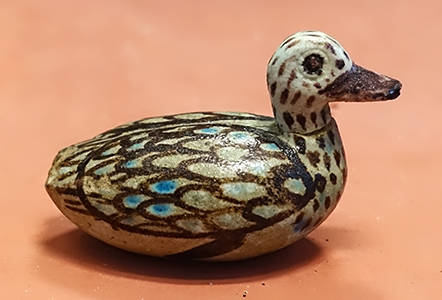
Twelfth Dynasty: 1 991 BC - 1 802 BC
Duck
At this time, animal figurines were common, made of faience: mice, monkeys, hippopotamuses, fish.
Height 44 mm, length 70 mm.
Catalog: Faience, Aile Sully, Room 334, Materials and Techniques, Vitrine 6, E 10857
Photo: Don Hitchcock 2018
Source and text: Original, Louvre Museum, Paris, France, https://collections.louvre.fr/
Twelfth Dynasty: 1 991 BC - 1 802 BC
Royal Headdress
Royal headdress from the figure of a sphinx.
Circa 1 800 BC.
Catalog: Copper, remains of gilding, Fayum (?), ÄS 7206
Photo: Don Hitchcock 2015, 2018
Source: Original, Ägyptischen Museum München
Text: © Ägyptischen Museum München
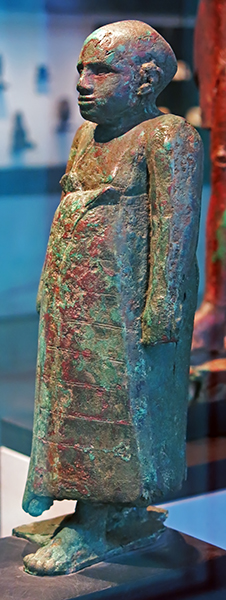
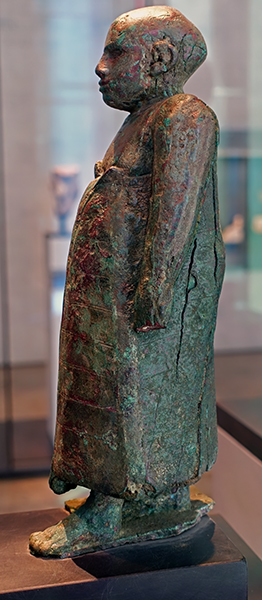
Twelfth Dynasty: 1 991 BC - 1 802 BC
High Official
Standing-striding figure of a high official.
Circa 1 800 BC.
Catalog: Copper, silver, Fayum (?), ÄS 7105
Photo: Don Hitchcock 2015, 2018
Source: Original, Ägyptischen Museum München
Text: © Ägyptischen Museum München
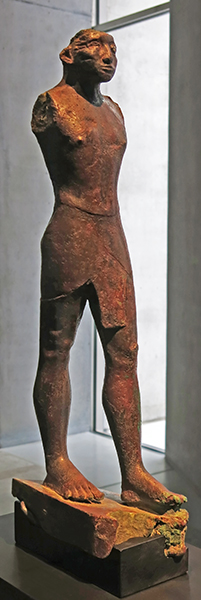

Twelfth Dynasty: 1 991 BC - 1 802 BC
Pharaoh Amenemhat III
Standing-striding figure of Pharaoh Amenemhat III.
Circa 1 800 BC.
Catalog: Copper, gold, electrum, rock crystal, Fayum (?), ÄS 6982
Photo: Don Hitchcock 2015, 2018
Source: Original, Ägyptischen Museum München
Text: © Ägyptischen Museum München


Twelfth Dynasty: 1 991 BC - 1 802 BC
Asiatic official
Head from the statue of an Asiatic official.
( note that an Asiatic included anyone from a land to the east of Egypt, such as Gaza or Canaan or Lebanon. However in this case the headdress is similar in some ways to the turbans from ancient Persia - Don )
Circa 1 800 BC - 1 750 BC
Catalog: Limestone, ÄS 7171
Photo: Don Hitchcock 2015, 2018
Source: Original, Ägyptischen Museum München
Text: © Ägyptischen Museum München
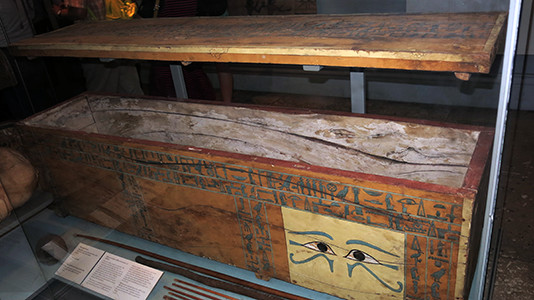
Twelfth Dynasty: 1 991 BC - 1 802 BC
Ankhef
Painted wooden coffin and mummy (not on display in 2015) of Ankhef.
Ankhef's coffin is made of tamarisk wood. The decoration includes hieroglyphic texts requesting funerary offerings, and a pair of eyes to enable the dead man to look towards the east. Squatting figures at the ends of the coffin represent the four sons of Horus, whose duty was to protect the internal organs. Coffins of this type are among the first to include such representations of gods among their decoration.
Catalog: EA46631
Photo: Don Hitchcock 2015
Source: Original, British Museum
Text: Card at museum display © Trustees of the British Museum, CC BY-NC-SA 4.0
Twelfth Dynasty: 1 991 BC - 1 802 BC
Ankhef
Painted wooden coffin and mummy of Ankhef.
Catalog: EA46631
Photo: Don Hitchcock 2018
Source: Original, British Museum
Text: Card at museum display © Trustees of the British Museum, CC BY-NC-SA 4.0
Twelfth Dynasty: 1 991 BC - 1 802 BC
Ankhef
Painted wooden coffin lid of Ankhef, with the mummy on display in the coffin, in 2018.
Catalog: EA46631
Photo: Don Hitchcock 2018
Source: Original, British Museum
Text: Card at museum display © Trustees of the British Museum, CC BY-NC-SA 4.0

Twelfth Dynasty: 1 991 BC - 1 802 BC
Ankhef
The mummy on display in the coffin.
Catalog: EA46631
Photo: Don Hitchcock 2018
Source: Original, British Museum
Text: Card at museum display © Trustees of the British Museum, CC BY-NC-SA 4.0
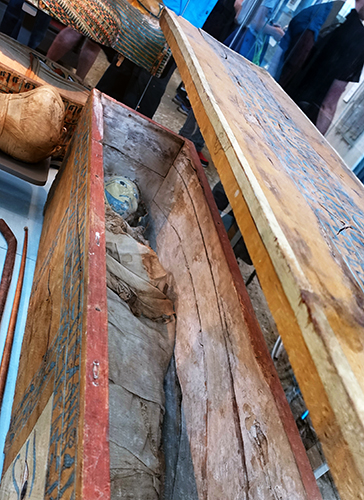
Twelfth Dynasty: 1 991 BC - 1 802 BC
Ankhef
The mummy on display in the coffin.
Catalog: EA46631
Photo: Don Hitchcock 2018
Source: Original, British Museum
Text: Card at museum display © Trustees of the British Museum, CC BY-NC-SA 4.0
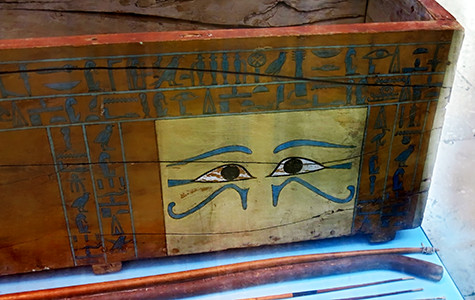
Twelfth Dynasty: 1 991 BC - 1 802 BC
Ankhef
Ankhef was a mature adult at the time of his death. His teeth were well worn, and he suffered from osteoarthritis in the spine and left hip. The mummy originally lay in the coffin on his left side, the face aligned with the eyes painted on the coffin. A wooden headrest was placed inside the coffin to support the head.
Catalog: EA46631
Photo: Don Hitchcock 2015
Source: Original, British Museum
Text: Card at museum display © Trustees of the British Museum, CC BY-NC-SA 4.0

Twelfth Dynasty: 1 991 BC - 1 802 BC
Ankhef
The mummy is wrapped in strips and sheets of linen and a painted cartonnage mask has been placed over the head. This presents an idealised image of the dead man and, in the fashion of the early Middle Kingdom, a beard and moustache are depicted. The soft tissues of the body have not survived, and X-rays show that the bones are in disorder.
Aged 45 or upwards, this man suffered from osteo-arthritis of the spine and the left hip. The absence of lines of arrested growth suggests a healthy childhood. All soft tissues have vanished and the disorganisation of the skeleton is due to the disappearance of the ligaments, capsules, etc.
Skull, Thorax, Spinal Column, and Abdomen - These are completely disorganised. The lower jaw has been dislocated and is almost edentulous. One of the bones of the skull is in the region of the left iliac fossa. All the ribs are dislocated but not fractured. Many of the vertebrae appear to be missing but two lumbar vertebrae are still articulated. These show evidence of osteo-arthritis with gross lipping. Many loose teeth with worn caps lie amongst the bones. No evidence of viscera, packing material, or amulets. Complete dislocation of the sacrum and pubic symphysis. Well-marked osteo-arthritic changes involve the left hip. No fractures seen.
Arms - Extended, dislocated at the shoulder and elbow joints. Hands, with extended fingers, in pubic region. No fractures seen.Legs - The bones appear healthy and are free from fractures and lines of arrested growth. Both ankles are dislocated and the right os calcis is lying free at the foot end of the coffin.The mummy, lying in a deep, rectangular wooden coffin with painted gesso including hieroglyphic text, is wrapped in fine cloth, and the head and thorax are covered by a painted cartonnage mask and breast plate. A wooden headrest is placed by the side of the head.
Catalog: EA46631
Photo: © Trustees of the British Museum, CC BY-NC-SA 4.0
Source: Original, British Museum
Text: Card with the display at the British Museum, http://www.britishmuseum.org/, © Trustees of the British Museum, CC BY-NC-SA 4.0

Twelfth Dynasty: 1 991 BC - 1 802 BC
Bow and arrows, and a walking stick.
These were found on the lid of the coffin. The bow, 1691 mm long, is made from acacia. The arrows are made of reeds, and are circa 800 mm long.
Catalog: (bow and arrows) EA47570
Photo: Don Hitchcock 2015
Source: Original, British Museum
Text: Card with the display at the British Museum, http://www.britishmuseum.org/, © Trustees of the British Museum, CC BY-NC-SA 4.0
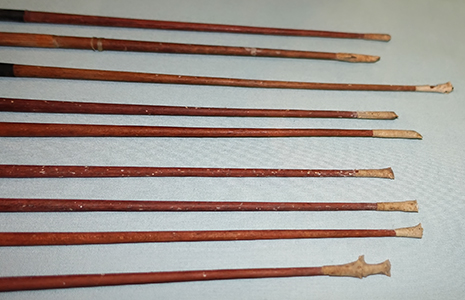
Twelfth Dynasty: 1 991 BC - 1 802 BC
Arrows
( the arrows have 'chisel' tips, and were designed specifically for hunting birds in the marshes bordering the Nile. The bindings and much of the flint tips have been covered with a glue which is light in colour - Don )
Catalog: (bow and arrows) EA47570
Photo: Don Hitchcock 2018
Source: Original, British Museum
Text: Card with the display at the British Museum, http://www.britishmuseum.org/, © Trustees of the British Museum, CC BY-NC-SA 4.0
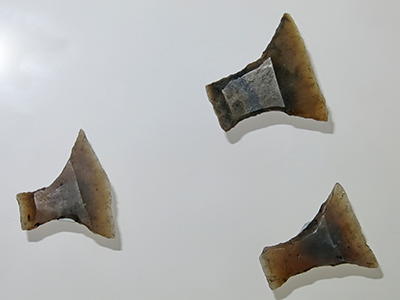
Similar arrow tips to those above, known as trapezoid microliths, were used by ice age hunters in Denmark for hunting birds and small game.
Photo: Don Hitchcock 2014
Source: Original, Københavns (Copenhagen) Museum, National Museum of Denmark
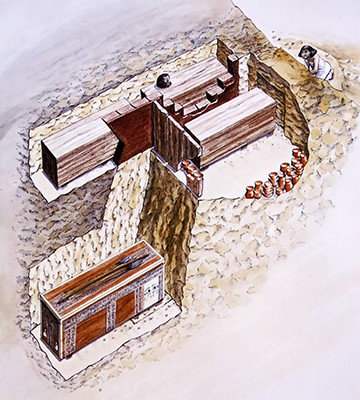
Twelfth Dynasty: 1 991 BC - 1 802 BC
Ankhef
Interior of tomb 9 at Asyut. Reconstruction by Claire Thorne, based on the excavation records of David Hogarth. The coffin of Ankhef stands in a small rock-cut chamber reached by a steeply inclined shaft. Some of the offering bowls from the upper chamber are displayed in this case, as is the model grain silo which stood on the lid of one of the undecorated coffins.
The mummy of Ankhef was discovered by D.G. Hogarth in 1907, in a small rock-cut tomb (no. 9) in the necropolis of the city of Asyut. The tomb was discovered undisturbed, and contained four burials. Two of these, in plain uninscribed coffins were place end to end behind a screen of plaster, brick and stone. A third undecorated coffin lay in the area immediately behind the door of the tomb. The coffin of Ankhef was positioned at the south-east corner of the tomb, concealed by a partition made from parts of old coffins. A stick and bow and arrows lay on the lid of the coffin. Pottery vessels had been laid on the floor in front of the partition, perhaps representing Ankhef's funerary offerings.
The bodies had been searched for valuables at the time of burial, as indicated by disturbed wrappings and in the case of Ankhef the displacement of the headrest in the coffin. Evidence of theft was found in many of the undisturbed tombs in this cemetery, and was probably carried out by those responsible for the burial.
Original artwork: Claire Thorne
Rephotography: Don Hitchcock 2015
Source: Poster, British Museum © Trustees of the British Museum, CC BY-NC-SA 4.0
Text: Card with the display at the British Museum, http://www.britishmuseum.org/, © Trustees of the British Museum, CC BY-NC-SA 4.0
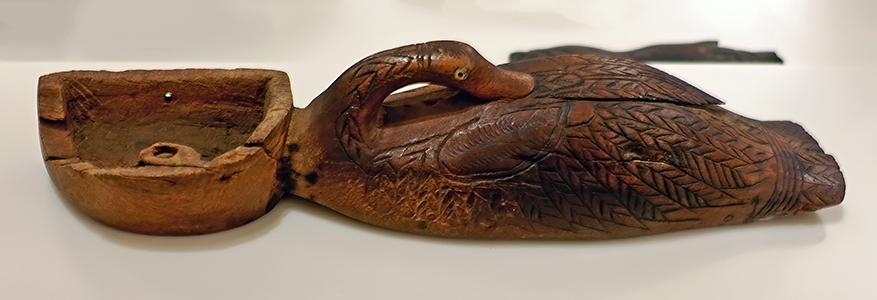
Twelfth Dynasty: 1 991 BC - 1 802 BC
Vessel in the form of a duck
Middle kingdom, 12th Dynasty
Catalog: Wood, ÄM 6774
Photo: Don Hitchcock 2018
Source: Original, Staatliche Museen zu Berlin, Neues Museum, Germany
Text: © Card at the Staatliche Museen zu Berlin (CC BY-NC-SA 3.0 DE)

Twelfth Dynasty: 1 991 BC - 1 802 BC
Calcite Canopic Jar
Jars with shallow convex lids such as this were characteristic of the Old Kingdom (late 4th to 6th Dynasties), but were still occasionally used in the Middle Kingdom.
Diameter 170 mm, height 260 mm, circa 1 985 BC - 1 795 BC.
Catalog: Calcite, Deir el-Bersha, EA35083
Photo: Don Hitchcock 2015
Source: Original, British Museum
Text: Card with the display at the British Museum, https://www.britishmuseum.org/, © Trustees of the British Museum, CC BY-NC-SA 4.0

Twelfth Dynasty: 1 991 BC - 1 802 BC
Calcite Canopic Jar
Calcite Canopic Jar with painted wooden lid.
Diameter 178 mm, height 295 mm, circa 1 985 BC - 1 795 BC
Catalog: Calcite body, wooden human-headed lid coated in plaster (?), Deir el-Bersha, EA35084
Photo: Don Hitchcock 2015
Source: Original, British Museum
Text: Card with the display at the British Museum, https://www.britishmuseum.org/, © Trustees of the British Museum, CC BY-NC-SA 4.0
Twelfth Dynasty: 1 991 BC - 1 802 BC
Model of a granary
Catalog: Siut, Wood, ÄM 12548
Photo: Don Hitchcock 2018
Source: Original, Staatliche Museen zu Berlin, Neues Museum, Germany
Text: © Card at the Staatliche Museen zu Berlin (CC BY-NC-SA 3.0 DE)
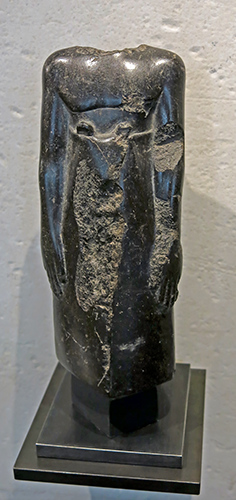
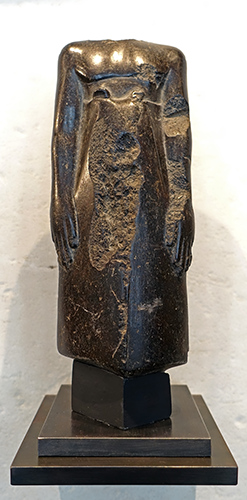 Twelfth Dynasty: 1 991 BC - 1 802 BC
Twelfth Dynasty: 1 991 BC - 1 802 BC
Figure of a man.
Standing-striding figure of a man. Middle Kingdom, 12th Dynasty, circa 1 850 BC.
Catalog: Serpentinite, ÄS 5368
Photo: Don Hitchcock 2015, 2018
Source: Original, Ägyptischen Museum München
Text: © Ägyptischen Museum München

Twelfth Dynasty: 1 991 BC - 1 802 BC
Sobekhotep
Seated figure of Sobekhotep and his wife. Middle Kingdom, 12th Dynasty, circa 1 880 BC, made of Syenite.
Syenite is a coarse-grained intrusive igneous rock with a general composition similar to that of granite, but deficient in quartz, which, if present at all, occurs in relatively small concentrations (less than 5%).
Catalog: Syenite / Fayum / GL. 99
Photo: Don Hitchcock 2015
Source: Original, Ägyptischen Museum München
Text: © Ägyptischen Museum München
Additional text: Wikipedia
Twelfth Dynasty: 1 991 BC - 1 802 BC
Chertihotep
Seated figure of the head of the estate, or steward, Chertihotep / Nemti-hotep
Circa 1 850 BC
Quartzite
From the reign of Sesostris III, 1 872 BC - 1 853 BC.
Dimensions: 765 x 250 x 440 mm.
With the Middle Kingdom, a new factor affected and invigorated Egyptian art: the desire for representation. This desire is documented both in royal and private sculptures. Although most of the private statues were still created for the grave, royal permission allowed private individuals to erect statues in temples so as to be represented before the gods, but also to publicly emphasise the social position of the owner . This possibility, as well as the exact study of physiognomy and anatomy, allowed works of exceptional quality to emerge, and the perfection of the art of the Middle Kingdom was still regarded as 'Classical Art' in later times, and provided stimulating examples to follow.
In the late Twelfth Dynasty, the 'rediscovery' of the strongly personal image of the old age took place, following examples from the Old Kingdom. From now on, the human face drawn from life was central to the representations. Portraits of full individual traits emerge, although filtered through the mask of royal portraits. Thus the figure of Chertihotep, the master of the estate, also shows the characteristic features which are to be found in the royal images of this period.
Eyes, ears, the mouth with slightly bent corners, and cheek surfaces, however, are more formalistic than those of the royal models. A correct official mien, but also a healthy self-confidence characterise the facial expression. Chertihotep sits on a stool with low backrest. His body is enveloped by a close-fitting mantle, which uniquely emphasises the strictly self-contained, tension-loaded body structure of the figure and directs the main attention entirely to the fine, sensitively modeled facial features. You see a face full of plastic vitality. The waves of the wig are only slightly indicated, and lead to an almost block-like body, the contours of which are distinctly under the mantle.
The hands, too, which are held flat, are also arranged to keep the mantle closed. On the other hand, the feet, which are designed with soft, anatomically accurate and detailed lines, are quite different.
Catalog: Quartzite, el Burg el Hamam (east bank of Siut / Assiut), ÄM 15700
Photo: Don Hitchcock 2015, 2018
Source: Original, Staatliche Museen zu Berlin, Neues Museum, Germany
Text: © Card at the Staatliche Museen zu Berlin, http://www.smb-digital.de/ (CC BY-NC-SA 3.0 DE)
Twelfth Dynasty: 1 991 BC - 1 802 BC
Overseer Sesostris
Stela of the chamberlain Sesostris, circa 1 976 BC - 1 794 BC
Rectangular stela, four lines of offering text and appeal to the living, with Senusert, Overseer of the antechamber, seated at table. His wife is standing behind him, and his son below the chair, his sister Renefankh and her daughter before them, and three registers of relatives, including father Antef and mother Neferyt.
1st half of Dyn. XII, formerly in G. Anastasi colln., now in Berlin, Ägyptisches Museum.
Catalog: Limestone, Abydos (?), ÄM 1188
Photo: Don Hitchcock 2015, 2018
Source: Original, Staatliche Museen zu Berlin, Neues Museum, Germany
Text: © Card at the Staatliche Museen zu Berlin, (CC BY-NC-SA 3.0 DE)
Additional text: http://www.griffith.ox.ac.uk/gri/3berlin.pdf
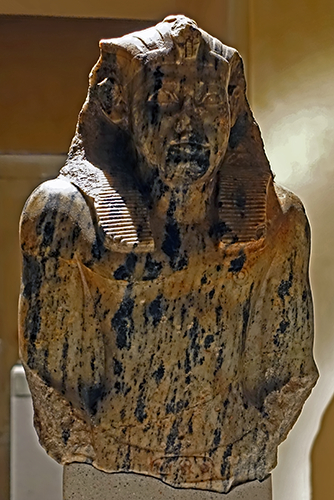

Twelfth Dynasty: 1 991 BC - 1 802 BC
Pharaoh Sesostris I
Upper part of a kneeling figure of Pharaoh Sesostris / Senusret I, circa 1 950 BC.
Catalog: Gneiss, ÄM 1205
Photo: Don Hitchcock 2018
Source: Original, Staatliche Museen zu Berlin, Neues Museum, Germany
Text: © Card at the Staatliche Museen zu Berlin, (CC BY-NC-SA 3.0 DE)

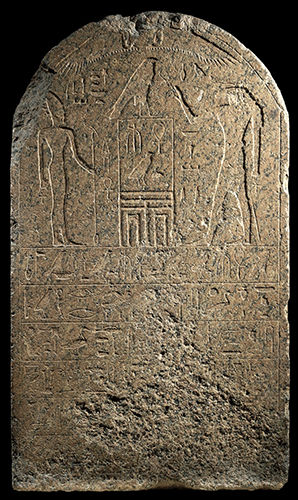
Twelfth Dynasty: 1 991 BC - 1 802 BC
Stela of Senusret I
Red granite stela of Senusret I, 12th Dynasty, circa 1940 BC - 1950 BC, from Philae.
The scene at the top shows the Horus-name of the king between the figures of Khnum and Satet, deities of the First Cataract region.
Round-topped red granite stela; incised detail in two registers; upper: Horus-name of Senusret I between figures of Satis and Khnum; lower: seven rows of Hieroglyphic text.
Height 1092 mm, width 648 mm
Senwosret I (circa 1965 BC - 1920 BC) carried out a very active building programme all over Egypt. This stela stood in or near a chapel in Elephantine that he erected on Egypt's southern frontier. The chapel contained statues and offering tables, as well as decorated blocks. The stela was made of a slab of granite, roughly finished on the rear, indicating it may have been set into the wall of the chapel.
The stela shows the god Khnum offering life to the Horus name of the king, with Khnum's consort Satet, standing at the left. Khnum, Satet, and their daughter Anuket were the local deities of Elephantine and the region of the First Cataract. Below are the remains of six damaged lines of hieroglyphs.
The purpose of the stela, and the whole chapel, was to stress the presence and importance of Senwosret in the Elephantine area. It also emphasized his piety and the importance of his relationship with the deities of the region.
Catalog: EA963
Photo (left): Don Hitchcock 2015
Photo (right): Google Arts and Culture, https://www.google.com/culturalinstitute/, © Trustees of the British Museum, CC BY-NC-SA 4.0
Source: Original, British Museum
Text: Card with the display at the British Museum, http://www.britishmuseum.org/, © Trustees of the British Museum, CC BY-NC-SA 4.0
Additional text: https://www.google.com/culturalinstitute/beta/asset/granite-stela-of-senwosret-i/8QEaVLW6KV-dng?hl=en
Twelfth Dynasty: 1 991 BC - 1 802 BC
Chancellor Nakhti
Circa 1 950 BC - 1 900 BC, at the beginning of the 12th Dynasty from the tomb of Chancellor Nakhti.
Painted wooden model of a boat.
Twelfth Dynasty, reign of Sesostris I, Assiut, tomb no. 7. Sesostris I ( Hellenization of the original Senuosret I, or Sunusret I ) was an Egyptian ruler of the 12th dynasty .
Chancellor Nakhti's largest statue is on the first floor, in room 23.
His tomb in Assiut, in Middle Egypt, is a good example of a notable provincial burial in the Middle Kingdom, with its rectangular sarcophagus, its model tools and models of farm activities.
When French archeologists explored the necropolis of Assiut in Middle Egypt in 1903, they unearthed twenty-six tombs, twenty-one of which had escaped pillagers for nearly four millennia. The tomb they named no. 7 is Chancellor Nakhti's tomb, whose offering chapel and four burial chambers provided the largest cache of funerary furniture and equipment on the site, both in terms of quantity and quality. The finds were divided between the Cairo Museum and the Louvre Museum.
Two alcoves were dug in the stone of the chapel's north and west walls. They held two wooden statues designed for Nakhti's funerary cult. Alongside them were accessories and models designed to perpetuate the offerings that had to be provided for eternity.
The hull of this wooden model has a traditional crescent profile. Its ends end in a vertical structure. Eight rowers are led by a sounder standing at the bow whose duty it was to test the depth of water with his pole, given the many shifting sandbanks under the Nile River. The rear pivot rudders at the rear consist of two oars controlled by the helmsman. The sail and the yards were dismantled and stored on a rack above to free up room for the rowers.
Catalog: Nakhti's tomb at Assiut, Sully, Rez-de-chaussée, Le Nil, Salle 336, Vitrine 2, le Nil, E 12027
Photo: Don Hitchcock 2015, 2018
Source and text: Louvre Museum, Paris, France
Additional text: http://cartelfr.louvre.fr/, https://www.louvre.fr/, http://www.marine-antique.net/Modele-reduit-de-Nakhti?lang=es, Wikipedia
Twelfth Dynasty: 1 991 BC - 1 802 BC
Model of a bakery.
Workers grinding and baking.
Catalog: Achmim, wood, ÄM 10828
Photo: Don Hitchcock 2015, 2018
Source: Original, Staatliche Museen zu Berlin, Neues Museum, Germany
Text: © Card at the Staatliche Museen zu Berlin (CC BY-NC-SA 3.0 DE)
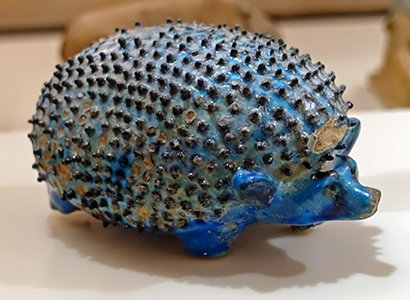
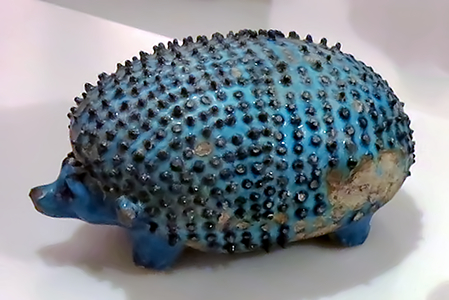
Twelfth Dynasty: 1 991 BC - 1 802 BC
Hedgehog.
Faience, blue, dark blue; painted, circa 1 800 BC
Dimensions: 50 x 55 x 93 mm
The hedgehog has been very popular since prehistoric times because it symbolises a peaceful nature. It appears in relief in the landscape of the Old Kingdom in landscapes, appears in the Middle Kingdom often as a small figure in grave goods, and is then represented again in the tomb paintings of the New Kingdom. Scaraboids and vessels are also preserved in hedgehog form, but the hedgehog has no religious significance.
Catalog: ÄM 10250
Photo: Don Hitchcock 2015, 2018
Source: Original, Staatliche Museen zu Berlin, Neues Museum, Germany
Text: © Card at the Staatliche Museen zu Berlin (CC BY-NC-SA 3.0 DE)
Additional text: O. Anger

Twelfth Dynasty: 1 991 BC - 1 802 BC
Shrew
Figurine of a shrew, circa 1 800 BC
Catalog: Faience, ÄM 14976
Photo: Don Hitchcock 2018
Source: Original, Staatliche Museen zu Berlin, Neues Museum, Germany
Text: © Card at the Staatliche Museen zu Berlin (CC BY-NC-SA 3.0 DE)
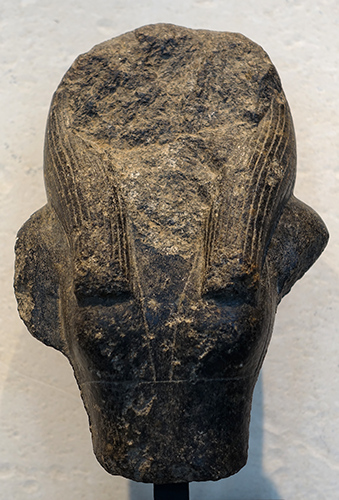
Twelfth Dynasty: 1 991 BC - 1 802 BC
Female Figure
Bust of a female figure.
Middle Kingdom, circa 1 800 BC.
Catalog: Syenite, ÄS 1561
Photo: Don Hitchcock 2018
Source: Original, Ägyptischen Museum München
Text: © Ägyptischen Museum München
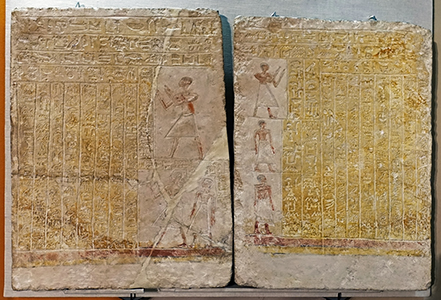
Twelfth Dynasty: 1 991 BC - 1 802 BC
Wenemj wall Relief
Relief on the wall of a passage from the chapel of Wenemj, circa 1 800 BC.
Catalog: Limestone, Abydos, Inv. Nr. 1976.80 a/b
Photo: Don Hitchcock 2018
Source and text: Original, Museum August Kestner, Hannover
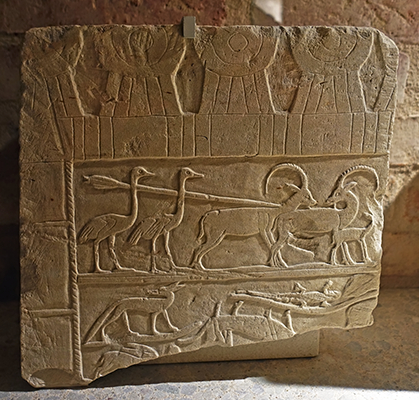
Twelfth Dynasty: 1 991 BC - 1 802 BC
Hunting scene
Fragment of a relief, a hunting scene with ostriches and ibexes.
Catalog: Sandstone, ÄM 14593
Photo: Don Hitchcock 2018
Source: Original, Staatliche Museen zu Berlin, Neues Museum, Germany
Text: © Card at the Staatliche Museen zu Berlin, (CC BY-NC-SA 3.0 DE)

12th Dynasty: 1 991 BC - 1 802 BC
Sitting hippopotamus with open mouth and small resting hippopotamus
Faience, circa 1800 BC.
Catalog: ÄM 13890, ÄM 13892
Photo: Don Hitchcock 2018
Source: Original, Staatliche Museen zu Berlin, Neues Museum, Germany
Text: © Card at the Staatliche Museen zu Berlin, (CC BY-NC-SA 3.0 DE)
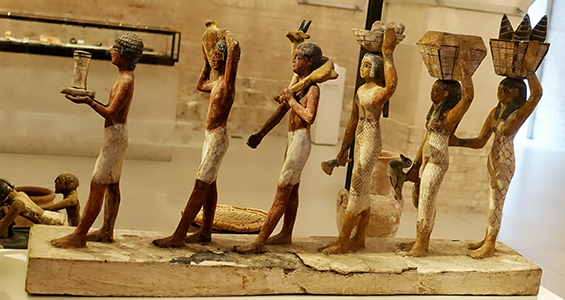
Twelfth Dynasty: 1 991 BC - 1 802 BC
Offering Bearers
Model of a group of offering bearers, circa 1 800 BC.
Catalog: Wood, VÄGM 1980/10
Photo: Don Hitchcock 2015
Source: Original, Staatliche Museen zu Berlin, Neues Museum, Germany
Text: © Card at the Staatliche Museen zu Berlin (CC BY-NC-SA 3.0 DE)
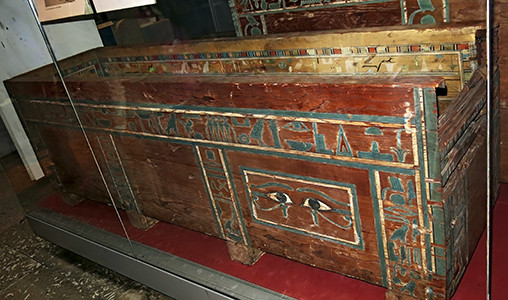
Twelfth Dynasty: 1 991 BC - 1 802 BC
Coffin of Gua
Eastern side of the rectangular wooden inner coffin of Gua.
Exterior: recessed and painted Hieroglyphic text and eye-panel. Interior: painted text and representations of offerings on walls. Painted plan of Underworld on floor.
Catalog: Deir el-Bersha, EA30840
Photo: Don Hitchcock 2015, 2018
Source: Original, British Museum
Text: Card with the display at the British Museum, http://www.britishmuseum.org/, © Trustees of the British Museum, CC BY-NC-SA 4.0

Twelfth Dynasty: 1 991 BC - 1 802 BC
Coffin of Gua
Inner coffin.
Length 2249 mm. The lid of the inner coffin has been lost.
Part of the head-end wall is fragmentary, as shown in this image.
For fragment M4/DD/8:
Length 275 mm, width 50 mm , depth 70 mm, weight 174 grams.
Catalog: Deir el-Bersha, EA30840
Photo: Don Hitchcock 2018
Source: Original, British Museum
Text: Card with the display at the British Museum, http://www.britishmuseum.org/, © Trustees of the British Museum, CC BY-NC-SA 4.0
Twelfth Dynasty: 1 991 BC - 1 802 BC
Coffin of Gua
Western side of the rectangular wooden outer coffin of Gua.
Length 2605 mm, width 920 mm.
Catalog: Deir el-Bersha, EA30839
Photo: Don Hitchcock 2015, 2018
Source: Original, British Museum
Text: Card with the display at the British Museum, http://www.britishmuseum.org/, © Trustees of the British Museum, CC BY-NC-SA 4.0
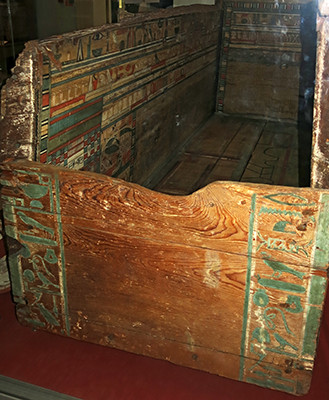
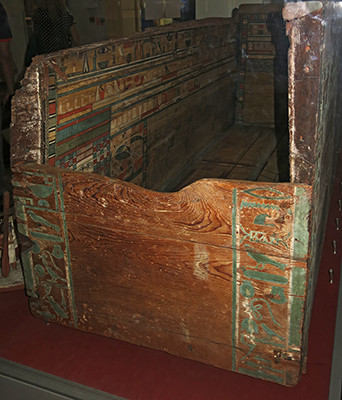
Twelfth Dynasty: 1 991 BC - 1 802 BC
Coffin of Gua
The north facing head of the rectangular wooden outer coffin of Gua.
( note in particular the small pair of eyes painted on the inside of the coffin at the place where the mummy inside the inner coffin would have been placed on its left side so that it could look to the east. The small pair of eyes here would serve at the very least as a reminder for those preparing the burial of which way around to place the inner coffin, which had a matching pair of eyes on the outside, as above - Don )
Catalog: Deir el-Bersha, EA30839
Photo: Don Hitchcock 2015
Source: Original, British Museum
Text: Card with the display at the British Museum, http://www.britishmuseum.org/, © Trustees of the British Museum, CC BY-NC-SA 4.0
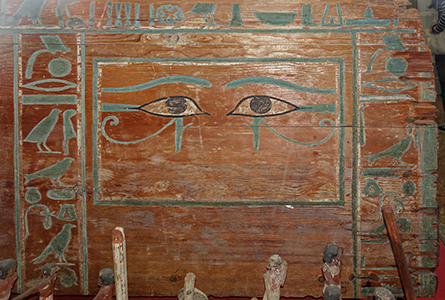
Twelfth Dynasty: 1 991 BC - 1 802 BC
Coffin of Gua
Wedjat eyes at the North Eastern end of the outer coffin. The coffin was oriented so that these eyes could magically look out to see the sunrise.
Catalog: Deir el-Bersha, EA30839
Photo: Don Hitchcock 2018
Source: Original, British Museum
Text: Card with the display at the British Museum, http://www.britishmuseum.org/, © Trustees of the British Museum, CC BY-NC-SA 4.0
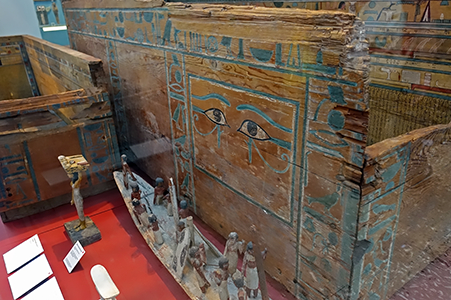
Twelfth Dynasty: 1 991 BC - 1 802 BC
Coffin of Gua
North Eastern corner of the outer coffin.
Catalog: Deir el-Bersha, EA30839
Photo: Don Hitchcock 2018
Source: Original, British Museum
Text: Card with the display at the British Museum, http://www.britishmuseum.org/, © Trustees of the British Museum, CC BY-NC-SA 4.0

Twelfth Dynasty: 1 991 BC - 1 802 BC
Coffin of Gua
Northern end of the outer coffin. This side was damaged.
Catalog: Deir el-Bersha, EA30839
Photo: Don Hitchcock 2018
Source: Original, British Museum
Text: Card with the display at the British Museum, http://www.britishmuseum.org/, © Trustees of the British Museum, CC BY-NC-SA 4.0
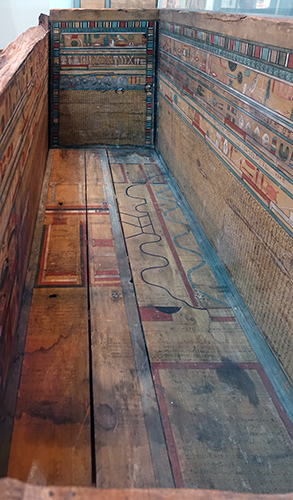

Twelfth Dynasty: 1 991 BC - 1 802 BC
Coffin of Gua
Southern interior end of the outer coffin. ( note that the BM catalog does not seem to have an image of this - Don )
Catalog: Deir el-Bersha, EA30839
Photo: Don Hitchcock 2018
Source: Original, British Museum
Text: Card with the display at the British Museum, http://www.britishmuseum.org/, © Trustees of the British Museum, CC BY-NC-SA 4.0
Twelfth Dynasty: 1 991 BC - 1 802 BC
Coffin of Gua
Interior walls of the rectangular wooden outer coffin of Gua, looking from the northern, head end.
Eastern wall shown in the left hand image, western on the right and below.
Catalog: Deir el-Bersha, EA30839
Photo: Don Hitchcock 2015, 2018
Source: Original, British Museum
Text: Card with the display at the British Museum, http://www.britishmuseum.org/, © Trustees of the British Museum, CC BY-NC-SA 4.0
The coffins of Gua
The outer and inner coffins are made from large pieces of cedar wood. This imported timber was of superior quality to the native Egyptian woods, and its use for the main components of the coffin was a sign of the high status of the owner.Text above from a poster at the British Museum, © Trustees of the British Museum, CC BY-NC-SA 4.0
The coffins are similarly decorated. A pair of eyes on the east side enabled the dead man to look towards the rising sun. The horizontal and vertical inscriptions on the exterior request offerings and invoke the protection of various gods. The omission of a plastered or painted background allowed the distinctive grain of the costly cedarwood to be displayed.
The inner sides of the coffins symbolically represent the walls of the tomb, and are densely covered with religious inscriptions and images. Below an offering formula in coloured hieroglyphs comes a frieze of objects to equip the deceased for the afterlife. A large painted false door on the east side acted as a magical portal to enable Gua's spirit to pass in and out. The remaining areas contain extracts from the Coffin Texts.
These assisted Gua in his passage to the afterlife, and included a self-contained composition known as the Book of Two Ways. The texts of the outer coffin include one of the earliest known examples of the spell to activate shabtis, the funerary figurines.
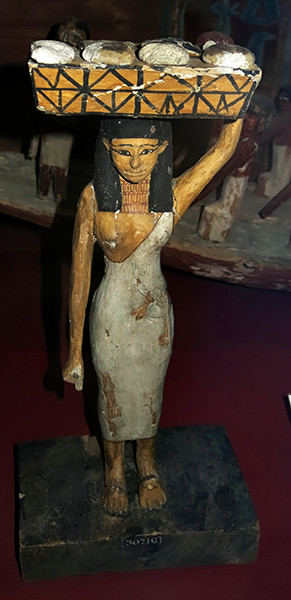
Twelfth Dynasty: 1 991 BC - 1 802 BC
Servant of Gua
Painted and gessoed wooden female figure with basket of loaves and meat on head.
This statuette is made from a native timber, probably tamarisk, and represents a servant carrying food offerings for the owner of the tomb. The basket on her head is filled with loaves and cakes, and the head and foreleg of an ox. In her right hand she probably carried a bird, now lost.
Height 380 mm.
Catalog: Wood and painted gesso, believed to be from the tomb of Gua, EA30716
Photo: Don Hitchcock 2015
Source: Original, British Museum
Text: Card with the display at the British Museum, http://www.britishmuseum.org/, © Trustees of the British Museum, CC BY-NC-SA 4.0

Twelfth Dynasty: 1 991 BC - 1 802 BC
Statue of Gua himself
Although this figure is uninscribed, the pose and the costume and the use of an expensive wood, imported cedar, indicate that it represents the owner of the tomb, in this case Gua himself. In smaller Middle Kingdom tombs, without funerary chapels, statuettes of this type placed inside the coffin served as the vehicle by which the ka of the deceased could receive food and drink.
Wooden tomb statue of a man. The arms, fronts of the feet, and base were made separately. Both of the fists were drilled to hold implements now lost, probably a 'sekhem' sceptre in the right hand, possibly another baton or a rolled cloth in the left. Though the statue may have been entirely painted, all that survives is black on the hair, black and white on the eyes, and white on the finger- and toenails. The nipples were indicated by the inlaying of tiny bits of darker wood. His short curly hairdo was particularly popular during the Eleventh and early Twelfth Dynasties, for both men and women. His long kilt may be meant to indicate maturity here, despite the youthful hairstyle and body.
Circa 1 985 BC - 1 878 BC, height 340 mm, length of plinth 136 mm, width 105 mm.
Catalog: Believed to be from the tomb of Gua, EA30715
Photo: Don Hitchcock 2015
Source: Original, British Museum
Text: Card with the display at the British Museum, http://www.britishmuseum.org/, © Trustees of the British Museum, CC BY-NC-SA 4.0
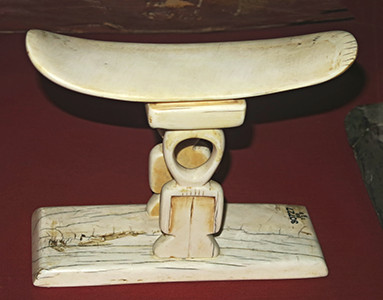
Twelfth Dynasty: 1 991 BC - 1 802 BC
Ivory headrest
The majority of headrests which have been found in tombs were made of wood or stone. Ivory specimens such as this one are very rare, and its fragility suggests that it was probably made specifically for the tomb. The two sides of the central support are carved in the shape of the Tit (the girdle of Isis) which symbolises the protection of the goddess.
Ivory head-rest. Open-work shaft in the form of two tjet-symbols ('Isis knots').
Height 155 mm, length 184 mm, width 67 mm, weight 545 grams.
Circa 1 985 BC - 1 878 BC,
Catalog: Believed to be from the tomb of Gua, EA30727
Photo: Don Hitchcock 2015
Source: Original, British Museum
Text: Card with the display at the British Museum, http://www.britishmuseum.org/, © Trustees of the British Museum, CC BY-NC-SA 4.0
Twelfth Dynasty: 1 991 BC - 1 802 BC
Model of butchering
Wooden model of butchers preparing meat for the deceased with seven figures, painted red, black and white.
The group shows two slaughtered oxen which are being cut up by men with large knives. The leg of one ox is on the butchers block, were it is being jointed.
Width 254 mm, length: 435 mm.
Circa 1 985 BC - 1 878 BC,
Catalog: Believed to be from the tomb of Gua, EA30718
Photo: Don Hitchcock 2015, 2018
Source: Original, British Museum
Text: Card with the display at the British Museum, http://www.britishmuseum.org/, © Trustees of the British Museum, CC BY-NC-SA 4.0
Twelfth Dynasty: 1 991 BC - 1 802 BC
Model boat
This painted wooden model boat carries, besides its owner, a crew of six oarsmen, a pilot, and a group of five soldiers. Shields and staves are also stored amidships. The post in the centre of the hull may have been substituted for an original mast. The paddles and steering oar have also been lost. The construction of the model illustrates the selection of different woods by the carpenter according to the task in hand.
The cloaked statuette of the owner, the most prestigious in the group, is carefully carved from cedar wood, as are the two posts and one of the staves - small components for which a wood with fine grain was required. All other figures, and the hull of the craft, are made from the less expensive and more coarsely grained indigenous sycomore.
This is a wooden model boat with paddlers and soldiers. The hull is narrow and shallow with a sheer-line curving sharply upwards at the stern, where there is a raised block notched for the steering-oar. The hull is painted red and the deck white with the usual deck-plan in red, though owing to the fading of the paint it is not possible to record the details with certainty. There may have been six pairs of spaces, but whether there was a mast-space remains doubtful. The deck has been hollowed from the original block of wood to leave gunwales on each side, but is so steeply cambered that amidships the longitudinal centre-line of the deck is above the level of the gunwales, which merge into the fore- and after-decks.
These decks are slightly raised and not cambered. In the case of the after-deck the line of the gunwales is continued by shallow grooves cut in the deck. The fore-deck may once have been painted red all over, and had a centre strip of which there remain only the mark where it once lay and a single peg-hole. About 13 mm to 25 mm has been lost from the bows. The after-deck also was once painted red all over. There is no mast or rigging; whether it was lost or originally non-existent is not clear. The place where a mast would normally stand is taken by a stout wooden post. There is a steering-post aft. The post is painted red and is circular in section on a square base and grooved at the top.
Amidships, where normally a mast would stand, is a second steering-post which certainly is misplaced; it is possible that the maker of the model substituted this post for the mast, perhaps because he was out of stock of masts. This second post is octagonal on a square base. The two side faces of the octagon are rounded off at the top of the post, which is deeply grooved. It is painted white on the shaft, red at the top, and white in the groove. At the foot the white paint has been partly overlaid with red. On either side of the steering-block the stern is pierced by two holes of uncertain purpose which may possibly have held lashings to hold the steering-oar in the notch.
There is another small hole on the starboard side of the after-deck which may once have held a peg for the helmsman, and there are others on the main deck with the stumps of pegs in them, though it is not clear what purpose they served. Amidships is a curious erection made of two long shields which are painted to represent oxhide with the stitching on the edges marked by black spots. The straight edges at the bottom rest against the gunwales and the rounded tops lean inwards on a thick post of circular section which rises a little above them. Each shield has two holes in it, perhaps for holding a thong for carrying. The post is painted to represent a covering of oxhide with two rows of stitching on the after side, with red on the top. It rises from a wooden object shaped like a small boat with a raised central portion. Around the flat surface of this object are nine holes with short wooden sticks in them, and there is one more in the raised portion. It shows traces of red paint on a white base and the posts were red with black tips, though but little paint now survives.
In the stern is a hole for the peg which once secured the figure of the missing helmsman. Forward of the steering-post is a group of five soldiers, of whom the aftermost is facing to larboard (left) while the other four look in the general direction of the stern. They carry a small shield on the left arm, which is sharply bent at the elbow with the fist close to the shoulder; the right arm of the aftermost soldier is missing. The middle figure on the larboard side holds his left arm straight down with the hand a little in front of the leg; it holds a thin straight object which may be intended either for a staff or a javelin. His opposite number on the starboard side has a short straight piece of wood in his right hand.
These men wear black wigs and white skirts extending just below the knee and white tunics covering their sides and meeting on the chest and back, though only on the aftermost figure is this garment indicated clearly; on the others the white paint partly has fallen away, leaving the red skin-colour beneath.
Between the curious erection amidships and the 'mast' is a seated figure of some dignity and most careful workmanship. It represents a squatting man covered completely except for his head in a long white cloak concealing his arms and wearing a short black wig. Despite the fact that this figure is on a smaller scale than the soldiers and crew, its fine execution and the all-enveloping cloak, as well as the squatting attitude, indicate that this is the owner of the vessel. His unwarlike garb and attitude, as well as the smallness of the squad of soldiers, suggest that the latter are merely an escort of armed retainers accompanying a magnate on his travels, and that this is not a war-boat. The relatively small size and the fine work of the figure of the owner show that it was carved independently by a skilled and sensitive craftsman, whereas the personnel of the boat give the impression of being just good-quality stock figures.
Forward of the 'mast' sit three pairs of paddlers with their handless arms sloping out and down at an angle of 45°-50°. The attitude is rather that of rowers, but the fact that the figures face forward indicates that they are paddlers - unless the maker of the model has blundered. The figures are red with black wigs and white skirts, but the legs are cut off below the knee, as if to suggest that the lower parts of the legs are hidden within the hull. In the bows stands the pilot with his arms stretched down and slightly forward and his legs slightly apart, facing to starboard (right). The features of the crew are only roughly indicated, but all of them, escort as well as paddlers, have their eyes painted on.
Length 1392 mm, depth 76 mm, width 222 mm.
Circa 1 985 BC - 1 878 BC.
Catalog: Believed to be from the tomb of Gua, EA35293
Photo: Don Hitchcock 2015, 2018
Source: Original, British Museum
Text: Card with the display at the British Museum, http://www.britishmuseum.org/, © Trustees of the British Museum, CC BY-NC-SA 4.0

Twelfth Dynasty: 1 991 BC - 1 802 BC
Coffin of Gua
On the left, the the south facing foot of the rectangular wooden outer coffin of Gua.
On the right, Gua's canopic chest.
Wooden canopic chest of Gua of cubical shape with lid. Base supported on two wooden bars. Interior divided at low level by wooden partitions into four compartments for jars. Exterior has blue painted border at edges of box and lid. Sunk relief blue-painted hieroglyphic inscriptions on all external surfaces. Two crossing lines of text on lid. Sides have a horizontal line at the top and a vertical line down the middle. The chest contained four calcite canopic jars with painted wooden stoppers, each in the form of a human headed deity. Pale beige faces with black details and blue-painted wigs. Jars vary in shape from narrow to shouldered. Three retain remains of linen packages inside.
Height 530 mm, depth 550 mm, width 530 mm.
Catalog: Deir el-Bersha, EA30839, EA30838
Photo: Don Hitchcock 2015
Source: Original, British Museum
Text: Card with the display at the British Museum, http://www.britishmuseum.org/, © Trustees of the British Museum, CC BY-NC-SA 4.0
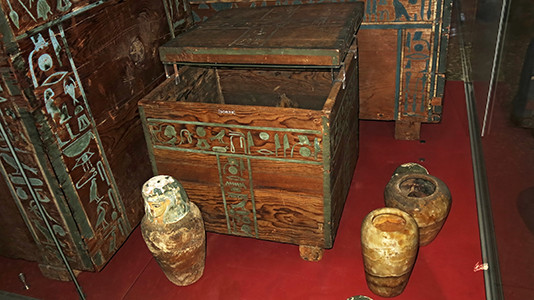
Twelfth Dynasty: 1 991 BC - 1 802 BC
Canopic chest containing four jars
The internal organs of Gua's body were placed in four calcite jars with lids of painted wood. These in turn were stored in the tomb inside a cubic cedarwood chest, divided internally into four compartments. Three of the four jars retain their original contents. These consist of resin soaked linen packages, at least one of which contains the remains of an unidentified soft tissue.
The Canopic chests of this period closely resemble the rectangular coffins in form, construction and decoration. Symbolically, they served as coffins for the internal organs, which were preserved and wrapped as though they were miniature versions of the mummy. Divine protection for Gua's viscera is assured in the inscriptions on the four faces of the chest. These describe him as 'revered' by the four sons of Horus, and also by Isis, Nephthys, Neith, and Selkis. These four goddesses were believed to protect the sons of Horus, as a further assurance of the safety of the vulnerable organs.
Catalog: Deir el-Bersha, EA30838
Photo: Don Hitchcock 2015
Source: Original, British Museum
Text: Card with the display at the British Museum, http://www.britishmuseum.org/, © Trustees of the British Museum, CC BY-NC-SA 4.0

Twelfth Dynasty: 1 991 BC - 1 802 BC
Canopic jar and lids
Canopic lids from the canopic chest of Gua.
Catalog: Deir el-Bersha, EA30838
Photo: Don Hitchcock 2018
Source: Original, British Museum
Text: Card with the display at the British Museum, http://www.britishmuseum.org/, © Trustees of the British Museum, CC BY-NC-SA 4.0
Twelfth Dynasty: 1 991 BC - 1 802 BC
Canopic Jars
Canopic jars to go with the lids above, from the canopic chest of Gua, as well as another complete jar and lid inside the chest.
Catalog: Deir el-Bersha, EA30838
Photo: Don Hitchcock 2018
Source: Original, British Museum
Text: Card with the display at the British Museum, http://www.britishmuseum.org/, © Trustees of the British Museum, CC BY-NC-SA 4.0

Twelfth Dynasty: 1 991 BC - 1 802 BC
The Book of Two Ways - Map of the Netherworld
The Book of Two Ways
The rectangular wooden coffins from Bersha are a major source for the Coffin Texts, the main body of funerary literature used between about 2 000 BC and 1 600 BC. They are particularly notable for a distinct composition known to Egyptologists as the Book of Two Ways. The use of this text had probably spread to Bersha from the Residence cemeteries of Dahsur and Lisht.
This is a guide to the afterlife for the deceased, and includes the earliest known map of the netherworld. The map was usually painted on the floor of the coffin. The accompanying texts describe the inhabitants of the netherworld and provide instructions on how to avoid dangers and obstacles on the journey to the afterlife. Different versions of the Book of Two Ways were in use simultaneously, but the maps generally presented two paths consisting of earth and water.
In the version painted on the outer and inner coffins of Gua, the main goal of the deceased is to join the sun god Ra.
Mummification - Preserving the Body
1. Washing - As soon as possible after death, the body was taken to the Tent of Purification, located close to the banks of the Nile, and was washed in a solution of natron in water.
2. Removal of internal organs - The brain was extracted via the nose, using a metal rod. A stone knife was used to make an incision in the left flank, through which the organs of the chest and abdomen, except for the heart, were removed. The organs were separately preserved.
3. Drying - The chest and abdominal cavities were packed with bags of natron, a naturally-occurring compound of salts which absorbs fluids. Natron powder was packed around, beneath and on top of the body, which was left covered for about 40 days.
4. Packing - The skull was often plugged with linen or filled with resin and the chest cavity packed with woodshavings, linen, earth, or occasionally lichen. Sand, linen or mud was inserted under the skin to restore substance to the features.
5. Anointing - The skin was coated with liquid plant resin to exclude moisture from the body.
6. - Wrapping - during wrapping the embalmers placed the limbs in the prescribed positions, and the body was wrapped in sheets and strips of linen, while prayers and magical spells were recited. Steps 4, 5, and 6 took another 30 days, making 70 days for the whole process.
Credits for the six photos and text above:
Photo: Poster, British Museum, © Trustees of the British Museum, CC BY-NC-SA 4.0
Rephotography: Don Hitchcock 2015
Text: Poster, British Museum, © Trustees of the British Museum, CC BY-NC-SA 4.0
Mummification - Methods and Belief Systems
The ancient Egyptians believed that preserving the body was crucial if the deceased was to have life after death. There are few records of how mummification was done. What is known is based mainly on accounts by Classical authors, and studies of the mummies themselves. The panels above explain the procedure as it was carried out in about 1 000 BC, the high point of Egyptian embalming.Text above: Poster, British Museum, © Trustees of the British Museum, CC BY-NC-SA 4.0
After death, the body was taken to the ibu, or Tent of Purification, to be washed in a solution of natron in water (1). The antiseptic natron helped delay decomposition. Embalming took place at or near the tomb in the wabet (Place of Purification) or Per-nefer (House of Rejuvenation).
First, the internal organs were removed (2), the parts of the body which decayed most rapidly. The brain was usually extracted via the nose, and discarded. The other organs were removed through an incision in the left flank, and were set aside. Often these were interred separately in special Canopic containers. The heart remained, as it would be important in the judgement of the dead person before the gods.
The body was then dried out, to eliminate the possibility of bacterial activity and decay (3). The torso was filled with bags of natron and loose natron powder was packed around the corpse. It was left for about 40 days. This is the minimum time required for dessication of a body using this method.
After drying, the skull and chest cavities were filled (4). During the Twenty First Dynasty, and at other times, the liver, lungs, stomach and intestines were replaced inside the body, wrapped in separate linen packages. The body would have lost virtually all its fat, leaving the skin loose and wrinkled. Sometimes sand, linen or mud was inserted under the skin of the face and limbs to restore the shrunken features.
Resin was applied to the surface of the body (5), to exclude moisture and perhaps to confer divine status on the dead person. Before wrapping, artificial eyes were placed in the sockets, and finger and toe covers of gold or silver were put on. During wrapping (6) amulets, jewellery and sometimes a rolled funerary papyrus were placed on the body. As the mummy was wrapped in linen cloth, prayers and magical spells were recited. Steps four, five and six as in the diagrams above took another thirty days, making a total of seventy days for the whole process.

Twelfth Dynasty: 1 991 BC - 1 802 BC
Physician
Seated figure of the physician Sesheshen-sa-Hathor.
Granodiorite, circa 1 880 BC.
Catalog: Ezbet Rushdi, ÄS 5361 and ÄS 7212
Photo: Don Hitchcock 2015
Source: Original, Ägyptischen Museum München
Text: © Ägyptischen Museum München
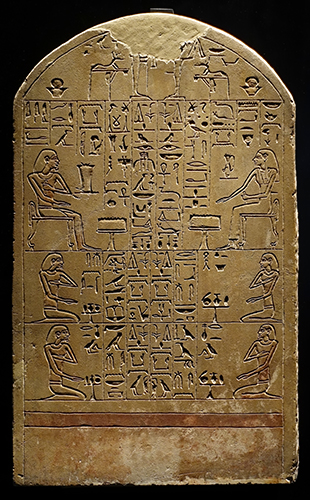
Twelfth Dynasty: 1 991 BC - 1 802 BC
Nefernay
Stela of Nefernay with his nurse and family, end of the 12th Dynasty, circa 1 800 BC.
Catalog: Limestone, Gl.WAF 34
Photo: Don Hitchcock 2018
Source: Original, Ägyptischen Museum München
Text: © Ägyptischen Museum München
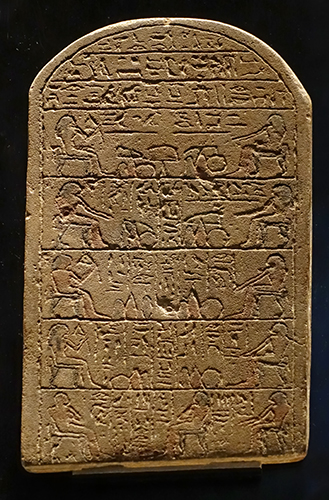
Twelfth Dynasty: 1 991 BC - 1 802 BC
Debi
Stela of Debi with his family, end of the 12th Dynasty, circa 1 800 BC.
Catalog: Limestone, Memphis, Gl.WAF 21
Photo: Don Hitchcock 2018
Source: Original, Ägyptischen Museum München
Text: © Ägyptischen Museum München
Twelfth Dynasty: 1 991 BC - 1 802 BC
Stela of Luseneb
Stela of Luseneb, Steward of the Fruit Cellar, circa 1 900 BC.
Catalog: Limestone, ÄS 36
Photo: Don Hitchcock 2018
Source: Original, Ägyptischen Museum München
Text: © Ägyptischen Museum München, Wikipedia
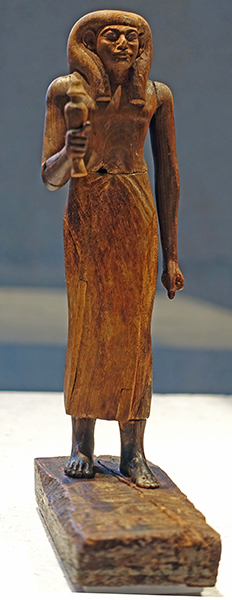
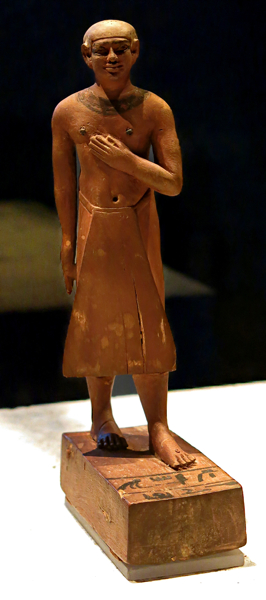
Twelfth Dynasty: 1 991 BC - 1 802 BC
Treasurer Mentuhotep and Inemakhet
Striding / standing figures of Mentuhotep with a Hes-vase and Inemakhet.
Circa 1 950 BC - 1 910 BC
Wood, from Thebes and Abusir
( The statue of Inemakhet on the right is one of the most delightful portraits I have seen from Ancient Egypt. The sculptor has achieved a level of spontaneity and insight into character usually only achieved in modern times with a digital camera. Click and click again to zoom in - Don )
Catalog: ÄM 4650 and ÄM 16202
Photo: Don Hitchcock 2018, 2015
Source: Original, Staatliche Museen zu Berlin, Neues Museum, Germany
Text: © Card at the Staatliche Museen zu Berlin (CC BY-NC-SA 3.0 DE)
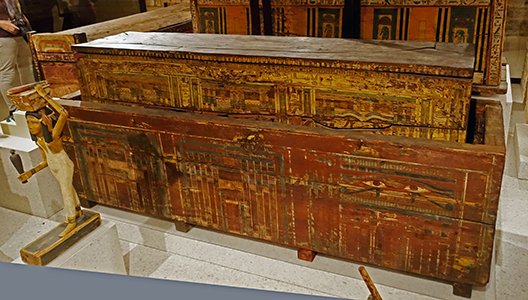
Twelfth Dynasty: 1 991 BC - 1 802 BC
Treasurer Mentuhotep
Coffins of Treasurer Mentuhotep. The three-part coffin ensemble of the house or goods governor Mentuhotep from the 12th Dynasty was found on December 6, 1823 together with the grave goods in his grave in Assasif intact. Unfortunately, the outer coffin fell victim to World War II.
( There are other missing objects in Berlin museums, such as the Palaeolithic 'Berlin Venus' which were taken by the Russians as war booty. Perhaps this was also taken. The Egyptian and other collections were never actually bombed in WWII so far as I can find out - Don )
The painted middle coffin is a wooden box casket typical of the Middle Kingdom, and the outer surface is decorated with a pair of eyes.
The inner coffin, ÄM 11, is decorated on both the inner and outer surfaces.
The middle coffin, ÄM 10, is decorated, and primed with white. Dimensions of the middle coffin: 2200 x 630 x 760 mm.
Also typical for its time of origin is the decoration scheme, which corresponds to the view of the coffin as a dwelling-house of the deceased for eternity. The vertical and horizontal inscription ribbons divide the outer sides into several image fields in which the motif of Egyptian palace facades is depicted. In the right field of the left longitudinal side, a pair of so-called Udjat eyes are also visible. They were based on the time-typical lateral position of the mummy in the coffin. Thus, the pair of eyes not only represents the connection of the deceased with the outside world, but it also serves for the magical protection of the dead.
The insides of the coffin are also decorated. Beneath the hieroglyphic sacrificial formula you can see the depictions of different furniture, clothes, food, drinks, etc. placed on the tables. With the help of these representations, everything that could be enjoyed in earthly life should be made available to the dead in the hereafter. The underlying sayings belong to the so-called coffin texts. These are proverbs referring to the transformation of the deceased into a new and eternal existence in the hereafter.
Catalog: Thebes West, Tomb of Mentuhotep, Painted Wood, ÄM 10, ÄM 11
Photo: Don Hitchcock 2015, 2018
Source: Original, Staatliche Museen zu Berlin, Neues Museum, Germany
Text: © Card at the Staatliche Museen zu Berlin, http://www.smb-digital.de/, (CC BY-NC-SA 3.0 DE)
Additional text: I. Liao after: Germer, R., The Mystery of the Mummies, Eternal Life on the Nile, 2nd extended edition, Munich / New York 1998, pp. 137ff.
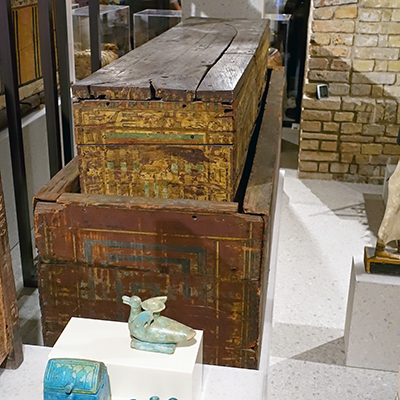
Twelfth Dynasty: 1 991 BC - 1 802 BC
Treasurer Mentuhotep
Coffins of Treasurer Mentuhotep.
Catalog: Thebes West, Tomb of Mentuhotep, Painted Wood, ÄM 10, ÄM 11
Photo: Don Hitchcock 2018
Source: Original, Staatliche Museen zu Berlin, Neues Museum, Germany
Text: © Card at the Staatliche Museen zu Berlin, http://www.smb-digital.de/, (CC BY-NC-SA 3.0 DE)

Twelfth Dynasty: 1 991 BC - 1 802 BC
Treasurer Mentuhotep
Mentuhotep was an official and treasurer under the 12th dynasty pharaoh Senusret I. Mentuhotep is one of the best attested officials of the Middle Kingdom period. There is a series of statues found at Karnak, showing him as a scribe. On these he has been given the title of overseer of all royal works, which would suggest that he was involved in overseeing the construction of the temple at Karnak.
At el-Lisht he had a large tomb next to the pyramid of Senusret I. When it was found it was badly damaged, but there are remains of high quality reliefs and fragments of statues. The burial chamber still contained two sarcophagi, one smashed and the other one well preserved, made of granite and with brightly painted interiors.
Dimensions, including rudder: 1410 x 360 x 600 mm.
This ship from the tomb of Treasurer Mentuhotep is a travel boat, which - as the stowed mast shows - is on the ride downstream. The hull is painted green, the deck white with red stripes, which would probably reflect the beam construction. The mast and the two yards normally would rest amidships on the white support post made for them. Mentuhotep sits in the cabin behind it, ( not readily visible in this image - Don ) almost mummified in a white coat, on which his title and name are written. A stone anchor is stored in the prow.
On the outside of the yellow-painted cabin, black lines seem to indicate lacing. The shield of the Mentuhotep is painted on one side. The crew consists of 16 oarsmen, a pilot at the bow and a steersman at the helm. One servant grinds grain, another kneads dough.
( note that in the closeup we can see that the models in the boat have both arms capable of movement. Obviously the models were made in bulk, though for a specific role such as a rower or a grinder of grain or helmsman on board the vessel, but the final adjustment of the arms was able to be accomplished with ease. The ingenious design and construction of the rudder is also interesting, providing the ability to ride up out of the way without damage if an obstruction was encountered, such as a sand bank or a snag, but being also capable of fine adjustment with the long lever provided for the steersman. Note also that the actual boat itself must have had more robust connections for that of the rudder pole to the support pole in the back of the boat, as well as that of the rudder pole to the stern of the boat, than are shown in this model. These connections may have been in the form of thick, robust 'dowels', with a large amount of 'play' or 'slop', but with strong cordage to keep everything together - Don )
Catalog: Thebes West, Tomb of Mentuhotep, Stuccoed, Painted Wood, ÄM 12
Photo: Don Hitchcock 2018
Source: Original, Staatliche Museen zu Berlin, Neues Museum, Germany
Text: © Card at the Staatliche Museen zu Berlin, http://www.smb-digital.de/, (CC BY-NC-SA 3.0 DE)
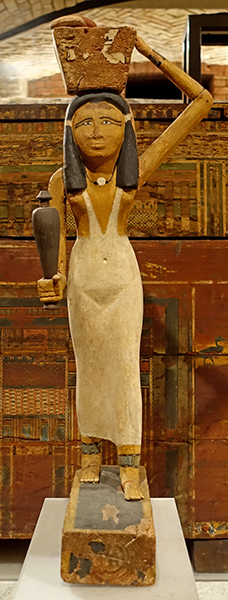
Twelfth Dynasty: 1 991 BC - 1 802 BC
Treasurer Mentuhotep
An offering bearer from the tomb of Mentuhotep, holding a Hes-vase.
Catalog: Thebes West, Tomb of Mentuhotep, Painted Wood, ÄM 22
Photo: Don Hitchcock 2018
Source: Original, Staatliche Museen zu Berlin, Neues Museum, Germany
Text: © Card at the Staatliche Museen zu Berlin, http://www.smb-digital.de/, (CC BY-NC-SA 3.0 DE)

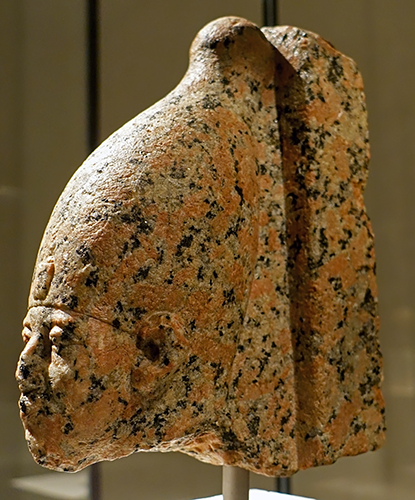
Twelfth Dynasty: 1 991 BC - 1 802 BC
Senusret III / Sesostris III
Head of a statue of the Pharoah Senusret III / Sesostris III
1 875 BC - 1 840 BC
Senusret III is well known for his distinctive statues which are almost immediately recognisable as his. On them, the king is depicted at different ages, and in particular on the aged ones he sports a strikingly somber expression: the eyes are protruding from hollow eyesockets with pouches and lines under them, the mouth and lips have a grimace of bitterness, and the ears are enormous and protruding forwards. In sharp contrast with the even-exaggerated realism of the head and regardless of its age, the rest of the body is idealised as forever young and muscular in a more classical pharaonic fashion.
Senusret III cleared a navigable canal through the first cataract. He also relentlessly pushed his kingdom's expansion into Nubia (from 1866 to 1863 BC) where he erected massive river forts including Buhen, Semna and Toshka at Uronarti.
Catalog: Thebes/Karnak (?), pink granite, ÄM 9529
Photo: Don Hitchcock 2018
Source: Original, Staatliche Museen zu Berlin, Neues Museum, Germany
Text: © Card at the Staatliche Museen zu Berlin (CC BY-NC-SA 3.0 DE)
Additional text: Wikipedia
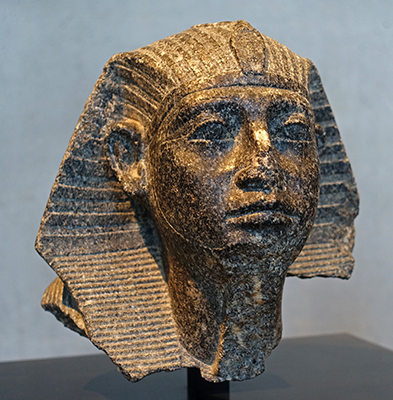
Twelfth Dynasty: 1 991 BC - 1 802 BC
Pharaoh Senusret III, Khakaure, also known as Sesostris III.
Head from a sphinx of the pharaoh Sesostris III with youthful features.
Granite, circa 1870 BC.
Catalog: Granite, ÄS 7110
Photo: Don Hitchcock 2015, 2018
Source: Original, Ägyptischen Museum München
Text: © Ägyptischen Museum München, Wikipedia
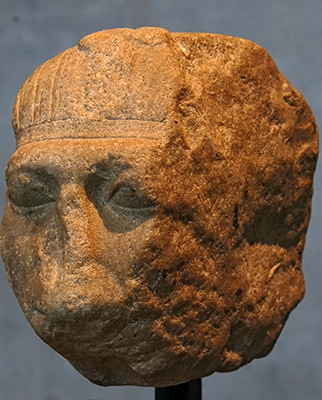
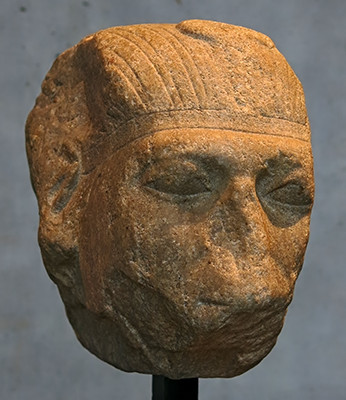
Twelfth Dynasty: 1 991 BC - 1 802 BC
Pharaoh Senusret III, Khakaure, also known as Sesostris III.
Head from a statue of the pharaoh Sesostris III with aged features.
Quartzite , circa 1 850 BC.
Catalog: Quartzite, ÄS 4857
Photo: Don Hitchcock 2015
Source and text: Original, Musée du Louvre
Additional text: http://cartelfr.louvre.fr/
Twelfth Dynasty: 1 991 BC - 1 802 BC
Hippopotamus
Small sculpture of a hippopotamus.
Circa 2 000 BC - 1 800 BC.
Length 115 mm, width 65 mm, height 53 mm.
Length of tail to left cheek 115 mm, length of tail to snout 118 mm, width of belly 65 mm, back height 53 mm.
Catalog: Faience, ÄS 6040
Photo: Don Hitchcock 2015, 2018
Source: Original, Ägyptischen Museum München
Text: © Ägyptischen Museum München
Additional text: https://www.bavarikon.de
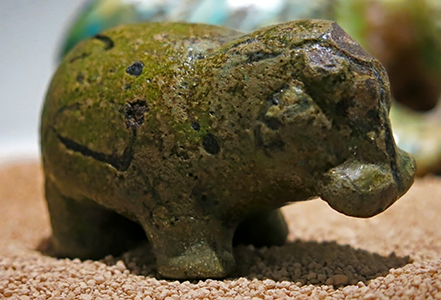
Twelfth Dynasty: 1 991 BC - 1 802 BC
Hippopotamus
Small sculpture of a hippopotamus.
Catalog: Faience, ÄS 1571
Photo: Don Hitchcock 2015
Source: Original, Ägyptischen Museum München
Text: © Ägyptischen Museum München
Twelfth Dynasty: 1 991 BC - 1 802 BC
Mouse
Small sculpture of a mouse.
Catalog: Faience, ÄS 1570
Photo: Don Hitchcock 2015, 2018
Source: Original, Ägyptischen Museum München
Text: © Ägyptischen Museum München
Twelfth Dynasty: 1 991 BC - 1 802 BC
Lids from Canopic Jars
This set of figurative lids from viscera jars stylistically references the portraits of the 12th Dynasty. Its quality attests to the creative energy of that era, permeating almost every medium.
Middle Kingdom, 12th Dynasty circa 1850 BC
Limestone / ÄS 7128 - 7131
Donated by the Friends Group of the Egyptian Museums of München.
Photo: Don Hitchcock 2018
Source and text: Munich Museum
Twelfth Dynasty: 1 991 BC - 1 802 BC
Pharaoh Amenemhat III / Amenemhet III
Praying statue of Pharoah Amenemhat III, circa 1 840 BC - 1 800 BC.
Amenemhet III brought Egypt to a peak of economic prosperity by completing a system to regulate the inflow of water into Lake Moeris, in the Al-Fayyūm depression southwest of Cairo. The resulting stabilisation of the water level also drained some of the marshes that had surrounded the old lake. As part of this great work, the labyrinth described by the Greek historian Herodotus was probably built nearby, south of one of Amenemhet's pyramids at Hawara, in Al-Fayyūm.
To celebrate the reclamation of 153 600 acres (62 200 hectares) of land for agricultural use, Amenemhet erected two colossi of himself nearby, also described by Herodotus. Amenemhet worked the turquoise mines at Sinai with unprecedented intensity.
Catalog: Dolerite, Memphis, ÄM 1121
Photo: Don Hitchcock 2018
Source: Original, Staatliche Museen zu Berlin, Neues Museum, Germany
Text: © Card at the Staatliche Museen zu Berlin
Additional text: Encyclopedia Brittanica, Wikipedia
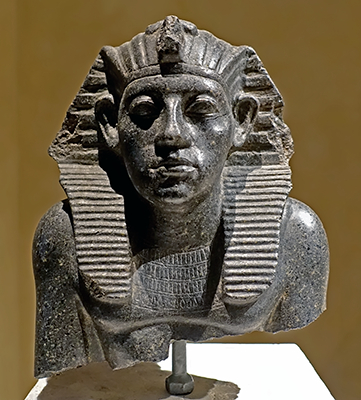
Twelfth Dynasty: 1 991 BC - 1 802 BC
Pharaoh Amenemhat III / Amenemhet III
Head of a statue of Pharoah Amenemhat III, circa 1 840 BC.
He is portrayed here wearing the king's head cloth, the Nemes.
Height 23 cm, width 20 cm, depth 17 cm
Catalog: Grey Granite, ÄM 17551
Photo: Don Hitchcock 2018
Source: Original, Staatliche Museen zu Berlin, Neues Museum, Germany
Text: © Card at the Staatliche Museen zu Berlin
Additional text: http://www.egyptian-museum-berlin.com/c42.php

Twelfth Dynasty: 1 991 BC - 1 802 BC
Pharaoh Amenemhat III / Amenemhet III
Head of a statue of Pharoah Amenemhat III, circa 1 820 BC.
He is portrayed here wearing the king's head cloth, the Nemes.
Catalog: Quartzite, ÄM 11348
Photo: Don Hitchcock 2018
Source: Original, Staatliche Museen zu Berlin, Neues Museum, Germany
Text: © Card at the Staatliche Museen zu Berlin
Additional text: http://www.egyptian-museum-berlin.com/c42.php
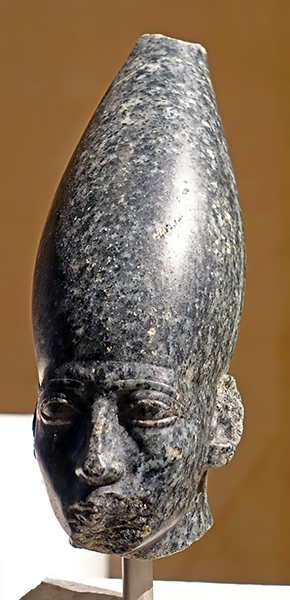
Twelfth Dynasty: 1 991 BC - 1 802 BC
Pharaoh Amenemhat III / Amenemhet III
Head of a statue of Pharoah Amenemhat III, circa 1 830 BC.
He is portrayed here wearing the Hedjet, the crown of Upper (Southern) Egypt.
It is also known as the White Crown. No crowns are known to have been found in any archeological digs. Some Egyptologists have speculated that the Hedjet was made out of leather, felt, or some other fabric. Another possibility is that it was woven like a basket using plant fibre., as the deshret (red crown) is known to have been.
Height 27 cm.
Catalog: Granite, ÄM 17950
Photo: Don Hitchcock 2018
Source: Original, Staatliche Museen zu Berlin, Neues Museum, Germany
Text: © Card at the Staatliche Museen zu Berlin
Additional text: Wikipedia
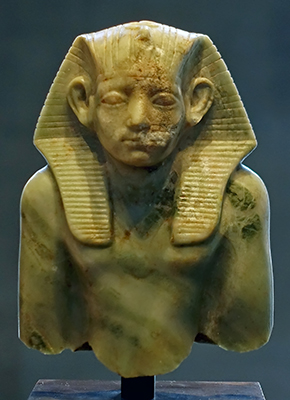
Twelfth Dynasty: 1 991 BC - 1 802 BC
Pharaoh Amenemhat III
Upper half of a seated figure of Pharaoh Amenemhat III.
Ophicalcite, ophiolite or verde antique, the material of which this sculpture is made, is a serpentinite breccia popular since ancient times as a decorative facing stone. It is a dark, dull green, white-mottled (or white-veined) serpentine, mixed with calcite, dolomite, or magnesite, which takes a high polish.
Catalog: Fayum (?), ÄS 6762
Photo: Don Hitchcock 2018
Source: Original, Ägyptischen Museum München
Text: © Ägyptischen Museum München
Additional text: Wikipedia
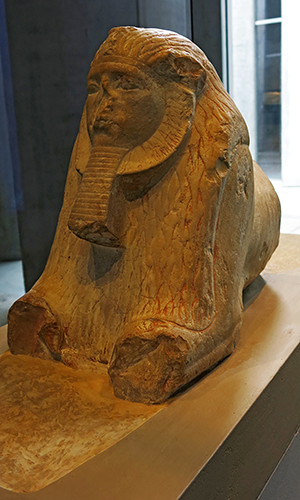
Twelfth Dynasty: 1 991 BC - 1 802 BC
Pharaoh Amenemhat III
Maned sphinx of Pharaoh Amenemhat III.
Catalog: Limestone, ÄS 7132
Photo: Don Hitchcock 2015
Source: Original, Ägyptischen Museum München
Text: © Ägyptischen Museum München, Wikipedia
Twelfth Dynasty: 1 991 BC - 1 802 BC
Statuette of the woman Pakhetemhat.
Found during excavations at Antinoe, in the tomb of Pakhetemhat.
The cedar used in the statuette was imported to Egypt from the coasts of Syria and Lebanon, this trade occurring from 3 000 BC onwards.
Circa 1 900 BC.
Height 310 mm, width 70 mm, depth 147 mm.
Catalog: Cedar, linen, Antinoe, East bank Middle Egypt, painted yellow ochre body, black and white eyes, Aile Sully, Room 334, Materials and Techniques, Vitrine 3, E 20576
Photo: Don Hitchcock 2015, 2018
Source and text: Original, Louvre Museum, Paris, France, https://collections.louvre.fr/
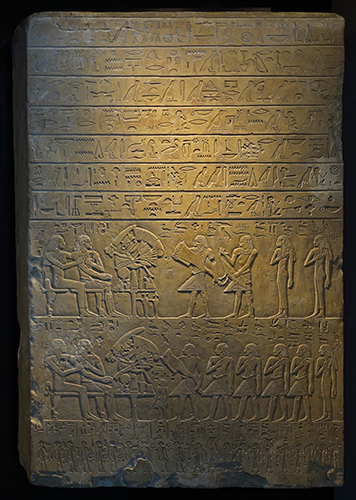
Twelfth Dynasty: 1 991 BC - 1 802 BC
Sobeki
Stela of the Nomarch Sobeki
One characteristic of Middle Kingdom relief is clearly defined shapes. This is what allows the rows of family members on this stele to appear as a continuation of the hieroglyphs from the biographical inscription.
Middle Kingdom, circa 1 900 BC.
Catalog: Limestone / Abydos / Gl. WAF 31.
Photo: Don Hitchcock 2018
Source: Original, Ägyptischen Museum München
Text: © Ägyptischen Museum München, Wikipedia
The art of the Third Intermediate Period (1077 - 664 BC)
In the period following the collapse of the New Kingdom - when the land was divided between a semi-independent state under Libyan rule in Lower Egypt and the 'Amun Theocracy' in Upper Egypt - art production was greatly reduced: the tombs were no longer decorated and only a few temples were built and embellished with reliefs.
Instead, another medium gained prominence - painting. As early as the end of the New Kingdom, coffins and papyri started to replace tomb walls as bearers fo depictions.
Yet the images no longer illustrated the daily life of the artisans and farmers, or the feasts of affluent Egyptians, but instead showed events in the Afterlife. They illustrate the afterlife guides, such as the Book of the Dead or the Amduat, and show the deceased offering and praying before the gods. The style ties directly into the art of the late New Kingdom (Ramesside Period), as is readily apparent from the slim proportions of the body and the diaphonous costume of the deceased.
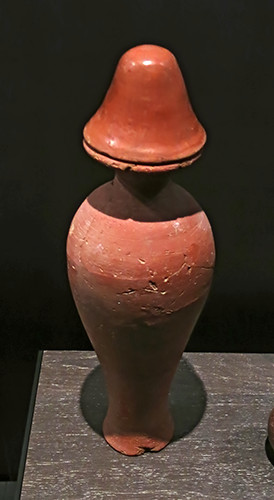
Twelfth Dynasty: 1 991 BC - 1 802 BC
Hes-vase
A Hes-vase is a tall, slim, ritual vessel for libations.
( This appears to have been thrown in clay on a wheel, and fired to earthenware temperatures - Don )
Qurna, the site where this was found, is located on the West Bank of the River Nile opposite the modern city of Luxor in Egypt near the Theban Hills.
Catalog: Ceramic, Qurna, ÄS 5876, ÄS 4122
Photo: Don Hitchcock 2015
Source: Original, Ägyptischen Museum München
Text: © Ägyptischen Museum München, Wikipedia
Twelfth Dynasty: 1 991 BC - 1 802 BC
Falcon God
Limestone head of Horus, the falcon god, depicted here with human ears. The rest of the body is lost.
Photo: Don Hitchcock 2015, 2018
Source: Original, Ägyptischen Museum München
Text: © Ägyptischen Museum München, Wikipedia
Twelfth Dynasty: 1 991 BC - 1 802 BC
Sopdu God
Quartzite head of the god Sopdu.
Circa 1 950 BC - 1 900 BC
Catalog: ÄS 7106
Photo: Don Hitchcock 2015, 2018
Source: Original, Ägyptischen Museum München
Text: © Ägyptischen Museum München, Wikipedia
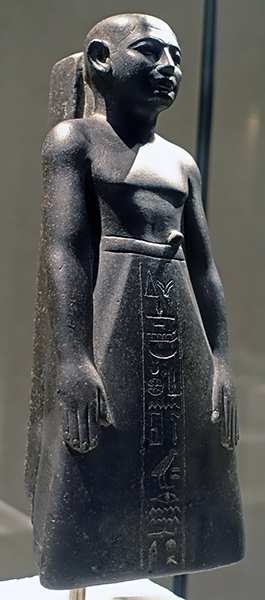

Twelfth Dynasty: 1 991 BC - 1 802 BC
Tetu
Praying statue of Tetu.
Circa 1850 BC.
Catalog: Granite, Heliopolis, ÄM 8432
Photo: Don Hitchcock 2018
Source: Original, Staatliche Museen zu Berlin, Neues Museum, Germany
Text: © Card at the Staatliche Museen zu Berlin, (CC BY-NC-SA 3.0 DE)
Additional text: http://www.griffith.ox.ac.uk/gri/3berlin.pdf
Models
In the Middle Kingdom, wooden models made up a number of individual figures, and depicting workshops, breweries, bakeries, slaughterhouses, ships, granaries and houses, accompanied the deceased in his tomb. They replaced the servant statuettes as well as the corresponding two dimensional images of the relief-decorated Old Kingdom tombs and were meant to guarantee the deceased's provisioning in foodstuffs and all objects of daily life.
Text above: © Ägyptischen Museum München
Twelfth Dynasty: 1 991 BC - 1 802 BC
Cattle and cowherds.
Circa 1 950 BC.
Catalog: ÄS 7144
Photo: Don Hitchcock 2015, 2018
Source: Original, Ägyptischen Museum München
Text: © Ägyptischen Museum München, Wikipedia
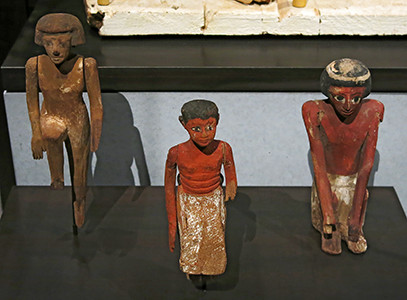
Twelfth Dynasty: 1 991 BC - 1 802 BC
Figures from various models.
Circa 1 900 BC
Catalog: ÄS 1565, ÄS 1566, ÄS 425,
Photo: Don Hitchcock 2015
Source: Original, Ägyptischen Museum München
Text: © Ägyptischen Museum München, Wikipedia
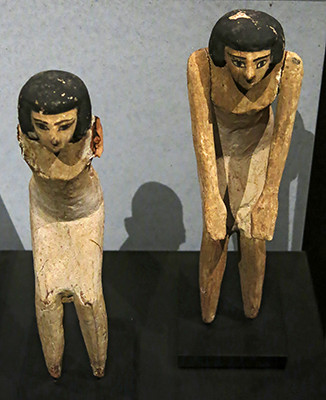
Twelfth Dynasty: 1 991 BC - 1 802 BC
Figures from a granary model.
Circa 1 900 BC
Catalog: ÄS 7258, ÄS 7259
Photo: Don Hitchcock 2015
Source: Original, Ägyptischen Museum München
Text: © Ägyptischen Museum München, Wikipedia
Stelae of the Middle Kingdom
A stela's main function was to perpetuate the memory of the deceased in image and text. Next to formulaic prayers, stelae texts could also contain biographical notes on the donor, who was usually shown beside members of his family. Gods appear on stelae for the first time in the Middle Kingdom; the first to be depicted in a small pictorial section at the top of the stela were Osiris, god of resurrection and Lord of the Netherworld, and Anubis, the deceased's guide, in the form of a jackal. In their content and appearance, some Middle Kingdom stelae represent a continuation of the Old Kingdom false-door stelae.
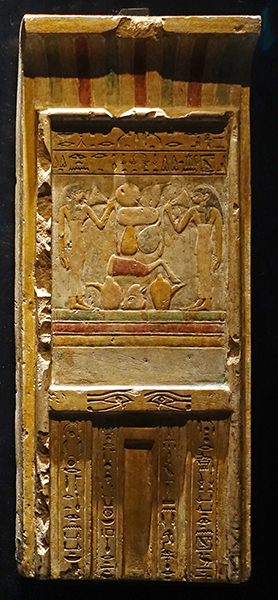
Twelfth Dynasty: 1 991 BC - 1 802 BC
Stela of Nofret
Stela of Nofret in the shape of a false-door stela.
Circa 1 900 BC.
Catalog: limestone, Memphis (?), GL 41
Photo: Don Hitchcock 2018
Source: Original, Ägyptischen Museum München
Text: © Ägyptischen Museum München, Wikipedia

Twelfth Dynasty: 1 991 BC - 1 802 BC
Stela of the high treasurer Ichernofret.
Circa 1860 BC.
Catalog: Abydos, Limestone, ÄM 1204
Photo: Don Hitchcock 2018
Source: Original, Staatliche Museen zu Berlin, Neues Museum, Germany
Text: © Card at the Staatliche Museen zu Berlin (CC BY-NC-SA 3.0 DE)
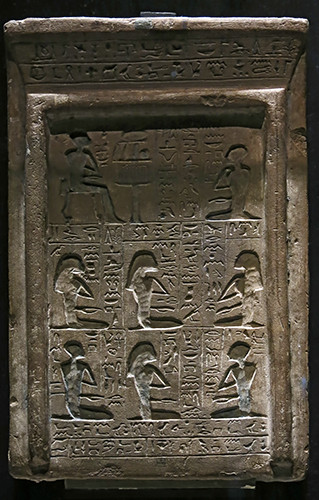
Twelfth Dynasty: 1 991 BC - 1 802 BC
Stela of Iuseneb
Stela of Iuseneb, steward of the Fruit Cellar.
( note that the figures on this stela have been considerably deepened, with the base left unsmoothed after the chiselling. It may be that the figures were designed to be filled with, perhaps, faience, which was never done, or has disappeared since manufacture - Don )
Circa 1 900 BC.
Catalog: limestone, ÄS 36
Photo: Don Hitchcock 2015
Source: Original, Ägyptischen Museum München
Text: © Ägyptischen Museum München, Wikipedia
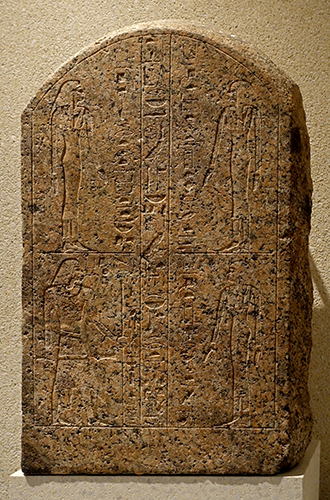
Twelfth Dynasty: 1 991 BC - 1 802 BC
Stela of Nofret
Stela of Nofret with her mother, her husband (?) and her grandmother.
12th Dynasty circa 1850 BC.
Catalog: Abydos (?), pink granite, ÄM 7280
Photo: Don Hitchcock 2018
Source: Original, Staatliche Museen zu Berlin, Neues Museum, Germany
Text: © Card at the Staatliche Museen zu Berlin (CC BY-NC-SA 3.0 DE)
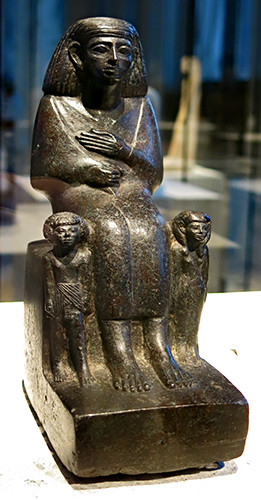
Twelfth Dynasty: 1 991 BC - 1 802 BC
Family Group
Statue-group of cloaked man with family, from Thebes.
Circa 1 900 BC
Catalog: ÄM 4435
Photo: Don Hitchcock 2015
Source: Original, Staatliche Museen zu Berlin, Neues Museum, Germany
Text: © Card at the Staatliche Museen zu Berlin (CC BY-NC-SA 3.0 DE)
Additional text: http://www.griffith.ox.ac.uk/gri/3berlin.pdf
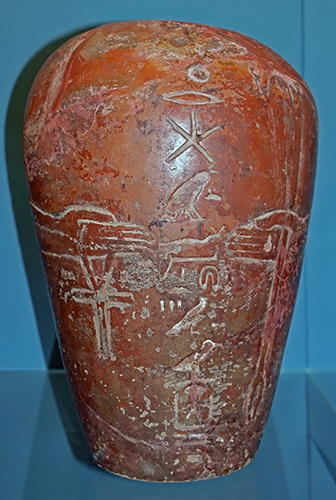
Twelfth Dynasty: 1 991 BC - 1 802 BC
Wahka
Redware Canopic jar of Wahka, 12th Dynasty, reign of Amenemhat III, 1 860 BC - 1 814 BC. Probably from the tomb of the governor Wahka II at Qaw el-Kebir. The inscription invokes the god Duamutef, whose protection is represented by the arms carved in the sides of the jar. The hands grasp the Ankh (sign of life) and the Was-sceptre, symbolising his authority. There is a column of Hieroglyphic text, but no lid.
Height 286 mm.
Catalog: Redware pottery, Tomb of the Governor Wahka II at Qaw el-Kebir (?), EA58780
Photo: Don Hitchcock 2018
Source: Original, British Museum
Text: Card with the display at the British Museum, https://www.britishmuseum.org/, © Trustees of the British Museum, CC BY-NC-SA 4.0
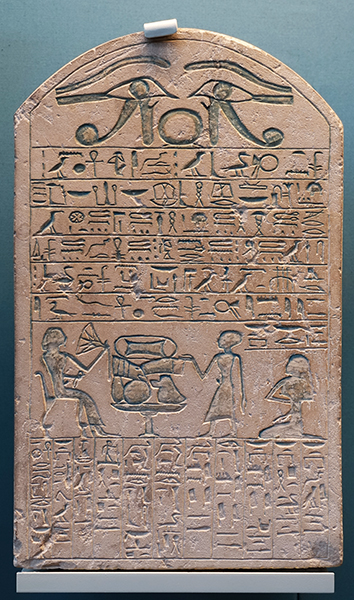
Twelfth Dynasty: 1 991 BC - 1 802 BC
Stela
Circa 1 985 BC - 1 795 BC
Round-topped limestone stela of Gebu, divided into four registers:
1 - Two wedjat-eyes.
2 - Six rows of Hieroglyphic text.
3 - Scene of the deceased seated before an offering-table and a standing male and kneeling female figure.
4 - Eleven columns of Hieroglyphic text.
The museum card says that EA223 is the limestone stela of Sabu (sic), with an address to the living.
The text contains an appeal to the living to recite the offering-formula for the benefit of the dead man's Ka. The deceased is shown at a table of offerings. The stela was made by the dead man's son Ameny to perpetuate his father's memory.
Height 47 cm (case), width 28 cm (case).
Catalog: EA223
Photo: Don Hitchcock 2018
Source: Original, British Museum
Text: Card with the display at the British Museum, https://www.britishmuseum.org/, © Trustees of the British Museum, CC BY-NC-SA 4.0
Twelfth Dynasty: 1 991 BC - 1 802 BC
Two Hes Vases
Circa 1 985 BC - 1 795 BC (from museum card)
( Note that there are two hes vases side by side in the museum display, with only one identification. The online catalog does not have an image available for the given catalog number, EA57567, at the time of writing, November 2022.
A number of commercial vendors of such images place both hes vases in the same image, and simply identify the pair of hes vases as the singular EA57567.
From the description, EA57567 is the one on the right above - Don )
Description on online BM catalog for EA57567:
Redware pottery hes-vase; red slip.
Findspot: Qaw el-Kebir
Diameter 102 mm, height 325 mm.
Catalog: EA57567
Photo: Don Hitchcock 2018
Source: Original, British Museum
Text: Card with the display at the British Museum, https://www.britishmuseum.org/, © Trustees of the British Museum, CC BY-NC-SA 4.0
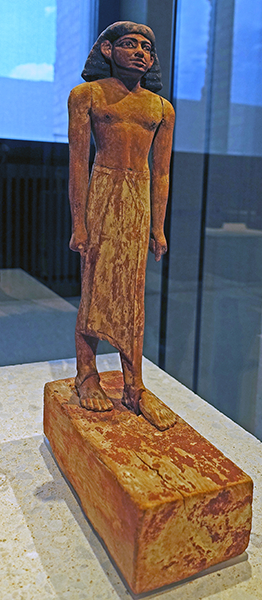
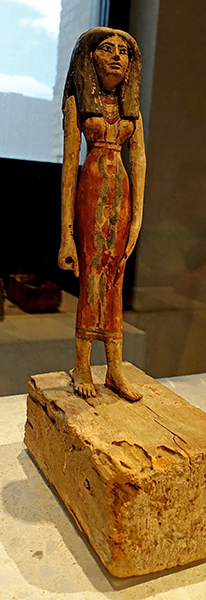
Twelfth Dynasty: 1 991 BC - 1 802 BC
Striding and standing man and woman
Circa 1 950 BC - 1 900 BC
Wood, from Meir and West Thebes (?)
Catalog: ÄM 21611 and ÄM 9536
Photo: Don Hitchcock 2018
Source: Original, Staatliche Museen zu Berlin, Neues Museum, Germany
Text: © Card at the Staatliche Museen zu Berlin (CC BY-NC-SA 3.0 DE)
Twelfth Dynasty: 1 991 BC - 1 802 BC
Cedarwood coffin of the army commander Sepi.
Middle to late 12th Dynasty, about 1850 BC - 1800 BC. From Deir el-Bersha, probably from the forecourt of the tomb of Djehutyhotep.
Sepi, like the physician Gua, was probably a member of the entourage of the governor Djehutyhotep. The east side of his coffin is decorated with a pair of eyes to enable the deceased to see, and a false-door motif to allow the spirit to leave and re-enter the coffin. Inscriptions assure the provision of offerings and the protection of deities. The interior is undecorated.
Width 520 mm, length 2130 mm, height 785 mm.
Catalog: EA55315
Photo: Don Hitchcock 2015, 2018
Source: Original, British Museum
Text: Card at museum display, http://www.britishmuseum.org/, © Trustees of the British Museum, CC BY-NC-SA 4.0

Twelfth Dynasty: 1 991 BC - 1 802 BC
Flint dagger blade, Middle Kingdom, circa 1900 BC - 1800 BC, from Buhen.
The haft was attached to a handle by adhesive, traces of which remain.
( note that this item could well be the head of a spear or javelin, rather than a dagger - Don )
Catalog: EA65771
Photo: Don Hitchcock 2015
Source: Original, British Museum
Text: Card at museum display, © Trustees of the British Museum, CC BY-NC-SA 4.0

Twelfth Dynasty or later: 1 991 BC - 1 200 BC
Stelae
Four stelae with prayers asking the gods - Anubis or Osiris - to let sacrifices offered to them benefit the dead person as well. Such prayers always begin with the same words.
A: Kaj sacrificing to the butler Ip and his father Sobek-nacht.
Limestone, Middle Kingdom, 1991 - 1785 BC.
B: The 'Chariot fighter at the garrison of Pharaoh', Inay, and his mother Duat-tawy sitting at a well-provided offering table.
Limestone, New Kingdom, 1550-1200 BC.
Photo: Don Hitchcock 2014
Source: Original, Københavns (Copenhagen) Museum, National Museum of Denmark
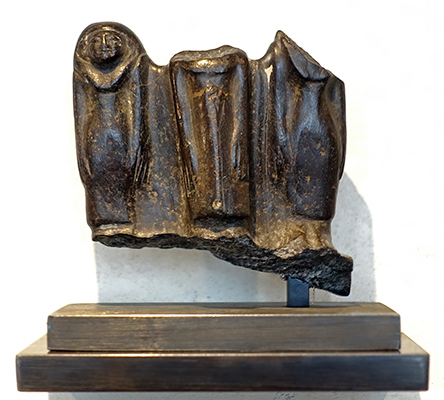
Twelfth - Thirteenth Dynasty: 1 991 BC - 1 639 BC
Family Group
Middle Kingdom, 12th - 13th dynasty, 1 800 BC - 1 700 BC.
Catalog: Serpentinite, ÄS 2831
Photo: Don Hitchcock 2018
Source: Original, Ägyptischen Museum München
Text: © Ägyptischen Museum München
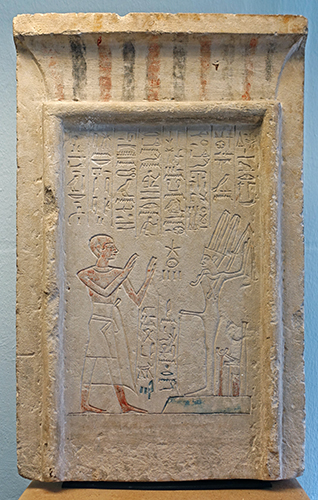
Twelfth - Thirteenth Dynasty: 1 991 BC - 1 639 BC
Redi-en-ef-en-i
Stele from the grave of Redi-en-ef-en-i, circa 1 700 BC.
The text of this stele says that the god Min (right) will be given by the 'Great Chief of the city (named) Redi-en-ef-en-i', who worships him, an 'offering consisting of bread and beer, beef and poultry, alabaster and linen as well as incense and royal ointment'.
The stela was donated to the deceased 'by his brother, who (always) keeps his name alive'.
( note that the god Min is depicted as having an erection - Don )
Catalog: Limestone, painted
Photo: Don Hitchcock 2018
Source and text: Original, Museum August Kestner, Hannover

Twelfth - Thirteenth Dynasty: 1 991 BC - 1 639 BC
Mirror
Catalog: Bronze, Inv. 81/393
Photo: Don Hitchcock 2015
Source and text: Badisches Landesmuseum Karlsruhe Germany

Twelfth - Thirteenth Dynasty: 1 991 BC - 1 639 BC
Family Group
Seated figure of the beer brewer Renef-seneb-dag and his daughter Daget.
Circa 1 850 BC - 1 750 BC.
Dimensions: 335 x 105 x 193 mm
The group shows a man on a piece of seating furniture with a short backrest, on the right side of which is a much smaller woman. His upper arms are close to the body, while his forearms and outstretched hands rest on his thighs. The upper ends of his calf-length apron are knotted underneath his chest. The striking head is dominated by a hairless, angular skull with very large, protruding ears. The face shows a serious, albeit confident expression, which is mainly determined by the mouth area.
To the right of him is a standing female figure in a simple ankle-length strap dress with long hair, of which two strands lie on the chest, up to knee height. With her left hand she embraces the man's calf - even if this gesture is only hinted at.
Without the inscription, which is located on both sides of the seat, a clear identification of the people would be almost impossible. This inscription shows that the seat figure is the brewer Renef-seneb-dag together with his daughter Daget. The man is called 'loved by his master, who is justified in his heart, a man of feast, loved by the myrrh, united with the 'beautiful day' [the feast]. In a sacrificial formula, he asks the cataract gods Chnum, Satis and Anukis for cool water that comes from one of the Nile springs on Elephantine. This mention in particular makes it very likely that the statuette on the island was placed in the first cataract in one of the sanctuaries there.
(Jana Helmbold-Doyé)
Catalog: ÄM 10115
Photo: Don Hitchcock 2018
Source: Original, Staatliche Museen zu Berlin, Neues Museum, Germany
Text: © Card at the Staatliche Museen zu Berlin, http://www.smb-digital.de/, (CC BY-NC-SA 3.0 DE)
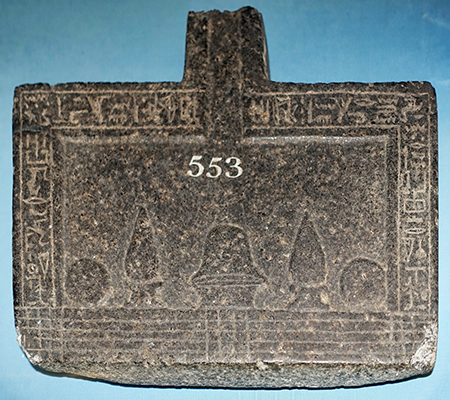
Twelfth - Thirteenth Dynasty: 1 991 BC - 1 639 BC
Black granite offering-table with representations of vases and cakes, and hieroglyphic text
The surface is carved in relief with images of food and drink offerings.
Length 360 mm, width 290 mm.
Catalog: Granite, provenance unknown, EA553
Photo: Don Hitchcock 2018
Source: Original, British Museum
Text: Card with the display at the British Museum, © Trustees of the British Museum, CC BY-NC-SA 4.0
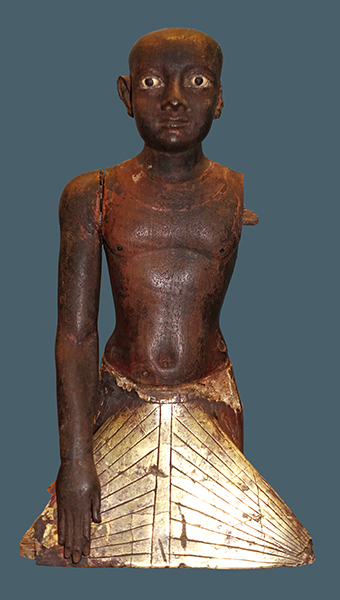
Twelfth - Thirteenth Dynasty: 1 991 BC - 1 639 BC
Gilded Statue
Gilded wooden statuette of an unidentified man.
Although the man is not a king, he wears the royal shendyt kilt, an example of the use of kingly attributes in artistic representation. The body is carved from East African ebony, the kilt of gilded tamarisk.
Circa 1 985 BC - 1 700 BC
Wooden male figure with a shaven head; inlaid eyes; the right arm is lost; shendyt kilt covered in a layer of gilded plaster; modern legs.
Height 310 mm, width 121 mm, depth 77 mm.
Catalog: wood, gold, plaster, provenance unknown, EA56842
Photo: Don Hitchcock 2018
Source: Original, British Museum
Text: Card with the display at the British Museum, © Trustees of the British Museum, CC BY-NC-SA 4.0

Twelfth - Thirteenth Dynasty: 1 991 BC - 1 639 BC
Statuette
Wooden statuette of a woman
Circa 1 985 BC - 1 795 BC
From Asyut, tomb 35.
Wooden female figure wearing a gala-wig; painted eyes; arms attached by tenons; two rows of Hieroglyphic text on top of the plinth.
Height 455 mm, width 99 mm (plinth), depth 215 mm (plinth)
Catalog: Painted wood, Asyut, EA45193
Photo: Don Hitchcock 2018
Source: Original, British Museum
Text: Card with the display at the British Museum, © Trustees of the British Museum, CC BY-NC-SA 4.0
Twelfth - Thirteenth Dynasty: 1 991 BC - 1 639 BC
Box
Circa 2 033 BC - 1 670 BC
An element of a box, decorated with representations of papyrus, djed pillars, Sa signs.
Height 150 mm, length 206 mm, thickness 10 mm.
Catalog: Wood, bone, Room 334, Sully Wing, level 0, Vitrine 9, E 3197 (1)
Photo: Don Hitchcock 2018
Source and text: Original, Louvre Museum, https://collections.louvre.fr/
95
Twelfth - Thirteenth Dynasty: 1 991 BC - 1 639 BC
Furniture decoration
Circa 2 033 BC - 1 710 BC
Decoration on furniture in elephant ivory, Middle Kingdom.
Photo: Don Hitchcock 2018
Source and text: Original, Museum Card,
Louvre Museum
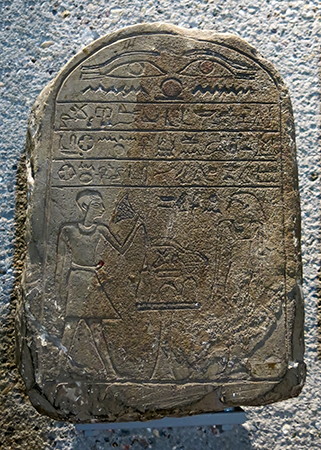
Twelfth - Thirteenth Dynasty: 1 991 BC - 1 639 BC
Dedu-Sobek
Stele of Dedu-Sobek
Depicted is Dedu-Sobek and his wife Luef-Seneb in front of a sacrificial table. The text contains a funeral prayer to Osiris of Abydos.
Circa 1 991 BC - 1 650 BC
Catalog: Sandstone, Inv. H 413
Photo: Don Hitchcock 2015
Source and text: Original, Badisches Landesmuseum Karlsruhe Germany
Twelfth - Thirteenth Dynasty: 1 991 BC - 1 639 BC
Iabou, office worker
The bureaucrat sits cross-legged, with a cloak and large wig. He is identified as a storekeeper, an abbot-priest.
Height 155 mm, width 74 mm, depth 95 mm.
The piece is made of gabbro, a crystalline stone of the same family as diorite, from which it is very difficult to distinguish.
Catalog: Gabbro, Aile Sully, Room 334, Materials and Techniques, Vitrine 4, E 10974
Photo: Don Hitchcock 2015, 2018
Source and text: Louvre Museum, Paris, France, https://collections.louvre.fr/
Twelfth - Twentieth Dynasties: circa 1 991 BC - 1 077 BC
Bronze axes
Bronze utility axes
Origin unknown. Middle and New Kingdom, 2nd millennium BC
Catalog: Bronze, Inv. Nr. 1950.155; 1935.200.322
Photo: Don Hitchcock 2018
Source and text: Original, Museum August Kestner, Hannover
Twelfth - Twentieth Dynasties: circa 1 991 BC - 1 077 BC
Bronze axes
Bronze ceremonial axes
Origin unknown. Middle and New Kingdom, 2nd millennium BC
Catalog: Bronze, Inv. Nr. 1935.200.98, 1935.200.323
Photo: Don Hitchcock 2018
Source and text: Original, Museum August Kestner, Hannover
The Thirteenth Dynasty
1 803 BC - 1 639 BC
Ruled from Memphis, over Middle and Upper Egypt, contemporaneous with the Fourteenth Dynasty, which ruled from Avaris in the Nile Delta over Middle and Upper Egypt.
| Thirteenth Dynasty | ||||||
|---|---|---|---|---|---|---|
| Name | Horus (Throne) Name |
Consort | Burial | Years | Dates | Comments |
| Sekhemre Khutawy Sobekhotep | Referred to by some as Sebekhotep I |
|||||
| Sonbef | Perhaps a son of Amenemhat IV and brother of Sekhemre Khutawy Sobekhotep. |
|||||
| Nerikare | ||||||
| Sekhemkare Amenemhat V | 1 796 BC - 1 793 BC | Dates according to Egyptologists Kim Ryholt and Darrell Baker |
||||
| Ameny Qemau | ||||||
| Hotepibre Qemau Siharnedjheritef | Perhaps identical with King Sehotepibre in the Turin Canon |
|||||
| Iufni | Known only from the Turin canon | |||||
| Seankhibre Ameny-Intef-Amenemhat VI | ||||||
| Semenkare Nebnuni | ||||||
| Sehetepibre Sewesekhtawy | ||||||
| Sewadjkare I | Known only from the Turin canon | |||||
| Nedjemibre | ||||||
| Khaankhre Sobekhotep II | ||||||
| Renseneb Amenemhat | ||||||
| Hor Awybre | Nubhotepi | Buried in Dahshur near the pyramid of Amenemhet III |
||||
| Sekhemrekhutawy Khabaw | Possibly a son of Hor Awybre. |
|||||
| Djedkheperew | Possibly a brother of Sekhemrekhutawy Khabaw. |
|||||
| Sedjefakare Kay-Amenemhet VII | ||||||
| Khutawyre Wegaf | ||||||
| Userkare Khendjer | Seneb(henas?) | Pyramid of Khendjer, South Saqqara |
May also have borne the name Nimaatre |
|||
| Smenkhkare Imyremeshaw | Aya(ly?) | |||||
| Sehetepkare Intef | Aya(ly?) | |||||
| Seth Meribre | ||||||
| Sekhemresewadjtawy Sobekhotep III | Senebhenas Neni |
|||||
| Khasekhemre Neferhotep I | Senebsen | Perhaps buried at Abydos. | ||||
| Menwadjre Sihathor | Ephemeral coregent with his brother Neferhotep I. |
|||||
| Khaneferre Sobekhotep IV | Tjan | Perhaps buried at Abdydos: S 10 (Abydos). |
Brother of Neferhotep I and Sihathor. |
|||
| Merhotepre Sobekhotep V | Nubkhaes? | |||||
| Khahotepre Sobekhotep VI | ||||||
| Wahibre Ibiau | ||||||
| Merneferre Ay | Built a pyramid whose location is unknown, possibly near Memphis. |
23 | Reigned 23 years, the longest reign of the dynasty. Last king to be attested in both Lower and Upper Egypt. |
|||
The Sothic cycle or Canicular period is a period of 1,461 Egyptian civil years of 365 days each or 1,460 Julian years averaging 365¼ days each. During a Sothic cycle, the 365-day year loses enough time that the start of its year once again coincides with the heliacal rising of the star Sirius on 19 July in the Julian calendar. It is an important aspect of Egyptology, particularly with regard to reconstructions of the Egyptian calendar and its history. Astronomical records of this displacement may have been responsible for the later establishment of the more accurate Julian and Alexandrian calendars.
Above text from Wikipedia
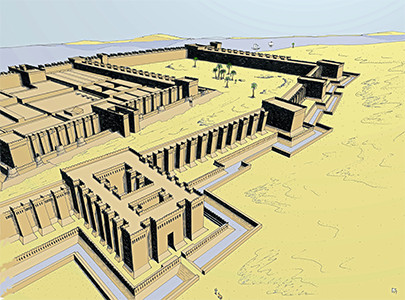
Thirteenth Dynasty: 1 803 BC - 1 639 BC
The Buhen Fortress
Buhen was an ancient Egyptian settlement situated on the West bank of the Nile below (to the North of) the Second Cataract. On the East bank, across the river, was located the ancient settlement of Wadi Halfa.
Photo: Franck Monnier (Bakha)
Permission: GNU Free Documentation License
Text: Wikipedia
Egyptian Fortresses in occupied NubiaText above: Poster at the British Museum, © Trustees of the British Museum, CC BY-NC-SA 4.0
The series of fortresses built by the 12th Dynasty conquerors of Lower Nubia stretched from Elephantine to the new southern frontier at Semna. They include some of the most sophisticated examples of military architecture known from the ancient world. The mud brick fortresses were situated on the banks and islands of the Nile. No two were identical but standard features included defensive ditches, ramparts, bastions and massive gates with wooden drawbridges. Within the walls stood barracks, work- shops, administrative quarters and temples.
Egyptian troops were stationed in the fortresses as garrisons. Their role was to control the movements of the local population and to protect the annexed territory against possible attack. The fortresses also functioned as bases for gold mining and copper smelting operations and were collection points for trade goods and raw materials. When Egypt lost control over Lower Nubia during the 13th Dynasty, most of the forts were abandoned. A few were captured by Kushites, Nubians from Kerma, when they advanced from Upper Nubia to take over the lands vacated by the Egyptians.
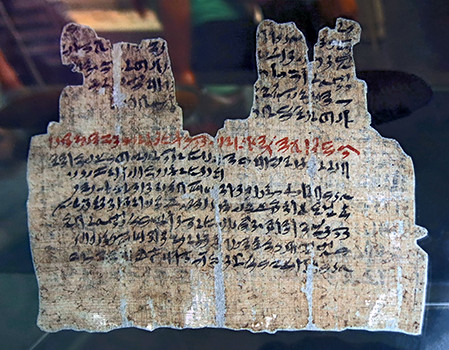
Thirteenth Dynasty: 1 803 BC - 1 639 BC
The Semna Despatches
Circa 1 780 BC.
The Semna Despatches are part of a hieratic papyrus containing copies of reports by the commanders of Egyptian forts in Lower Nubia, sent to an official at Thebes. It reports the tracking by garrison troops of a group of thirty two Nubians and three asses.
From the Ramesseum, Thebes.
Catalog: EA10752, EA10753
Photo: Don Hitchcock 2015
Source: Original, British Museum
Text: Card at the British Museum, © Trustees of the British Museum, CC BY-NC-SA 4.0
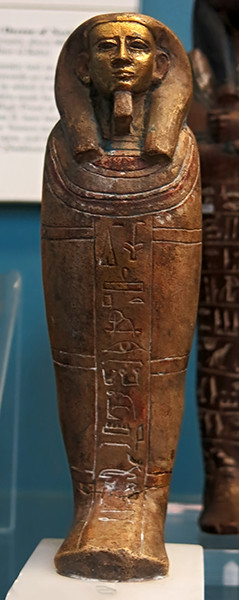
Thirteenth Dynasty: 1 803 BC - 1 639 BC
Shabti of Amun Iwy
Gilded steatite shabti of the priest of Amun Iwy.
Circa 1 795 - 1 650 BC
From Abydos
Photo: Don Hitchcock 2015
Source: Original, British Museum
Text: © Card at the Museum, http://www.britishmuseum.org/research/ © Trustees of the British Museum, CC BY-NC-SA 4.0,

Thirteenth Dynasty: 1 803 BC - 1 639 BC
Pharaoh Sebekhotep I
Part of a chapel constructed by Sebekhotep I.
Circa 1770 BC.
The text makes an allusion to the myth of the eye of Horus.
Height 110 cm, width 32 cm, thickness 26 cm.
Catalog: limestone, Abydos, Sully Rez-de-chaussée Le temple Salle 12, C9, C10.
Photo: Don Hitchcock 2015
Source: Original, Musée du Louvre
Text: © Musée du Louvre

Thirteenth Dynasty: 1 803 BC - 1 639 BC
Pharaoh Amenemhat V
Head of a statue of Pharaoh Amenemhat V (?) with a khat headdress.
Second interim period around 1750 BC.
Catalog: ÄS 7172
Photo: Don Hitchcock 2018
Source: Original, Ägyptischen Museum München
Text: © Ägyptischen Museum München
Additional text: Wikipedia

Thirteenth Dynasty: 1 803 BC - 1 639 BC
Pharaoh Amenemhat V
Head of a statue of Sekhemkare Amenemhat V of Egypt's 13th dynasty, in green slate, from Elephantine.
Upper part now in Vienna, Kunshistorisches Museum, 37, and lower part in Aswan, Aswan Museum, 1318
Photo and text: https://www.khm.at/
Source: Original, Kunsthistorisches Museum Wien
Additional text: Wikipedia
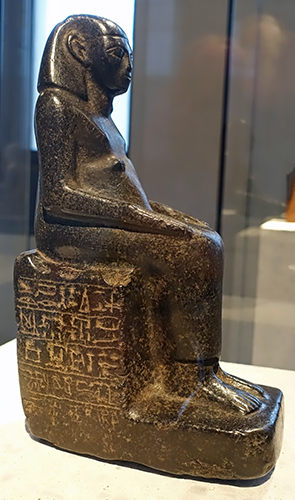
Thirteenth Dynasty: 1 803 BC - 1 639 BC
Hori
Seated figure of the governor Hori with inscription of a prayer to Ptah-Sokar-Osiris.
1 750 BC - 1 700 BC
Catalog: ÄM 34407
Photo: Don Hitchcock 2018
Source: Original, Staatliche Museen zu Berlin, Neues Museum, Germany
Text: © Card at the Staatliche Museen zu Berlin (CC BY-NC-SA 3.0 DE)
Thirteenth Dynasty: 1 803 BC - 1 639 BC
Neferhotep
Reconstruction of the villa of Neferhotep at Thebes, circa 1 750 BC
Neferhotep was the chief scribe of Amon in the time of Queen Aya, wife of Pharaoh Sehetepkare Intef (or of Pharaoh Imyremeshaw). His villa is depicted in his tomb on the Theban west bank. The residence itself has a central reception hall with a raised roof, surrounded by private quarters. Surrounding the house are gardens, stables, workshops and grain silos. The whole is surrounded by a high outer wall.
Neferhotep is the author of the Papyrus Boulaq 18, which is an ancient Egyptian administrative document. It contains an account of the Theban palace dating to the 13th Dynasty (around 1 750 BC). The papyrus lists the palace officials and the rations they received day by day. Important officials mentioned are, for example, the vizier Ankhu, but also the queen Aya. Therefore, the document is of great historical importance. It also reports the journey of the king to the temple at Medamud and reports the arrival of a delegation of Nubians.
Reconstruction: G.J.M. Bonneke, Wijchen.
Photo: Don Hitchcock 2014
Source and text: Original, Rijksmuseum van Oudheden, National Museum of Antiquities, Leiden
Additional text: Wikipedia
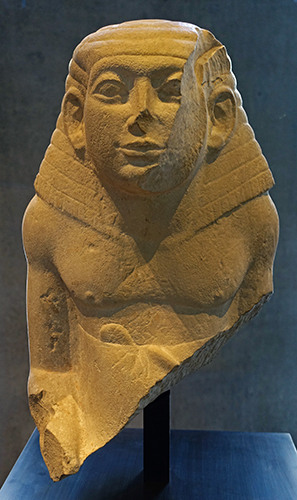
Thirteenth Dynasty: 1 803 BC - 1 639 BC
Figure
Upper part of a squatting figure.
Limestone, circa 1 750 BC.
Catalog: ÄS 4869
Photo: Don Hitchcock 2015, 2018
Source: Original, Ägyptischen Museum München
Text: © Ägyptischen Museum München
Thirteenth Dynasty: 1 803 BC - 1 639 BC
Figure
Standing-striding figure of a man wearing a long kilt.
Basalt, circa 1 750 BC.
Catalog: Gl. 14
Photo: Don Hitchcock 2015, 2018
Source: Original, Ägyptischen Museum München
Text: © Ägyptischen Museum München
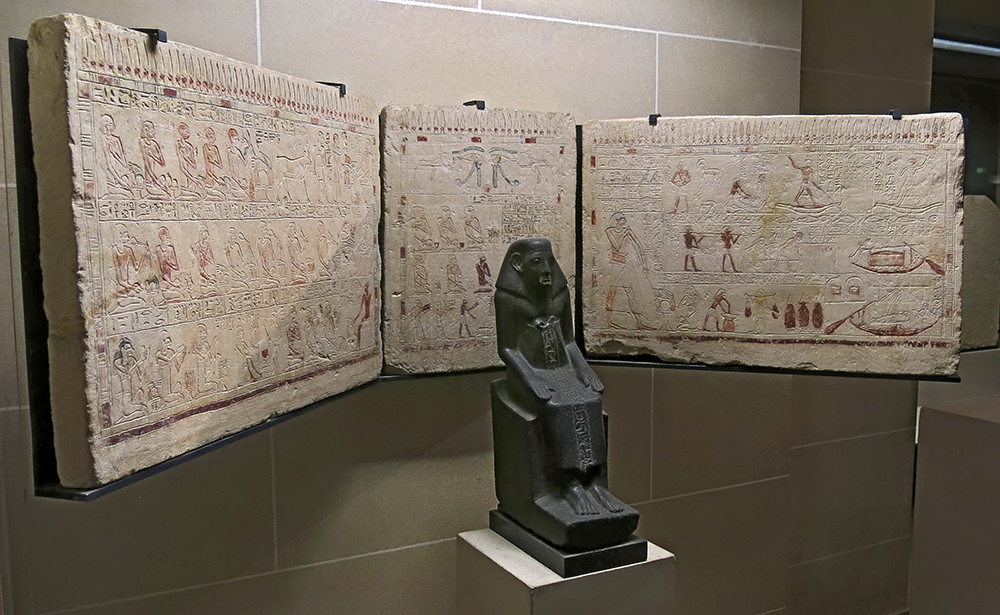
Chapel and statue of Senwosret / Senusret, Thirteenth Dynasty
Limestone and gabbro.
Photo: Don Hitchcock 2015
Source: Original, Musée du Louvre
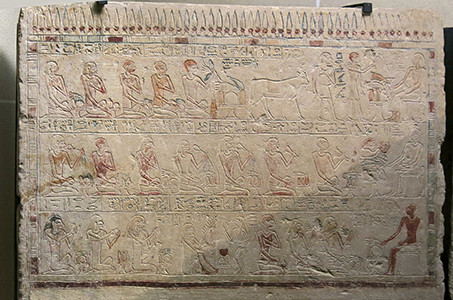

Thirteenth Dynasty: 1 803 BC - 1 639 BC
Chapel of Senwosret / Senusret / Sénouseret
Chapel of Senwosret, servant of the vizier. Circa 1780 -1700 BC 13th Dynasty
Reduced chapel model, decorated as were tombs of individuals in the Old Kingdom, (2700 - 2200 BC)
Dimensions of the centre panel are 54 cm x 44 cm, and it features the motif of protective eyes flanked by the jackal god Wepwawet. Below, Senwosret receives offerings from family members and servants.

C 17, left hand panel: Meeting in honour of Senwosret / Senusret / Sénouseret: distracted by musicians and dancers, the guests drink and breathe the fragrance of flowers. Above, Senwosret / Senusret / Sénouseret receives food offerings, amongst which is a live ox.
C 16, centre panel: At the bottom, after the party. An offering formula promises to Senwosret / Senusret the food 'which heaven gives, which the earth produces and which the gods make live.'
C 18, right hand panel: Above, a hunter followed by two gazelles carries a small one in his arms. An ox is slaughtered. In the marshes, Senwosret harpoons fish and hunts birds with a throwing stick. In the middle, harvesting and transporting grain. Below, Senwosret and his wife supervise the work of the fields, the brewer of beer, the jars and the silos. To the right, the coffin is transported by water.
Catalog: Sully Rez-de-chaussée Crypte d'Osiris Salle 13 Vitrine 10: La chapelle d'un particulier à Abydos, C 16,
C 17, C 18
Photo: Don Hitchcock 2015
Source: Original, Musée du Louvre
Text: © Musée du Louvre, http://metmuseum.org/
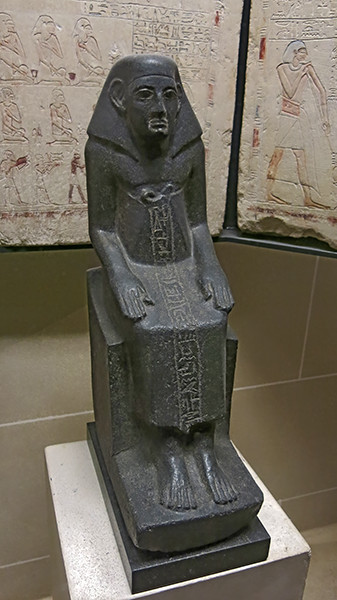
Thirteenth Dynasty: 1 803 BC - 1 639 BC
Statue of Senwosret / Senusret / Sénouseret
Servant of the Vizier, height 532 mm, width 165 mm, depth 282 mm
Made of Gabbro, found in the interior of the chapel.
Catalog: Sully Rez-de-chaussée Crypte d'Osiris Salle 13 Vitrine 10: La chapelle d'un particulier à Abydos, A48
Photo: Don Hitchcock 2015
Source: Original, Musée du Louvre
Text: © Musée du Louvre, http://metmuseum.org/

Thirteenth Dynasty: 1 803 BC - 1 639 BC
Sobekhotep V
Kneeling figure of Sobekhotep V with ointment vessels.
Circa 1 750 BC - 1 700 BC
Khahotepre Sobekhotep VI (also known as Sobekhotep V) was an Egyptian king of the 13th Dynasty during the Second Intermediate Period. According to egyptologist Kim Ryholt he was the thirty-first pharaoh of the dynasty, while Darrell Baker believes instead that he was its thirtieth ruler. Alternatively, Jürgen von Beckerath and Detlef Franke see him as the twenty-fifth king of the dynasty.
Catalog: Granite, ÄM 10645
Photo: Don Hitchcock 2018
Source: Original, Staatliche Museen zu Berlin, Neues Museum, Germany
Text: © Card at the Staatliche Museen zu Berlin
Additional text: Wikipedia
Thirteenth Dynasty: 1 803 BC - 1 639 BC
Khety
Seated figure of Khety.
Circa 1 700 BC.
Catalog: Limestone, ÄS 7903
Photo: Don Hitchcock 2015, 2018
Source: Original, Ägyptischen Museum München
Text: © Ägyptischen Museum München

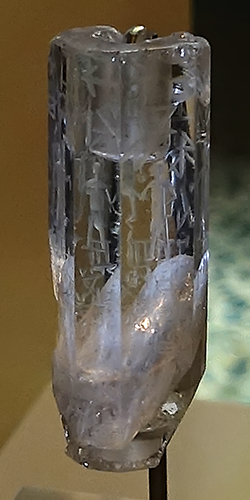
Thirteenth - Fifteenth Dynasty: 1 803 BC - 1 550 BC
Circa 1 700 BC - 1 601 BC
Hexagonal prism of rock crystal with hieroglyphs.
Catalog: ÄM 4424
Photo: Don Hitchcock 2018
Source: Original, Staatliche Museen zu Berlin, Neues Museum, Germany
Text: © Card at the Staatliche Museen zu Berlin
The Fourteenth Dynasty
1 725 BC - 1 650 BC
The Fourteenth Dynasty ruled from Avaris in the Nile Delta over Middle and Upper Egypt, contemporaneously with the Thirteenth Dynasty, which ruled from Memphis, over Middle and Upper Egypt,
The following is a truncated list from that in Wikipedia. The names of the kings and their dates of rule are not known with any certainty.
| Fourteenth Dynasty | ||
|---|---|---|
| Name | Dates | Comments |
| Yakbim Skehaenre | 1 805 BC - 1 780 BC or after 1 650 BC | Chronological position is contested, may be a vassal of the 15th Dynasty |
| Ya'ammu Nubwoserre | 1 780 BC - 1 770 BC | Chronological position is contested |
| Qareh Khawoserre | 1 770 BC - 1 760 BC | Chronological position is contested |
| 'Ammu Ahotepre | 1 760 BC - 1 745 BC or after 1 650 BC | Chronological position is contested, may be a vassal of the 15th Dynasty |
| Sheshi Maaibre | 1 745 BC - 1 705 BC or after 1 650 BC | Attested by over 300 scarab-seals, possibly married to Queen Tati who was a Kushite. Chronological position is contested, may be a vassal of the 15th Dynasty |
| Nehesy Aasehre | 1 705 BC | Best attested king of the Dynasty, he left his name on two monuments at Avaris. His name means 'The Nubian' |
| Khakherewre | 1 705 BC | |
| Nebefawre | 1 704 BC | Turin Canon: reigned 1 year, 5 months, 15 days |
| Sehebre | Turin Canon: reigned 3 years | |
| Merdjefare | ending 1 699 BC | Attested by a single stela from Saft el-Hinna, in the delta |
| Sewadjkare III | Turin Canon: reigned 1 year | |
| Nebdjefare | ending 1 694 BC | |
| ...webenre | ending 1 690 BC | |
| Truncated, lack of reliable data | ||
| Nebsenre | Attested by a jar bearing his prenomen. At least 5 months of reign | |
| Truncated, lack of reliable data | ||
| Sekheperenre | With Nehesy, Nebsenre and Merdjefare, only undisputed king known from contemporary sources. |
|
| Truncated, lack of reliable data | ||
| Babnum ...kare | ||
| Truncated, lack of reliable data | ||
| Apophis I | ||
| Truncated, lack of reliable data | ||
The Fifteenth Dynasty
1 650 BC - 1 550 BC
The Fifteenth Dynasty of Egypt was the first Hyksos dynasty, ruled from Avaris, without control of the entire land. The Hyksos preferred to stay in northern Egypt since they infiltrated from the north-east. The names and order of kings is uncertain. The Turin King list indicates that there were six Hyksos kings, with an obscure Khamudi listed as the final king of the Fifteenth Dynasty. Only five are listed here.
Hyksos, Hekau Khasut, 'ruler(s) of foreign lands' is a term which, in modern Egyptology, designates the kings of the Fifteenth Dynasty of Egypt. The seat of power of these kings was the city of Avaris in the Nile delta, from where they ruled over Lower and Middle Egypt up to Cusae. In the Aegyptiaca, a history of Egypt written by the Graeco-Egyptian priest and historian Manetho in the 3rd century BC, the term Hyksos is used ethnically to designate people of probable West Semitic, Levantine origin. While Manetho portrayed the Hyksos as invaders and oppressors, this interpretation is questioned in modern Egyptology. Instead, Hyksos rule might have been preceded by groups of Canaanite peoples who gradually settled in the Nile delta from the end of the Twelfth Dynasty onwards and who may have seceded from the crumbling and unstable Egyptian control at some point during the Thirteenth Dynasty.
The Hyksos period marks the first in which Egypt was ruled by foreign rulers. Many details of their rule, such as the true extent of their kingdom and even the names and order of their kings, remain uncertain. The Hyksos practiced many Levantine or Canaanite customs, but also many Egyptian customs. They have been credited with introducing several technological innovations to Egypt, such as the horse and chariot, as well as the sickle sword and the composite bow, but this theory is disputed.
The Hyksos did not control all of Egypt. Instead, they coexisted with the Sixteenth and Seventeenth Dynasties, which were based in Thebes. Warfare between the Hyksos and the pharaohs of the late Seventeenth Dynasty eventually culminated in the defeat of the Hyksos by Ahmose I, who founded the Eighteenth Dynasty of Egypt. In the following centuries, the Egyptians would portray the Hyksos as bloodthirsty and oppressive foreign rulers.
Text above adapted from Wikipedia.
| Fifteenth Dynasty | ||
|---|---|---|
| Name | Dates | Comments |
| Salitis | 1 650 BC - | |
| Sakir-Har | Named as an early Hyksos king on a doorjamb found at Avaris. Regnal order uncertain. | |
| Khyan | ||
| Apophis | 1 590 BC - 1 550 BC | |
| Khamudi | 1 550 BC - 1 540 BC | |
The Fifteenth Dynasty: 1 650 BC - 1 550 BC
Hyksos
A man described as 'Abisha the Hyksos', leading a group of Aamu (Western Asiatic foreigners). This is one of the earliest known uses of the term 'Hyksos'.
This painting is part of a much larger work depicting part of a foreign delegation in the tomb of Khnumhotep II, circa 1 900 BC.
Catalog: Painting on the wall of the rock-cut tomb of Khnumhotep II.
Photo: Benihassan Project
Permission: Public Domain
Source: Macquarie University
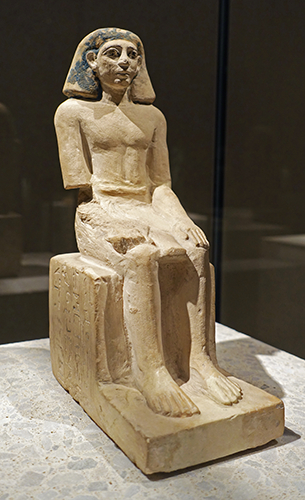
The Fifteenth Dynasty: 1 650 BC - 1 550 BC
Sebeknihotep
Seated figure of Sebeknihotep.
Circa 1640 - 1600 BC (on the card at the museum)
( note that since the location is unknown, this sculpture could just as easily be assigned to the contemporaneous Sixteenth Dynasty. Note also that the online catalog at https://smb.museum-digital.de assigns this piece to the 12th Dynasty, on stylistic grounds - Don )
This roughly hewn seated statuette shows a man sitting on a stool, dressed in a three-part apron and with his hands stretched flat on his knees. Part of the base plate and three toes of the left foot of the statuette have been repaired in modern times. The man's right arm is no longer preserved above the elbow up to the palm. The face of the subject is dominated by large, almond-shaped eyes that stand out due to their black design and are delimited above by brow arches, which are also black.
The nose flares out in broad wings, whereas the mouth is rather narrow and not emphasised. The face is framed by a shoulder-length, smooth hairstyle, which is painted blue. We can note also the oversized ears that are so characteristic of the Middle Kingdom.
On the right side of the stool is a four-column hieroglyphic inscription that was filled with blue paint and contains a formula for sacrifice. In it, the sitter asks the 'great god' to make a sacrifice of bread, beer, beef and poultry for his continued existence in the hereafter. The text also mentions the man's name 'Sobeknihotep'.
The statuette was donated to the museum. The exact place of origin and the context of the find are unknown. However, based on the inscription and other comparative examples, it can be assumed that the statuette was placed in a private grave. The eyes, which appear very large, are typical for the beginning of the 12th dynasty and thus to the beginning of the Middle Kingdom, since these are a characteristic of the First Intermediate Period. In terms of craftsmanship, due to the coarser surface treatment and simpler design, this object was produced in a provincial workshop.
(Jessica Jancziak)
Height x width x depth 270 x 95 x 160 mm, weight 2.86 kg.
Catalog: Painted limestone, ÄM 12546
Photo: Don Hitchcock 2018
Source: Original, Staatliche Museen zu Berlin, Neues Museum, Germany
Text: © Card at the Staatliche Museen zu Berlin, https://smb.museum-digital.de, (CC BY-NC-SA 3.0 DE)

The Fifteenth Dynasty: 1 650 BC - 1 550 BC
Senet-iatju
Seated figure of Senet-iatju.
Circa 1 600 BC.
Catalog: Limestone, ÄS 7122
Photo: Don Hitchcock 2015
Source: Original, Ägyptischen Museum München
Text: © Ägyptischen Museum München
The Fifteenth Dynasty: 1 650 BC - 1 550 BC
Daggers
Bronze daggers with gilding, and using ebony and ivory.
Catalog: Bronze, ebony, ivory, gilding, Inv. Nr. 1935.200.96
Photo: Don Hitchcock 2018
Source and text: Original, Museum August Kestner, Hannover
The Sixteenth Dynasty: 1 649 BC - 1 582 BC
The Sixteenth Dynasty of ancient Egypt (notated Dynasty XVI) was a dynasty of pharaohs that ruled the Theban region in Upper Egypt for 70 years.
The continuing war against Dynasty XV dominated the short-lived 16th dynasty. The armies of the 15th dynasty, winning town after town from their southern enemies, continually encroached on the 16th dynasty territory, eventually threatening and then conquering Thebes itself. In his study of the second intermediate period, the egyptologist Kim Ryholt has suggested that Dedumose I sued for a truce in the latter years of the dynasty, but one of his predecessors, Nebiryraw I, may have been more successful and seems to have enjoyed a period of peace in his reign.
Famine, which had plagued Upper Egypt during late 13th Dynasty and the 14th Dynasty, also blighted the 16th Dynasty, most evidently during and after the reign of Neferhotep III.
| Sixteenth Dynasty | |||
|---|---|---|---|
| Name | Years | Dates | Comments |
| Unknown | 1 | 1 649 BC - 1 648 BC | Name lost in a lacuna of the Turin canon |
| Sekhemre-sementawi Djehuti | 3 | 1 648 BC - 1 645 BC | |
| Sekhemre-seusertawi Sobekhotep VIII | 16 | 1 645 BC - 1 629 BC | |
| Sekhemre-seankhtawi Neferhotep III | 1 | 1 629 BC - 1 628 BC | |
| Seankhenre Mentuhotepi | 1 | 1 628 BC - 1 627 BC | |
| Sewadjenre Nebiryraw I | 26 | 1 627 BC - 1 601 BC | |
| Nebiriau II | 1 | 1 601 BC | |
| Semenre | 1 | 1 601 BC - 1 600 BC | |
| Seuserenre Bebiankh | 2 | 1 600 BC - 1 588 BC | |
| Sekhemre Shedwaset | 1 | 1 588 BC | |
| Unknown | 6 | 1 588 BC - 1 582 BC | Five kings lost in a lacuna of the Turin Canon. |
Additional kings are classified as belonging to this dynasty per Kim Ryholt but their chronological position is uncertain. They may correspond to the last five lost kings on the Turin canon:
| Additional Kings of the Sixteenth Dynasty | ||
|---|---|---|
| Name | Dates | Comments |
| Djedhotepre Dedumose I | May have tried to sue the Hyksos for peace. | |
| Djedneferre Dedumose II | ||
| Djedankhre Montemsaf | ||
| Merankhre Mentuhotep VI | ||
| Seneferibre Senusret IV | Left a colossal statue of himself in Karnak. | |
Sixteenth Dynasty: 1 649 BC - 1 582 BC
Royal Diadem
Egyptian royal jewellery is extremely rare. This diadem displays two cobras rather than one, which suggests that it belonged to a queen. It is most probably from the burial of Queen Montuhotep, the wife of King Djehuty, in Thebes.
The burial was found intact by locals between 1822 and 1825. The queen's body and coffin are now lost, but copies of the coffin's decoration were made in 1832 and are now in the British Museum and the Bodleian Library, Oxford.
Silver was so rare that it was deemed more valuable than gold. The cobras are made of silver with a higher gold and copper content than the rest of the diadem. The basketwork design on the headband was worked by displacing the metal (chasing). The details on the cobras and streamers are early examples of metal engraving.
Catalog: Circa the start of the 16th Dynasty, probably from Western Thebes, cemetery of Dra Abu el-Naga. al-Sabah Collection, 2017, AESLoan.1
Photo: Don Hitchcock 2018
Source: Original, British Museum
Text: Card at the Museum, © Trustees of the British Museum, CC BY-NC-SA 4.0
Second Intermediate Period: 1 700 BC - 1 550 BC
Beads
Sixteenth Dynasty?
String of blue glazed (bl.gl.) beads: cylinders between amulets with a pair of string holes - alternative Tauret/Taweret and crocodile, (exactly like 28408), from a large basket.
Taweret was portrayed as a bipedal hippopotamus with limbs like those of a feline.
From Sedment, Mayana, Cemetery K, Tomb 1288, of an old woman, Accession Number LDUCE-UC28410
Photo: Don Hitchcock 2018
Photo: Don Hitchcock 2015
Source: Original, Petrie Museum, London, England
Text: Card / online catalogue, the Petrie Museum, © 2015 UCL. CC BY-NC-SA license
Second Intermediate Period: 1 700 BC - 1 550 BC
Beads
String of beads: five black faience ring beads, thirty six large carnelian barrel beads (several chipped), two feathered carnelian barrel beads, one large, one small and two very large carnelian barrel beads.
Length 550 mm, largest bead length 30 mm.
From Abydos, West of Shuneh el Zebib, tomb 830, cemetery over Early Dynastic cemetery, Accession Number LDUCE-UC43128
Photo: Don Hitchcock 2018
Photo: Don Hitchcock 2015
Source: Original, Petrie Museum, London, England
Text: Card / online catalogue, the Petrie Museum, © 2015 UCL. CC BY-NC-SA license
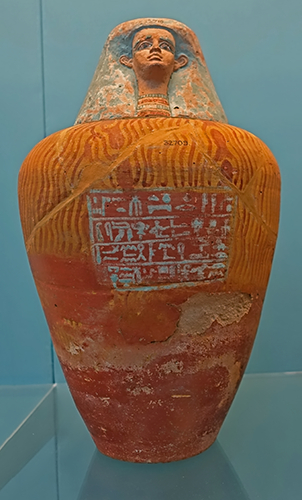
Sixteenth Dynasty: 1 649 BC - 1 582 BC
Painted pottery Canopic jar of Senebhenaef.
The body of the pottery canopic jar has been painted to imitate wood, and there is a panel of Hieroglyphic text.
Height 280 mm.
Catalog: Painted ceramic, Abydos, EA32709, EA32710
Photo: Don Hitchcock 2018
Source: Original, British Museum
Text: Card with the display at the British Museum, https://www.britishmuseum.org/, © Trustees of the British Museum, CC BY-NC-SA 4.0
Sixteenth Dynasty - Eighteenth Dynasty, 1 649 BC - 1 292 BC
Faience lidded box
The god Thot 'Lord of Hermopolis', honoured by a scribe of the harem.
Circa 1 600 BC - 1 500 BC.
Height 155 mm, diameter 119 mm.
( on the left hand image we can see more clearly the lotus flower decoration on the lid, and the probability that it originally had a wooden bead or similar attached as a handle for the lid. - Don )
Catalog: Sully, Rez-de-chaussée, L'écriture et les scribes, Salle 335, Vitrine 5 : Les dieux qui patronnent l'écriture. Faience, E 3610
Photo: Don Hitchcock 2018
Source and text: Original, Louvre Museum, Paris, France
Additional text: http://cartelfr.louvre.fr/cartelfr/visite?srv=car_not_frame&idNotice=3391&langue=fr
The Seventeenth Dynasty
1 580 BC - 1 550 BC
The Seventeenth Dynasty's mainly Theban rulers are contemporary with the Hyksos of the Fifteenth Dynasty of Egypt and succeed the Sixteenth Dynasty, also based in Thebes. In March 2012, French archeologists examining a limestone door in the Amun-Ra temple in Luxor discovered hieroglyphs with the name Senakhtenre, the first evidence of this king dating to his lifetime.
King Nebmaatre may have been a ruler of the early 17th dynasty.
The last two kings of the dynasty opposed the Hyksos rule over Egypt and initiated a war that would rid Egypt of the Hyksos kings and began a period of unified rule, the New Kingdom.
Kamose, the second son of Seqenenre Tao and last king of the Seventeenth Dynasty, was the brother of Ahmose I – the first king of the Eighteenth Dynasty, also identified as Ahmose II.
| Seventeenth Dynasty | ||||||
|---|---|---|---|---|---|---|
| Name | Horus (Throne) Name | Consort | Burial | Years | Dates | Comments |
| Rahotep | Sekhemre-wahkhaw | 1 | circa 1 585 BC | |||
| Sobekemsaf I | Sekhemre-wadjkhaw | Nubemhat | 7 | |||
| Sobekemsaf II | Sekhemre-shedtawy | Nubkhaes | Robbed during the reign of Ramesses IX | |||
| Intef / Antef | Sekhemre-wepmaat | Dra' Abu el-Naga'? | ||||
| Intef / Antef VI | Nubkheperre | Sobekemsaf | Dra' Abu el-Naga' | |||
| Intef / Antef VII | Sekhemre-heruhermaat | Haankhes | Dra' Abu el-Naga' | |||
| Ahmose (Ahmose I) | Senakhtenre | Tetisheri | 1 | |||
| Tao | Seqenenre | Ahmose Inhapy Sitdjehuti Ahhotep I |
4 | circa 1 560 BC | ||
| Kamose | Wadjkheperre | Ahhotep II? | 5 | 1 555 BC - 1 550 BC | ||
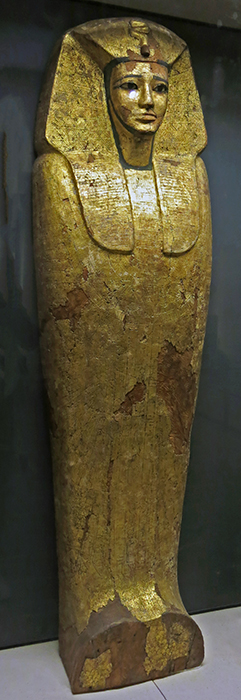
Seventeenth Dynasty: 1 580 BC - 1 550 BC
King Intef / Antef, (Sekhemre-wepmaat)
Also recorded as Sekhemre-Oupmaat Antef-Âa
Rishi type coffin, i.e. adorned with a feather design.
Intef is shown wearing Nemes, which were a striped headcloth worn by pharaohs. It covered the whole crown and back of the head and nape of the neck (sometimes also extending a little way down the back) and had lappets, two large flaps which hung down behind the ears and in front of both shoulders.
Decorations include the Ouadjet (cobra), and Nekhbet (vulture, spread wings), and Ousekh / Usekh (necklace)
Height 2000 mm, width 570 mm.
This king's brother Nubkheperre Intef buried – and thus succeeded – him.
The Pyramidion from his pyramid was found at Dra' Abu el-Naga', and is preserved at the British Museum, EA478.
Catalog: Wood, alabaster, obsidian, inlaid, painted, gilded, Dra Aboul el-Naga, West Thebes, Aile Sully, Room 323, Crypt of Osiris, Vitrine 2, E 3019, N 712
Photo: Don Hitchcock 2015
Source and text: Original, Louvre Museum, Paris, France, https://collections.louvre.fr/
Additional text: Wikipedia
Seventeenth Dynasty: 1 580 BC - 1 550 BC
King Intef / Antef, (Sekhemre-wepmaat)
Beneath the beautifully completed gilded exterior of this portrait of King Antef, the sculptor has conveyed a feeling of ineffable sadness in the facial expression of the king.
As Shakespeare wrote in King Henry the Fourth Part 2, 'Uneasy lies the head that wears a crown'.
Catalog: Wood, alabaster, obsidian, inlaid, painted, gilded, Dra Aboul el-Naga, West Thebes, Aile Sully, Room 323, Crypt of Osiris, Vitrine 2, E 3019, N 712
Photo: Don Hitchcock 2015
Source: Original, Louvre Museum, Paris, France, https://collections.louvre.fr/
Text: Don Hitchcock 2021
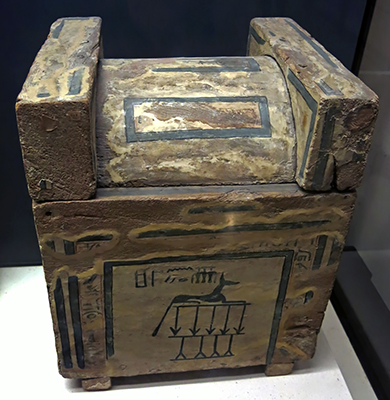
Seventeenth Dynasty: 1 580 BC - 1 550 BC
King Intef / Antef, Canopic Chest
Canopic chest of King Intef / Antef, (Sekhemre-wepmaat).
Square canopic chest with domed lid.
Decoration: Anubis, on all four sides.
Height 480 mm, length 385 mm, width 345 mm.
Catalog: Painted wood, Dra Aboul el-Naga, West Thebes, Aile Sully, Room 323, Crypt of Osiris, Vitrine 2, E 2538, N 491, Clot bey C 29 no. 1
Photo: Don Hitchcock 2015
Source and text: Original, Louvre Museum, Paris, France, https://collections.louvre.fr/
Seventeenth Dynasty: 1 580 BC - 1 550 BC
King Intef / King Antef Nubkheperre / King Antef VI
King Intef Nubkheperre (there were three kings with the name Intef in this dynasty) was an Egyptian king of the Seventeenth dynasty of Egypt at Thebes / Luxor during the Second Intermediate Period, from 1582 BC to 1570 BC when Egypt was divided by rival dynasties including the Hyksos in Lower Egypt.
This is a sycomore fig wood Rishi anthropoid coffin of King Antef VI. Rishi coffins are funerary coffins adorned with a feather design. The lid of the coffin is covered with gold leaf on a base of gesso. The king is represented wearing a royal headcloth (nemes) of unusually large proportions. A uraeus serpent was originally attached to the brow, but it is now missing and only the socket is visible. A false beard, originally fitted to the chin, is also lost, although the painted beard-straps survive on each side of the face.
The king's mummified body is covered with a feather design (rishi in Arabic) symbolising the protective wings of the funerary goddesses Isis and Nephthys.
The face itself was originally gilded, and the eyes are made from black and white stone. On the upper body is a collar with falcon-head terminals, and a winged figure (now mostly destroyed) occupied the middle of the breast. The sides of the headdress and most of the body of the coffin-lid are covered with a design of stylised feathers, although the areas at the sides of the feet have a different motif, consisting of spherical and barrel shaped beads arranged in a net-pattern.
Catalog: EA6652
Photo: Don Hitchcock 2015, 2018
Source: Original, British Museum
Text: http://www.britishmuseum.org/research/, © Trustees of the British Museum, CC BY-NC-SA 4.0
Additional text: Wikipedia
In the centre of the lid, from the collar to the level of the ankles is a single line of hieroglyphic text. The exterior of the coffin-case is painted a uniform blue and bears no decoration apart from a stylised representation of the queue of the king's wig in the centre of the back. On the base of the foot are figures of the goddesses Isis and Nephthys raising their hands in a gesture of lamentation.
A column of inscription between them contains their speech. The interior surfaces of both lid and case are thickly coated with a dark, shiny resinous substance. The mummy was apparently placed inside the coffin before this substance was dry, as substantial portions of the outer linen wrappings adhere to the inner surface of the case.
Some of these fragments of the linen shroud bear funerary texts on behalf of King Intef, written in black ink (other sections, removed from the coffin in the 19th century, are EA10706). Several insects, identified as Dermestes beetles, are also visible, having become trapped in the sticky coating of the interior.
Among the inscriptions on the coffin is the hieroglyphic sign for an owl ('m'), which has been intentionally drawn without legs - such a symbolic 'disabling' of a potentially harmful creature was a common feature of Egyptian script in the Second Intermediate Period.
Length: 1932 mm.
Catalog: EA6652
Photo: Don Hitchcock 2015, 2018
Source: Original, British Museum
Text: http://www.britishmuseum.org/research/, © Trustees of the British Museum, CC BY-NC-SA 4.0
Additional text: Wikipedia
Necklace and crown from the burial of King Intef Nubkheperre , 1635 BC.
This Ancient Egyptian 17th dynasty inlaid diadem or crown, composed of silver with gold uraeus (serpent) ( out of focus at the back of this photo - Don ), and glass or faience inlays, is traditionally associated with the burial of the 17th dynasty Theban king Nubkheperre Intef. It is today in the collection of the Leiden Museum (or Rijksmuseum van Oudheden) in the Netherlands where its registration number is No. AO. 11a.
This rare crown, 18 cm in diameter, was found in Dra' Abu el-Naga' on the West Bank of the Nile at Thebes / Luxor presumably from Intef Nubkheperre's royal tomb in the early days of Egyptology when record keeping was weak to non-existent. Nevertheless, this beautiful object was an important find from a time during the Second Intermediate Period when Egypt was divided into two between the Hyksos controlled north and the Theban dominated South.
Photo: Don Hitchcock 2014
Source: Original, Rijksmuseum van Oudheden, National Museum of Antiquities, Leiden.
Text: Wikipedia

Seventeenth Dynasty: 1 580 BC - 1 550 BC
King Antef / Intef VI
Gold ring naming King Antef / Intef VI, 17th Dynasty.
The ring is set with a scarab of lapis lazuli, a prized material that was mined in Afghanistan and reached Egypt through trade, via the Near East.
The ring is from the burial of Antef's wife, Queen Sobekemsaf. She was not buried close to her husband in Thebes, but near her blood relatives in the provincial town of Edfu. Her paternal line held the local governorship.
( thus we can deduce that the king identified on the museum card as Intef VI is also known as King Intef Nubkheperre, whose wife is listed as Sobekemsaf, and whose coffin is shown above - Don )
Catalog: Gold, lapis lazuli, EA57698
Photo: Don Hitchcock 2018
Source: Original, British Museum
Text: Card at the Museum, © Trustees of the British Museum, CC BY-NC-SA 4.0
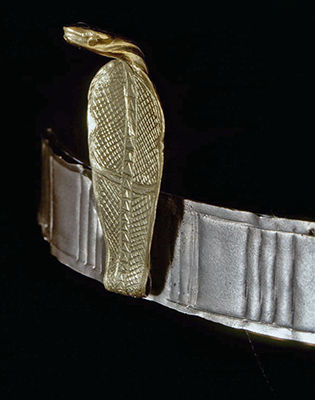
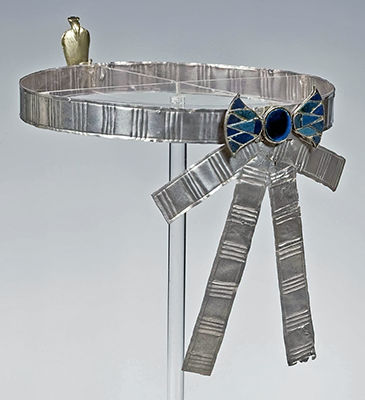
Uraeus (serpent), gold, associated with the crown above, and shown here attached to it.
Photo: © http://www.rmo.nl/collectie/zoeken?object=AO+11a-2
Source: Original, Rijksmuseum van Oudheden, National Museum of Antiquities, Leiden.

Seventeenth Dynasty: 1 580 BC - 1 550 BC
King Antef / Intef VII, (Sekhemre Heruhermaat)
Coffin lid, Rishi type coffin, i.e. adorned with a feather design.
Under the feet are decorations of Isis and Nephthys kneeling, adoring.
Intef VII is shown wearing Nemes, which were a striped headcloth worn by pharaohs. It covered the whole crown and back of the head and nape of the neck (sometimes also extending a little way down the back) and had lappets, two large flaps which hung down behind the ears and in front of both shoulders.
Height 1885 mm, width 480 mm.
Catalog: Wood, inlaid, painted, stuccoed, Dra Aboul el-Naga, West Thebes, Aile Sully, Room 323, Crypt of Osiris, Vitrine 2, E 3020, N 711
Photo: Don Hitchcock 2015
Source and text: Original, Louvre Museum, Paris, France, https://collections.louvre.fr/
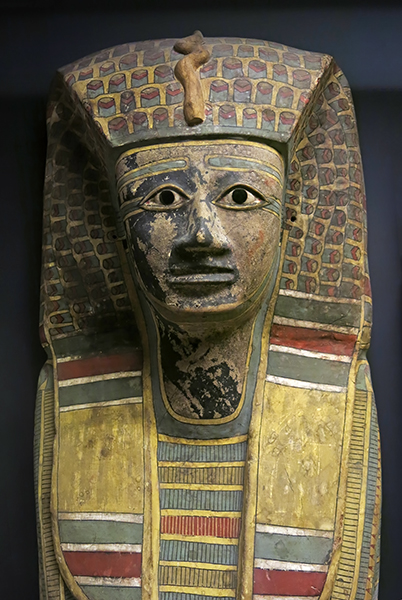
Seventeenth Dynasty: 1 580 BC - 1 550 BC
King Antef / Intef VII, (Sekhemre Heruhermaat)
Closeup of the coffin lid.
Height 1885 mm, width 480 mm.
Catalog: Wood, inlaid, painted, stuccoed, Dra Aboul el-Naga, West Thebes, Aile Sully, Room 323, Crypt of Osiris, Vitrine 2, E 3020, N 711
Photo: Don Hitchcock 2015
Source and text: Original, Louvre Museum, Paris, France, https://collections.louvre.fr/

Seventeenth Dynasty: 1 580 BC - 1 550 BC
King Sebekemsaf II
Green jasper and gold heart-scarab of King Sebekemsaf II, (also identified as Sobekemsaf II) 17th Dynasty, about 1590 BC.
This amulet, in the form of a scarab beetle with a human face ( inverted in this photo - Don ), was intended to ensure that the deceased passed safely through the judgement which could establish whether or not he was deserving of eternal life.
This is the earliest known heart scarab made for a king. Carved from green jasper, it is in the form of a scarab beetle, but has a human face. Heart scarabs were placed on the chest of the deceased to help them pass safely through the judgement that would decide whether or not they deserved eternal life.
The gold mount is inscribed with an early version of Chapter 30B of the Book of the Dead, the magical text intended to prevent the heart from testifying against its owner. It is carved from green jasper, set in a gold mount, and is the earliest known example of such an amulet made for a king.
The human-headed jasper scarab is inset into a cloison in a hollow sheet gold plinth with a rounded back end. The rim of the cloison itself has been inset with an undulating strip of sheet gold to give the effect of granulation.

The insect's legs, splayed out on the plinth's top, are made from individual sheet gold strips with roughly incised markings representing hairs.
The crudely formed hieroglyphs incised around the plinth, and in five horizontal rows across the underside, come from Chapter 30B of the Book of the Dead: 'Spell for preventing the heart from opposing the deceased'. In the inscription the legs of the birds are missing, a common feature in earlier magical texts to prevent them attacking the dead person.
Catalog: Western Thebes, Dra Abu el-Naga, EA7876
Photo (upper): Don Hitchcock 2015
Photo (lower, at left) © Trustees of the British Museum, CC BY-NC-SA 4.0
Source: Original, British Museum
Text: © http://www.britishmuseum.org/research/ and card at the Museum, © Trustees of the British Museum, CC BY-NC-SA 4.0

Seventeenth Dynasty: 1 580 BC - 1 550 BC
Rishi-Coffin
Coffin with a feather pattern (rishi-coffin), circa 1 600 BC.
Catalog: Wood, Dra' Abu el-Naga, ÄS 6084.
Photo: Don Hitchcock 2018
Source: Original, Ägyptischen Museum München
Text: Museum card, © Ägyptischen Museum München
Seventeenth Dynasty: 1 580 BC - 1 550 BC
Taiuy
Wooden anthropoid coffin of Taiuy.
Painted detail on plaster including rishi-pattern and hieroglyphic text.
17th - early 18th Dynasty, circa 1 550 BC - 1 500 BC. Sycomore fig coffin in the Rishi style, inscribed for the lady Taiuwy. From Birabi, Thebes / Luxor, intrusive burial in tomb 41.
This coffin was prefabricated, and the owner's name was inserted into a blank space in the central inscription. The large painted wings possibly represent those of protective godesses, or may derive from the decoration of masks of the Second Intermediate period.
In this late example of the Rishi style, the striped wig and transverse bands foreshadow the design of the classic 18th Dynasty coffins.
Catalog: EA54350
Photo (left): ©Trustees of the British Museum, CC BY-NC-SA 4.0
Photo (right): Don Hitchcock 2018
Source: Original, British Museum
Text: www.britishmuseum.org/research/ and card at the Museum, © Trustees of the British Museum, CC BY-NC-SA 4.0
Seventeenth Dynasty: 1 580 BC - 1 550 BC
Sat-Djehuti
The coffin of the King's daughter and King's sister Sat-Djehuti.
The upper part of the gilded cartonnage coffin of Sat-Djehuti (also Sitdjehuti, which means daughter of Thoth). She was a princess and a queen. Circa 1 575 BC.
Catalog: Gilded cartonnage, West Thebes, ÄS 7163
Photo: Don Hitchcock 2018
Source: Original, Ägyptischen Museum München
Text: Museum card, © Ägyptischen Museum München
Additional text: Wikipedia

Seventeenth Dynasty: 1 580 BC - 1 550 BC
Sat-Djehuti
Fragment from the coffin of the King's daughter and King's sister Sat-Djehuti
Sitdjehuti (or Satdjehuti; 'Daughter of Thoth') was a princess and queen of the late Seventeenth Dynasty of Egypt. She was a daughter of Pharaoh Senakhtenre Ahmose and Queen Tetisheri. She was the wife of her brother Seqenenre Tao and was the mother of Princess Ahmose.
Catalog: Sycomore wood, circa 1 575 BC West Thebes, ÄS 7163
Photo: Don Hitchcock 2018
Source: Original, Ägyptischen Museum München
Text: Museum card, © Ägyptischen Museum München
Additional text: Wikipedia
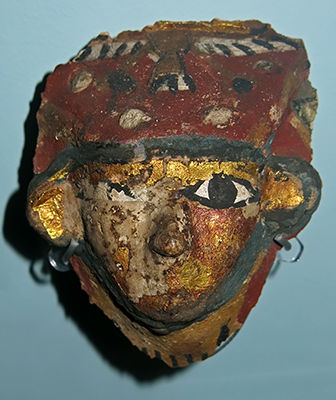
Seventeenth Dynasty: 1 580 BC - 1 550 BC
Gilded plaster mummy-mask.
17th or early 18th Dynasty, circa 1 600 BC - 1500 BC, from Rifeh.
Mummy-masks with very small faces and feathered decorations on the headdress were characteristic of the period before the beginning of the New Kingdom.
Catalog: EA69151
Photo: Don Hitchcock 2015
Source: Original, British Museum
Text: Card at the Museum, © Trustees of the British Museum, CC BY-NC-SA 4.0
References
- Adams B., Porat N. , 1996: Imported Pottery with Potmarks from Abydos, In: J. Spencer (ed.), Aspects of Early Egypt, London: British Museum Press, p. 98-107.
- Anderson W. , 1989: Badarian Burials: Possible Indicators of Social Inequality in Middle Egypt During the Fifth Millennium B.C., Department of Anthropology McGill University, Montreal April, 1989, a thesis submitted to the Faculty of Graduate Studies and Research in partial fulfilment of the requirements for the degree of Master of Arts
- Böhme I. , 2013: Die privaten Sarkophage des Neuen Reiches – ein Vorbericht, Göttinger Orientforschungen IV Ägypten 54, DAI Kairo - German Archaeological Institute Cairo, preliminary paper for a PhD thesis.
- Breasted J. , 1903: Jewellery from the Tombs of Egypt, The Biblical World, Vol. 22, No. 1 (Jul., 1903), pp. 64-66, published by The University of Chicago Press, http://www.jstor.org/stable/3140533.
- Brunton G., Caton-Thompson C., 1928: The Badarian civilization and predynastic remains near Badari, (British School of Archaeology in Egypt and Egyptian research account : thirtieth year, 1924). 1928
- Budge, E., 1912: Hieroglyphic texts from Egyptian stelae, &c., in the British Museum, Part 2, printed by order of the Trustees [by] Harrison and Sons
- Caton-Thompson E., Gardner E., 1934: The Desert Fayum, Royal Anthropological Institute of Great Britain and Ireland, London, 1934.
- Cowie S., Johnson T., 2001: The Mummy in Fact, Fiction and Film, McFarland, 3 Dec. 2001 - Performing Arts - 208 pages
- David R., 2002: The Experience of Ancient Egypt, Rutledge, 9 Sep. 2002 - Social Science - 216 pages
- Davies B., 1999: Who's who at Deir el-Medina : a Prosopographic Study of the Royal Workmen's Community, Leiden : Nederlands Instituut voor Het Nabije Oosten, 1999
- Dodson A., Hilton D., 2004: The Complete Royal Families of Ancient Egypt, The American University in Cairo Press, London 2004
- Erman A., 1894: Life in Ancient Egypt, Courier Corporation, 1894 - History - 570 pages
- Ertman E., 2013: Gesichtseinlage von König Echnaton / Amenophis IV. aus opak-blauem Glas, Auszug und Übersetzung aus Journal of Glass Studies 2013-55, S. 13-19
- Escolano-Poveda M., 2019: Egypt’s Pharaohs welcomed summer with this fabulous festival, 20/03/20. Retrieved from: https://www.nationalgeographic.com/history/magazine/2019/05-06/ancient-egypt-royal-feast/
- García J., 2013: Ancient Egyptian Administration, BRILL, 7 Jun. 2013 - Reference - 1112 pages
- Gatto M., 2001-2002: Two Predynastic pottery caches at Bir Sahara (Egyptian Western Desert), Sahara, 13: 51 - 60
- Habicht M., 2014: Semenchkare - Phantom-König von Achet-Aton: Beitrag zur Erforschung der rätselhaften Nachfolge von Echnaton,epubli, 17 Feb 2014 - Science - 96 pages
- Harer W., 1985: Pharmacological and Biological Properties of the Egyptian Lotus, Journal of the American Research Center in Egypt, Vol. 22 (1985), pp. 49-54 Published by: American Research Center in Egypt DOI: 10.2307/40000390
- Hartwig M., 2006: A Companion to Ancient Egyptian Art, John Wiley & Sons, 23 Dec. 2014 - Literary Criticism - 624 pages
- Hodel-Hoenes S., 2006: Life and Death in Ancient Egypt: Scenes from Private Tombs in New Kingdom Thebes, Cornell University Press, 2000 - Art - 329 pages
- Holmes D., 1989: The Predynastic Lithic Industries of Upper Egypt: A Comparative Study of the Lithic Traditions of Badari, Nagada and Hierakonpolis, BAR (15) 469, Volumes I and II.
- Humphreys C., Waddington G., 2017: Solar eclipse of 1207 BC helps to date pharaohs, Astronomy & Geophysics, Volume 58, Issue 5, 1 October 2017, Pages 5.39–5.42, https://doi.org/10.1093/astrogeo/atx178, Published: 01 October 2017
- Jung M., 2012a: F. Seyfried (eds.), In the Light of Amarna. 100 years of the discovery of the Nefertiti, Berlin 2012, p. 206 (cat. No. 7).
- Jung M., 2012b: in: F. Seyfried (Hrsg.), Im Licht von Amarna. 100 Jahre Fund der Nofretete, Berlin 2012, p. 332
- Kákosy L., 1995: 'The Soter Tomb in Thebes', in S.P, Vleeming (ed.), Hundred-Gated Thebes: Acts of a Colloqium on Thebes and the Theban area in the Graeco-Roman Period, Leiden: Brill, 61- 67
- Kitchen K., 1993: Ramesside inscriptions : translated and annotated Notes and comments, 1, Ramesses I, Sethos I and contemporaries (Oxford, 1993), 2-3.
- Loret V., 1889: La Tombe de Khâ-M-Hâ, in: Gaston Maspero, in: Urbain Bouriant - Victor Loret - H. Dulac (editors), Mémoires publiés par les membres de la mission archéologique française au Caire, Tome premierFasc. 1, Paris 1889, plate 1 after page 114
- Malkowski E., 2010: Before the Pharaohs: Egypt's Mysterious Prehistory, Inner Traditions / Bear & Co, Apr 12, 2010 - History - 336 pages
- Martin G., 1991: Hidden Tombs of Memphis, Thames and Hudson, London 1991
- Maspero G., 1903: History of Egypt, Chaldea, Syria, Babylonia, and Assyria, London : Grolier Society
- Math N., 2014: Die Badarikultur, Neue Untersuchungen zu einer Kultur des 5. Jahrtausends v. Chr., angestrebter akademischer Grad Master of Arts (MA) Wien, 2014
- McKerrel H., Tylecote R., 1972: The working of copper-arsenic alloys in the Early Bronze Age and the effect on the determination of provenance, Proceedings of the Prehistoric Society, 38, pp. 209–218. doi: 10.1017/S0079497X00012111.
- Mettlen J., 2012: in: F. Seyfried (Hrsg.), Im Licht von Amarna. 100 Jahre Fund der Nofretete, Berlin 2012, p. 344 (cat. No. 126).
- Meyer-Dietrich E., 2017: Auditive Räume des alten Ägypten: Die Umgestaltung einer Hörkultur in der Amarnazeit, Brill, 9 Nov. 2017, pp. 1128.
- Naville É., 1910: The XIth Dynasty temple at Deir el-Bahari, London : Egypt Exploration Fund, 1910.
- O'Connor D., Cline E., 2001: Amenhotep III: Perspectives on His Reign, University of Michigan Press, 2001 - History - 393 pages
- Patch D., Eaton-Krauss M., Allen S., 2011: Dawn of Egyptian Art, Jan 1, 2011 - Art, Ancient - 275 pages
- Pommerening, T., Marinova, E., Hendrickx, S., 2010: The Early Dynastic origin of the water-lily motif, Chronique d'Egypte, 85 (2010): 14-40
- Raven M., 1980: Papyrus-sheaths and Ptah-Sokar-Osiris Statues, RMO, 1980 - 296 pages
- Rawlinson H., 1867: The Assyrian Canon Verified by the Record of a Solar Eclipse, B.C. 763, Athenaeum, #2064 660 (18 May)
- Rawlinson G., 1886: Ancient Egypt,T. Fisher Unwin, Tenth Edition
- Riemer H., Kuper R., 2000: 'Clayton rings': enigmatic ancient pottery in the Eastern Sahara, Sahara, 12: 91-100.
- Schneider H., Raven M., 1981: De Egyptische Oudheid, Rijksmuseum van Oudheden, Leiden.
- Schneider H., Raven M., 1999: Life and Death Under the Pharaohs, Rijksmuseum van Oudheden, Leiden.
- Schoske S., Wildung D., 2013: Das Münchner Buch der Ägyptischen Kunst, München 2013
- Seyfried F., 2012: Im Licht von Amarna. 100 Jahre Fund der Nofretete, Berlin 2012, p. 322.
- Shaw I., 2000: The Oxford History of Ancient Egypt, Oxford University Press, USA, 31 Aug. 2000 - History - 528 pages
- Smith H., 2006: The Fortress of Buhen: The Inscriptions, (London, 1976), 118-19, no. 1511, pls. XXV/1, LXXIV/2-3
- Spanel D., 2001: in Redford D. (ed.), The Oxford Encyclopedia of Ancient Egypt, vol. 1, Oxford University Press, 2001
- Strudwick N., 2006: Masterpieces of Ancient Egypt, University of Texas Press, 1 Nov. 2006 - Social Science - 352 pages
- Taylor J., 1999: Studies in Egyptian antiquitie, British Museum, Occasional Paper 123 (1999)
- Taylor J., 2010: Journey Through the Afterlife: Ancient Egyptian Book of the Dead, Harvard University Press, 2010 - History - 320 pages
- Verner M., 2014: From The Pyramids, Atlantic Books Ltd, 6 Nov. 2014 - History - 300 pages
- Weber A., 2012: in: F. Seyfried (ed.) Im Licht von Amarna. 100 Jahre Fund der Nofretete, Berlin 2012, S. 226 (Kat.-Nr. 18). Atlantic Books Ltd, 6 Nov. 2014 - History - 300 pages
- Wegner E., 2012: in: F. Seyfried (Hrsg.), Im Licht von Amarna. 100 Jahre Fund der Nofretete, Berlin 2012, p. 348 (cat. No. 129).
- Wilkinson T., 2002: Early Dynastic Egypt, Routledge, 11 Sep. 2002 - Social Science - 440 pages
Back to Don's Maps
 Back to Archaeological Sites
Back to Archaeological Sites
 Back to Egypt Index Page
Back to Egypt Index Page
